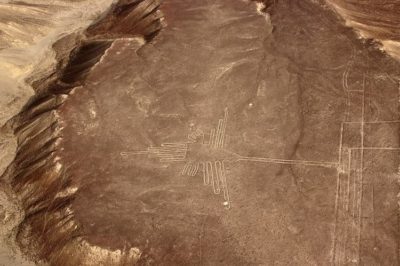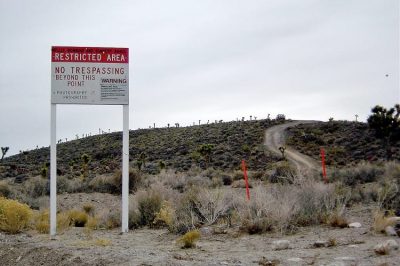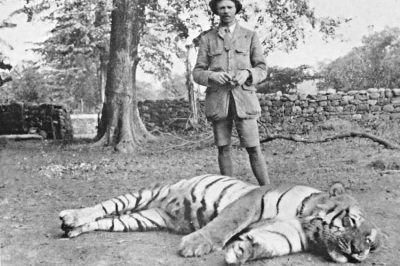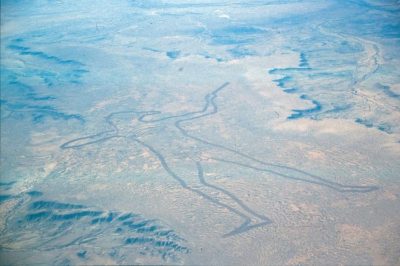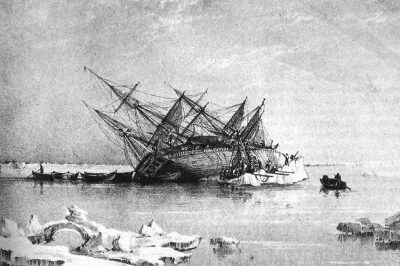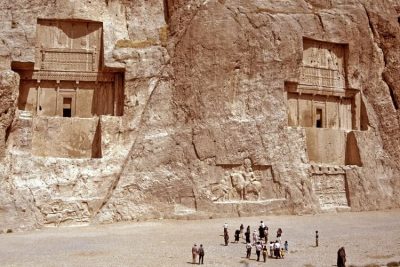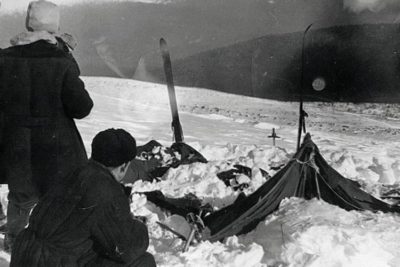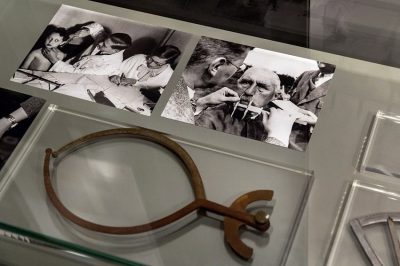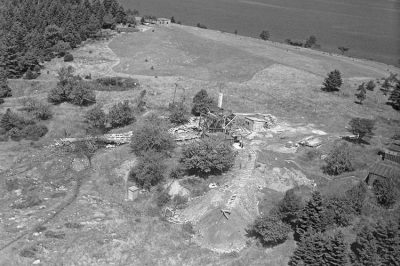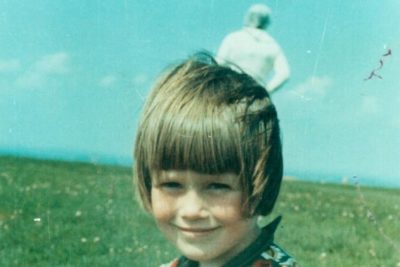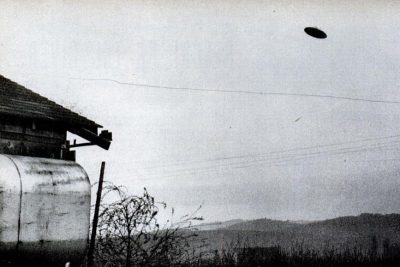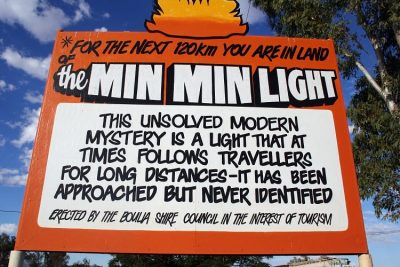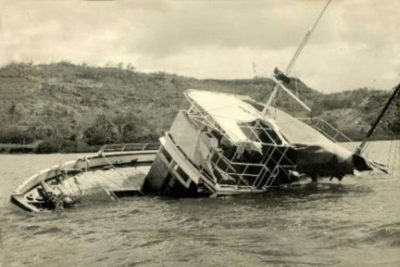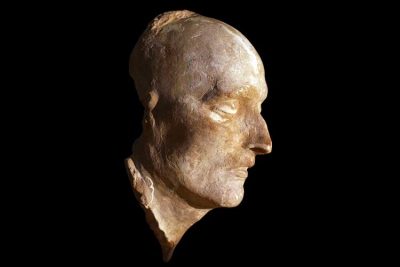The post Mapimi Silent Zone: A Patch in the Mexican Desert where Radio Signals are Inaccessible appeared first on .
]]>
Mapimí Silent Zone. (Cryptocône/Wikimedia Commons)
Located in the Trino Vertex, a few kilometres from the town of San Ignacio of Belize in Mexico is La Zona del Silencio or the Mapimi Silent Zone. It is a quiet desert patch with a strange phenomenon that baffles the mind—telecommunication signals and radio waves cannot be received or sent from here. It derives its name from its neighbours, Bolsón de Mapimi and the Mapimi Biosphere Reserve. Mapimi Silent Zone is a part of the 400,000 hectares Mapimi Biosphere Reserve and is 50 kilometres across.
Mapimi Silent Zone: The various theories

Purple Nopal Cactus. (Laura Wolf / Flickr)
The Mapimi Silent Zone is believed to possess unique magnetic properties because of its iron ore magnetite and uranium deposits. This could also be due to heavy meteorite activity occurring in this place and meteors have shown deep traces of metals. It has been reported that there was a crash of a meteorite in the 1950s which contained an extraordinary crystalline matter estimating to be about 13 billion years old, which is much older than the solar system. Now, it’s debated whether the magnetite and uranium were always present in the zone, or if they resulted from the frequent meteor showers.
The Mapimi Biosphere Reserve meanwhile, has undertaken the research of the strange mutations of plant and animal species found in the area, the purple cactus and the Mapimi tortoise which has been declared a vulnerable species, being the most famous ones. The area has 31 species of plants and nearly 75 species of protected animals.
The anomalies reported
In the 1930s, a famous record-breaking Mexican pilot, Francisco Sarabia Tinoco, was performing test flights in the Mapimi Silent Zone. Apparently, as he flew his plane over this sector, he lost all communication with the base. His compass went haywire, unable to point north, and his systems became unresponsive. At the base, all they could hear was white noise, which indicates a plane crash. However, Francisco seemed to have entered a vacuum, coming out of which he was forced to crash land. This bizarre incident spooked him enough to never fly over the zone again.
In 1964, an engineer with a Mexican petroleum company Pemex experienced radio silence in multiple patches of the desert. Pemex was exploring the desert area to run an oil pipeline to go up to Chihuahua (City in Mexico). Harry de La Peña, a Mexican engineer, was conducting the survey with his team when he discovered that they could not communicate with each other over walkie-talkies in a certain part of the desert. The team also noticed that their radios were only emitting white noise. On asking around, they found out from the nearest town Ceballos that television signals too could not penetrate the zone. Harry called it, ‘The Zone of Silence’. However, when he went back to confirm the radio silence, he discovered that it occurred in another patch of the desert. This gave rise to the speculation that the zone is not a particular area in the desert but one that shifts unpredictably.
On February 8 in 1969 at 1.05 am, the largest meteorite to have ever struck the Earth, Allende crashed to the ground here at a speed of 10 miles per second. Apparently, Mapimi Silent Zone is known for meteorite showers. On July 11 in 1970, the US Air Force and Army were conducting joint testing of a re-entry test vehicle (RTV) Athena in New Mexico. The rocket was launched from the Green River Complex in Utah and was supposed to drop in the White Sands desert in New Mexico. The RTV overshot its destination by 500 miles and crashed in the Zone of Silence. The crash, not intended, was attributed to the malfunctioning of the rocket. The US Air Force obtained permission from the Mexican government for clearing the debris and investigating the cause of the crash. It is then that the scientists confirmed that a certain section of the desert was a dead zone. No form of communication could be established within that zone.
Further research led to the knowledge that the zone had a very powerful magnetic field, almost as strong as the North Pole. There was also a shifting area that prevented the flow of any form of a signal; be it radio, television, shortwave, microwave or satellite signals. The US Air Force also carried back truckloads of the sand for research work./////
Read more: Leh Magnetic Hill- A Stretch of Road Where Laws of Gravity Work Peculiarly
The absurd stories of sightings
Moreover, shortly afterwards, people started reporting strange sightings of UFOs in the Mapimi Silent Zone. In October 1975, a couple narrated an encounter with two unidentified men. Josefina and Ernesto Diaz were in the desert area to collect fossils for further study. They ventured into the zone for picking up sand samples and any unusual rocks that they could find. However, they soon realised that a rainstorm was approaching and to avoid getting stuck in the desert, they drove away. They got into their vehicle and just as they were driving off; it got stuck in the wet sand. As they struggled to lift the vehicle from the swamp like area, they were approached by two men wearing yellow raincoats and caps who offered help. They were instructed by these men to sit inside and press hard on the accelerator as the men attempted to lift the vehicle enough to free it from the sandy swamp. As soon as the vehicle was freed, Ernesto decided to get down to thank the helpful strangers. To both’s bewilderment, the men were nowhere to be seen. Keeping in mind the flat vast land of that area with sparse greenery, there really wasn’t any place that they could have gone to not be visible to others.
Scientists have concluded that the sighting of UFOs and strange people could be a result of hallucinations caused by strong magnetic waves prevalent in the zone.
September 1976 was even more bizarre, with an entire town claiming to have been visited by a UFO. Closer to 9 pm that night, the residents of the town Ceballos reported of a huge rectangular spaceship-like object hovering in the sky above the town. Approximately 300 metres long, it had blinking coloured lights all around the rim and a deep pulsating hum. The dogs of the town were quite agitated with the hovering object and all broke into a continuous howl and bark, simultaneously. The object flew away after a couple of seconds, presumably headed towards the Zone of Silence, as claimed by the spectators.
In the month of November in 1978, journalist Luis Ramirez Reyes was visiting the zone and the nearby biosphere reserve, along with a team, for a story on the peculiar events in the area. Reyes and his photographer drove in a separate car from the rest of the team and after touring for some time in the desert, it was obvious that the two were lost. Reyes saw three men walking along the path and asked his colleague to pull up for directions. His colleague, however, unable to see anyone, kept on driving. A few kilometres ahead, Reyes again saw the same people and this time firmly asked his colleague to stop the car. The trio gave them exact directions on how to reach the biosphere reserve and claimed to have been looking for their lost animals in the desert. Upon reaching the facility, Reyes narrated his encounter and was flabbergasted by the information that the only people in the vicinity for miles were the employees, who were all inside the facility that day.
Conclusion
The most obvious theory is that the high level of magnetism of the zone due to the iron deposits tends to obstruct the functioning of compasses. Also, the fact that the Mapimi Silent Zone is in the middle of nowhere, leads to the conclusion of disruption in signals. However, thanks to the geographical location of the zone, similarities are often drawn with other unexplained phenomena. Comparisons to its similarity to the Bermuda Triangle are simply because La Zona del Silencio is geographically located between the same parallel coordinates. However, sooner or later, we can only hope that the true facts about the existence of this strange land can be explained.
Enjoyed this article? Also, check out “The Incredible Geoglyphs of Peru, the Nazca Lines“.
Fact Analysis:
STSTW Media strives to deliver accurate information through careful research. However, things can go wrong. If you find the above article inaccurate or biased, please let us know at [email protected].
RELATED
The post Mapimi Silent Zone: A Patch in the Mexican Desert where Radio Signals are Inaccessible appeared first on .
]]>The post The Unknown Fate of Grand Duchess Anastasia of Russia appeared first on .
]]>
Nicholas II of Russia with the family (left to right): Olga, Maria, Nicholas II, Alexandra Fyodorovna, Anastasia, Alexei, and Tatiana. Livadiya, Crimea, 1913. (Boasson and Eggler St. Petersburg Nevsky 24)
In recent years science has become proficient in the field of genetics and can dispel such claimants. However, in past years many famous people who died in peculiar circumstances would likely have people claiming to be them–seeking fortune or fame. This was the case for the Grand Duchess Anastasia Romanov, who went missing at the age of seventeen. She had at least ten women claiming to be her and therefore the beneficiary of the Tsar’s estate.
The situation in Russia
Russia began as a nation as early as 882 ACE during the foundation of the Kievan Rus Empire—a federation of Slavic tribes. A dynastic family called the Romanovs took control in the 1700s and did so until the Russian Revolution in 1917 which brought about a call for communism in the Russian Empire. The last Tsar of Russia—Nicholas II—abdicated to bring an end to the Romanov dynastic rule. This event brought about intense periods of civil war between an aspiring political party called the Bolsheviks and anti-Bolshevik factions, many of whom still favoured the Tsar. The Communist Bolsheviks won, illustrating their victory by killing the Romanov family on the orders of Vladimir Lenin–it is assumed.
The Romanov Dynasty
This family had links all over Europe and married internally to keep the bloodlines strong. Since the time of Michael–the first Romanov Tsar (1596–1645), they transformed Russia into a global power, meaning the age of prosperity for many of its citizens. Anastasia’s father and descendant of Michael–Nicholas II–had a family tree branching the length of Europe. His father was the Tsar of Russia and his mother a Danish princess.
His aunts and uncles included: King Frederick VIII of Denmark, George I of Greece and Queen Alexandra of the United Kingdom. For cousins: German Emperor Wilhelm II, King George V of the UK, the King and Queen of Norway, King Christian X of Denmark and Constantine I of Greece.
Despite this influence and power, by the time of World War One, many citizens of Russia became displeased by the Tsar’s efforts. Some of this stemmed from his wife Alexandra–granddaughter to Queen Victoria of Great Britain. She was born a princess of Hesse and Rhine–a part of Germany, but after several proposals and spouses Alexandra married the Tsar of Russia to become the Empress–or Tsarina–of Russia. She had five children: Anastasia, Olga, Tatiana and Maria, and Alexei. Like Queen Victoria, Alexandra and her son Alexei had haemophilia; an inherited blood disorder, wherein blood doesn’t clot normally. This would contribute to their downfall. And with World War One against Germany, the Russians did not trust Alexandra as Germany was her birthplace.
Tsar Nicholas II left the royal palace in St. Petersburg in 1917 (at the time Petrograd to sound less German) after the Bolshevik forces pressurized the family and regime. They sought to install a communist regime. Nicholas II and his family were arrested and exiled to the Urals by pro-Bolshevik forces under their leader Vladimir Lenin, though it was the decision of the Supreme Council of Russia. Into a town called Yekaterinburg, the Romanovs were transported towards the vast, desolate stretch of Siberia. The Bolsheviks had taken over many government buildings around Russia, as well as a residential mansion–Ipatiev and transformed it into a prison. On the night of July 16, 1918, the whole family was taken to the basement of the aforementioned mansion to be shot.

The basement of the Ipatiev house—the site of execution. (Wikimedia Commons)
The mystery of Anastasia Romanov

Photo of Princess Anastasia Nikolaevna of Russia, with her signature. (Galerie Bassenge/Wikimedia Commons)
Anastasia was born in 1901 near St. Petersburg–at the time the capital of Russia. She was said to have been murdered in the Ipatiev Mansion, but several people came forth claiming to be her years after the event. As not all bodies were found there was much speculation and many conspiracy theories that few members of the royal family escaped. A plausible theory is that because they had sewn jewels into their clothes before the assassination, it protected them. The jewels had deflected the bullets and bayonets from the would-be assassins. When World War One had finished and civil unrest had quietened, several people claimed to be Romanovs. A big reason was the unclaimed inheritance.
Anna Anderson
The most famous of these came to be known as Anna Anderson, who emerged in 1920. She had tried to commit suicide in Berlin, jumping off a bridge into a canal, but her attempt was futile. She was checked in to a mental hospital called the Dalldorf Asylum. The girl had no identity, only occasionally using the names Anderson and Tchaikovsky, yet she spoke very little. She had a foreign accent when she spoke German—presumed as Russian and was called Miss Unknown.

Anna Anderson. (Wikimedia Commons)
Rumours passed in the asylum of her being one of the lost Romanov girls–one of the biggest world stories at the time. For this reason, she was taken in by a Russian emigre called Baron Von Kleist who believed her to be of Romanov descent. After some time, she spoke more and explained that a Bolshevik soldier helped her escape after finding the bodies outside the Ipatiev Mansion. A Colonel who was acting as a communications officer in Budapest confirmed this, establishing that Anastasia had arrived with a man called Alexander Tchaikovsky. They sold her royal jewellery to stay alive in Budapest, but after Tchaikovsky was killed she fled to Berlin in fear. Many would come to visit her, some recognised her as the tsarina, and others did not. She met enough people who had faith in her to survive, the kindness of strangers, or perhaps the agenda of strangers gave her bread and board in many places. For instance, the famous Russian composer Sergei Rachmaninov paid for her hotel stay in the US during one period. The Romanovs had a family doctor who was also executed at the Ipatiev Mansion, but his son survived. His name was Gleb Botkin and he would vouch for Anna as Anastasia for all of his days. He recalled meeting her when they were both children.
It would be her behaviour which made the people who took her in lose patience, alas. She displayed many signs of madness at different times, such as throwing tantrums or running around naked.
When she ran out of supporters in Europe, she moved to the US and stayed with another Russian émigré and supposed cousin–Princess Xenia. She had similar success here as some emigres believed her enough to house her, but most eventually let her go. Her tantrums always led her back to insane asylums. Anna eventually settled with an eccentric American professor and friend of Gleb Botkin called Manahan, where she lived out her days in squalor–even though they were said to have a minor fortune. Botkin was the best man at the wedding in which Anna legally became Anastasia Manahan. It would not settle her down however as she ended up in asylum again. On one occasion Manahan helped her break out, but the police caught them and she was admitted once more. In 1984, she died of falling health.
The truth
There was little transparency during the Soviet Union, so it was not until the dissolution of the Empire neared–the falling of the Iron Curtain–which cleared up matters such as these. A DNA test in 1991 proved that Prince Philip of the UK (grandson of Queen Victoria) was not related to Anna Anderson and therefore she could not be related to the Romanovs. In 1927, a private investigation found her to be Franziska Schanzkowska of Poland, but it could not be proved until a similar DNA match in 1991.
Other imposters included Nadezhda Vasilyeva and Eugenia Smith, but none led as extraordinary life as Franziska Schanzkowska. A film was even made to showcase Schanzkowska’s exploits starring Ingrid Bergman. The life of this woman is hard to wrap one’s head around. It is more eventful than the lives of many thousands of people combined. As with the story, modern science brings the dissolution of much mystery in the world. There is a certain sadness to that, but if justice prevails, then we cannot lament.
The missing Romanovs
On 17th July 1998—the 80th anniversary of their deaths, the remains of Nicholas II, his family and entourage were reinterred in St. Catherine’s Chapel.

The final resting place of the Romanov family at Chapel of St.Catherine The Martyr in St.Petersburg. (Ninara/Flickr)
However, the remains of two Romanovs were never found. But in 2007, archaeologists discovered the remains of two individuals believed to be of Alexei Nikolaevich and the missing daughter—either Anastasia or her older sister Maria. A DNA test was carried out whose results remain inconclusive.
Enjoyed this article? Also, check out “Ivan the Terrible: The First Tsar of Russia and His Reign of Terror“.
For more unusual stories & intriguing news follow STSTW Media on Instagram and Facebook. Also, join our live chat discussion on Twitter.
Do you have a story for us?
We welcome your contribution at [email protected]. Please include your name, city, state, and country.
Fact Analysis:
STSTW Media strives to deliver accurate information through careful research. However, things can go wrong. If you find the above article inaccurate or biased, please let us know at [email protected].
RELATED
The post The Unknown Fate of Grand Duchess Anastasia of Russia appeared first on .
]]>The post The US Department of Defense Has Released a Footage of UFOs but What Is It Actually? appeared first on .
]]>In the first of its kind of transparency, the Pentagon officially released three videos on 28th April 2020, these videos recorded in 2004 and 2015 captured alien objects. The examination into what they are and where remains incomplete, but the speculations are varied.
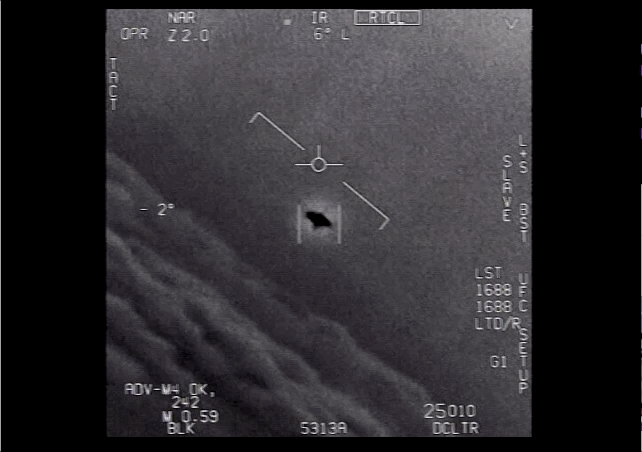
A UFO spinning in the air, January 2015. (Via www.sciencealert.com / Department of Defense)
First UFO sighting can be dated back to as early as 1440 BC in ancient Egypt, which was then described as fiery disks floating in the skies. “Aerial battle” was reported in 1561 celestial phenomenon over Nuremberg in the Roman Empire, a similar celestial phenomenon was observed five years later in 1566 in Switzerland. The credibility and factuality of these instances are suspicious. While some modern UFO enthusiasts classify as the battle of extra-terrestrial origin, others debunk these stories and classify them as atmospheric optical phenomena. Whatever the facts may be, one thing is for certain, man has always been intrigued by the aforesaid aerial objects.
Coming to more recent encounters, in 1942, the US army already in a war with Japan was caught off guard with unknown aerial raids. Although it was initially thought to be Japan’s aerial attack, the Japanese denied any such activity. The Battle of Los Angeles, as it is widely known, was the battle US fought with an unknown and unseen enemy. A few years later, it was reported the aerial strikes were the result of a weather balloon crash. Besides this seemingly apocalyptic encounter, the first sound encounter was reported in 1947—a flying saucer—nine shiny flying objects were observed in the sky by the pilot, Kenneth Arnold. After this report, a few more sightings and a crash were described in the same year. The crash—Roswell UFO crash, was later discredited by the United States Air Army Forces as a weather balloon crash again. ET life supporters, for a long time, were sceptical of the Army reports and considered it to be yet another conspiracy to cover up an extra-terrestrial landing.
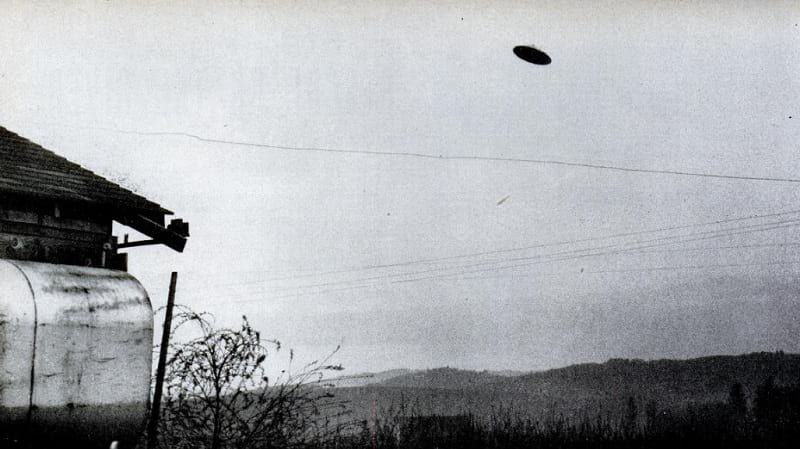
The McMinnville UFO photographs are considered to the most famous photos of UFO ever taken. It was captured by Paul Trent on a farm near McMinnville, Oregon. (Wikimedia Commons)
The mystery surrounding these aerial objects or phenomenon is yet to be cracked, giving humankind a subject to muse over. The recent videos of unidentified aerial phenomena, UFO in simpler terms, released by the Pentagon once again fanned the imagination and curiosity of the human mind. Two of these videos were leaked in 2017 by the New York Times, but Department of Defense (DOD) remained tight-lipped, although acknowledged the existence of these videos.
The recent release, DOD said, is to clear misconceptions regarding the nature of the videos and speculations if there was more to these videos.
These videos, dating back to 2004 and 2015, are available on Naval Air Systems Command Web Site. The 2004 video recorded an unknown flying object being chased in Southern California by two Navy F/A-18F Super Hornet fighter jets. Upon observing the speed and movement of this oblong object, it was popularly named Tic Tac. It instantaneously changed directions in the sky and according to the official government reports, it descended very rapidly, from 60,000 ft to 50 ft in a matter of seconds. The 2015 videos were recorded on the East Coast of USA. According to the interview given to the New York Times, the navy pilots encountered multiple flying objects in 2014 and 2015, between Virginia and Florida.
In the video, one of the pilots is heard calling them drones—drones that flew against the wind.
As with any UFO, the theories around these objects vary from person to person, those with a keen interest in sci-fi believe in alien activity, while the realists assess atmospheric illusions or secret military drills, satellites and drones. One may conclude these objects to be aircraft or drones, but their movement and speed are unlike any other aircraft. Perhaps could be AI-driven drones, one can never tell, as these objects upon detection scurried away. Their structures and origin are hard to discern from the videos—leaving a lot for human imagination and scientific and conspiracy theories. The truth and purpose of these Unidentified Aerial Phenomena or Unidentified Flying Objects will only be revealed with time.
Click: There is a UFO religion where people believe in extra-terrestrial beings called elohim
Fact Analysis:
STSTW Media strives to deliver accurate information through careful research. However, things can go wrong. If you find the above article inaccurate or biased, please let us know at [email protected].
RELATED
The post The US Department of Defense Has Released a Footage of UFOs but What Is It Actually? appeared first on .
]]>The post The Mysterious Crooked Forest of Poland appeared first on .
]]>
Crooked forest. (7alaskan / Wikimedia Commons)
The Crooked Forest near Gryfino in Western Poland is a bizarre and eerie woodland formed of a dense grove of potbelly shaped pine trees. A profound mystery surrounds the existence of this forest. The town of Gryfino was majorly devastated in the Second World War and the truth of the forest was lost with it.
Notwithstanding the countless diverse theories contemplated throughout the years, nobody genuinely knows what made the trees assume this distinctive shape.
Morphology of the Crooked Forest
This curious cluster of trees comprises of 400 curved pine trees that bend 90-degree towards the North, a few feet above the ground level. It then swerves upwards with a sideway digression.

Crooked pine trees. (maxpixel)
Because of their admirable resilience, the trees continued to thrive. Strangely, the forest also envelopes a more expansive growth of straight developing pine trees bereft of the curve distinctive to their siblings.
It is believed that the trees have been planted sometime around the 1930s. Despite their arched beginnings, all the trees have grown quite tall, mostly touching 50 feet, unbridled by their unique C shaped curves.
It is estimated that they were roughly 7 to 10 years old when they encountered some inexplicable force or damage that incurred their odd trunk curvature. This would have happened before the Second World War reaching Poland.
So what could have engendered these trees to display the freakish “C” shape? Heredity? The weather? The War? Or the Local foresters? Here are some of the widely known speculations behind the crooked forest.
Heavy snowstorm
A somewhat more conceivable, yet at the same time genuinely far-fetched hypothesis is that an enormous and destructive snowstorm could have flattened the trees for a prolonged timeframe.
This coupled with an extended spring melt, might have moulded the trees permanently. When the trees experienced a spurt in growth during the spring, a concrete layer of snow might still have existed on the top of their trunks.
In any case, this theory appears to be unlikely as the Crooked Forest also accommodates regular-shaped pine trees as mentioned before. It would in this way be exceptionally abnormal for a snowstorm to have an impact in just one particular territory of the woodland and leaving the rest unscathed.
Enemy tanks mowing down the forest during Second World War
Another mainstream conjecture is that adversary tanks plundered and ploughed through the budding forest and levelled the trees to such a degree that triggered the unusual curvature while growing.
Similarly, in this case as well, one can debate as to why only this particular stretch got affected. It appears to be highly improbable that the traumatic run over by the tanks would outcome such an oddity with uniform bark-covered bellies.
Gryfino was ravaged during the war. When a new power plant came up in Gryfino in the 1970s the town observed a resurgence. The Crooked Forest is found close to this power plant, called the Dolna Odra power plant. This would adequately explain why the vast majority of the locals do not have the foggiest idea as to why the trees look like this.
Erratic gravitational pull
Some theories surmise that the gravitational force fluctuations or a strange gravitational draw in the area might have caused this phenomenon. Yet there is no evidence to endorse this ludicrous theory. The power of gravity pulls down objects. It does not stretch them sideways.
Genetic disorder

Twisted aspen tree in Saskatchewan, Canada. (Turgan / Wikimedia Commons)
William Remphrey, who was a retired plant scientist from Manitoba University, had discovered a distinctive genetic mutation. This malady caused the striking curvature and drooping of aspen trees in Canada over their years of development, resulting in the formation of twirled and twisted trees.
However, he professed that if the origination of the abnormality of Poland’s Crooked Forest is genetic, he would have expected the curves to extend beyond the base as were observed in the aspen clan. Taking into account the extent to which they are smooth, he stated that some unnatural environmental phantasm might have caused this deformity of sweeping curves.
The man-made angle
The final hypothesis tossed around and appears to have garnered the maximum acceptance is likely the most humdrum of them all. It suggests that the queer curves are nothing but man-made.
This explanation would bode well given the fact that the trees have exhibited a consistent growth. The theory proposes that amid the 1930s, the native farmers took to planting and manipulating the trees to secure their ultimate use as construction materials.
For instance, household items, pieces of furniture or transport carrier building. The foresters might have employed certain tools or techniques to achieve the unmistakable bending.
Oakwood from the territories of Northern Europe was used to manufacture straight and long planking. However, the gnarled Hedgerow Oakwood from England was best utilized as naturally curved timbers to fortify the ship interiors.

Crooked forest trees, Nowe Czarnowo. (Kengi / Wikimedia Commons)
Trees were intentionally bent in specific manners for generating a required arrangement of curved timbers otherwise called the compass timber.
When Poland was invaded during the Second World War, this manufacturing and development activity, in most plausibility would have been disrupted. This kept the farmers from having the capacity to finish their job and deserting the forest, only to be discovered today with its peculiar spectre.
Enjoyed this article? Also, check out “Bristlecone Pine: The Oldest Trees of Our Planet“.
Fact Analysis:
STSTW Media strives to deliver accurate information through careful research. However, things can go wrong. If you find the above article inaccurate or biased, please let us know at [email protected].
RELATED
The post The Mysterious Crooked Forest of Poland appeared first on .
]]>The post Leh Magnetic Hill: A Stretch of Road Where Laws of Gravity Work Peculiarly appeared first on .
]]>
Magnetic Hill in Ladakh. (Rohit Ganda / Flickr)
India is a country that boasts of natural wonders in abundance. One is likely to find an oddity in almost every nook and cranny of the nation. India’s northernmost and newly-formed Union Territory Ladakh is home to one such rare phenomenon. It has not only stumped visitors from all over the world but has also puzzled scientists alike. On average, tourists in thousands, visit The Magnetic Hill in Leh district all year round to experience this thrilling and unique occurrence themselves.
What is Magnetic Hill?
Magnetic hill is also known as Cyclops hill, although the origin of this term remains unknown. It is said to be derived from the eponymous Greek monster with a single, spherical, gigantic eye.
Nothing more than an optical illusion, the Magnetic Hill or Gravity Hill in Leh is a place where the gravitational pull of the Earth works differently as compared to the rest of the world.
Location of the Magnetic Hill
As the name suggests, the Magnetic Hill is a stretch of road in the mountainous Leh-Kargil-Batalik NH1. Located in a remote valley approximately thirty kilometres from Leh, it is positioned around 14,000 feet above sea level, where the gravitational pull of the Earth defies laws of physics.
The Magnetic Hill sits pretty between the longest mountain range in Asia and passes through the Trans-Himalayan region. And is flanked by the Sindhu River on its east making it look like a scene from a fairytale! A picturesque landscape, Magnetic Hill has become a pit-stop for travellers, to soak in the wonders of nature.

Magnetic hill signboard near Magnetic hill in Leh, Ladakh, India. (Ashwin Kumar / Flickr)
The Border Roads Organisation has put up a signboard to help tourists experience the magnetic pull of the region. A horizontal white box is painted in the middle of the road for travellers to park their vehicles in; where it tends to get pulled uphill, despite its ignition turned off. But there is more to this gravity hill than meets the eye. A lot of theories surround this phenomenon associated with the magnetic pull in the locale, leaving its visitors astounded.
Local legends associated with the Magnetic Hill
People living in and around the areas surrounding Ladakh believe this Hill to be the only stairway to heaven. According to local folklore, people who deserve to go to paradise are directly lifted towards the sky while on their way through the hill; and those that did not make it to the list, never get a chance to visit the place. Some even stir up stories of paranormal activity in the area. Tour guides also narrate these legends to pull in more and more crowds, making it an interesting trip.
Scientific Theory explaining the occurrence at Magnetic Hill
While legends are quite popular, one postulated and rational theory suggests a strong magnetic field exists in the particular patch of land, which pulls vehicles towards it. The magnetic energy emitted here affects the vehicles and complicates the navigational equipment of aircraft flying directly over the area. It is said that any aircraft flying over the region starts to experience jerks. In case an aircraft comes within the magnetic range, it is advised to fly at a certain speed and height to avoid accidents. Reportedly the Indian Air Force makes it a point to avoid getting within the vicinity altogether to prevent damages.
The Optical Illusion Theory
Although a great number of people across the globe believe in the magnetic field theory, a lot of other people are convinced Leh’s strange and inexplicable Magnetic Hill is nothing but the work of an optical illusion. Quite contrary to the magnetic field speculation, this theory has managed to find a lot more takers. Attributing to an obstructed horizon from the point of view of a traveller, the downhill slope appears to be uphill. In such a case, a vehicle in neutral gear inside the designated white box appears to move uphill. Although the topography of the surroundings is such that the vehicle actually moves slightly downhill.
Other Magnetic Hills in India and abroad
While the Magnetic Hill in Leh is quite popular, a lot of other places present a strikingly similar gravity-defying experience. The Kawardha Magnetic Hill and Ulta Paani Gravity Hill in Chhattisgarh, along with the Tulsishyam Anti-Gravity Hill and Kalo Dungar Magnetic Hill in Gujarat are places where vehicles seem to roll uphill. Apart from these places in India, the Morgan-Lewis Hill in Barbados, Anti-Gravity Hill in Australia, the Electric Brae in Scotland, Anti-Gravity Hill in Ariccia, Rome, Mt. Penteli in Greece, Mt. Halla in South Korea, Malveira da Serra in Portugal, Gravity Hill in Washington, USA and other magnetic hills in America are some of the places around the world, where gravity plays tricks with an observer’s mind.
In the year 2015, a team of research students from the Rajasthan Institute of Engineering & Technology performed a series of experiments at the Magnetic Hill to debunk the myths associated with it. Although they provided scientific data along with theories nothing came out of it. They tried to prove that there is nothing strange in the area; but in the end, the mystery of the Magnetic Hill and its gravity-defying pull has only deepened further.
Enjoyed this article? Also, check out “Roopkund Lake: What are Hundreds of Bones Doing Around a Lake in Uttarakhand?“
Fact Analysis:
STSTW Media strives to deliver accurate information through careful research. However, things can go wrong. If you find the above article inaccurate or biased, please let us know at [email protected].
RELATED
The post Leh Magnetic Hill: A Stretch of Road Where Laws of Gravity Work Peculiarly appeared first on .
]]>The post Roopkund Lake: What are Hundreds of Bones Doing Around a Lake in Uttarakhand? appeared first on .
]]>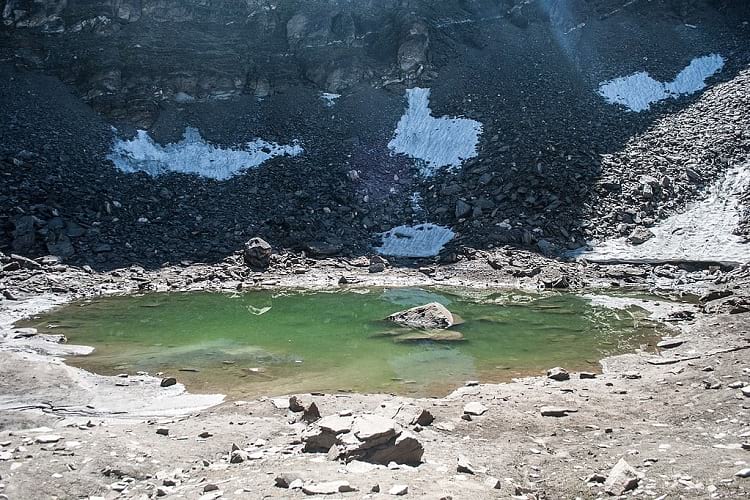
Roopkund lake. (Schwiki / Wikimedia Commons)
Roopkund is a glacial lake situated in the Himalayan range in the state of Uttarakhand, India. Also known as the Skeleton Lake, this beautiful Himalayan Lake is very shallow, with a substantial depth of approximately two meters. Owing to its mysterious nature, it is a popular location for trekkers and adventurous tourists.
A ranger belonging to Nanda Devi National Park discovered this lake filled with human remains, in 1942. Whenever the ice melts in this region, bones from hundreds of skeletons become visible on its bed. It is estimated that skeletons of 300 different people have been recuperated from this lake along with objects such as jewellery, wood, and some iron artefacts. A few of the skeletons had flesh still fixed to the bones mainly due to the cold and harsh conditions of the area.
Where did the skeletons in Roopkund come from?
The tales of the Skeleton lake were famous among the locals prior to its discovery. When the ranger’s discovery captured the attention of those who were interested, it raised a lot of unanswered questions. The British Empire speculated that the bodies were of Japanese soldiers, who had been trekking across India during the Second World War.
An investigating squad that was sent to the place at the time of discovery ruled out this possibility based on the fact that the remnants were too ancient to be from the war. Later, a radioactive carbon dating procedure revealed that these bodies were in fact from the mid-ninth century, around 850 AD.

Bones in Roopkund Lake. (Ashokyadav739 / Wikimedia Commons)
The mystery surrounding their death was theorized in 2013 by a few scientists. They speculated that the bodies belonged to two groups, one group was a closely related group, like a family, and the other consisted of unlike people. There was a significant difference in the heights of the bodies of the first group that was estimated to be a family, being much longer than the other group leading to a theory that the shorter group consisted of local people.
A DNA analysis showed that the taller group had origins from Iran and the shorter group, indeed, had local ancestry. This finding suggested that the family were likely to be pilgrims going through the area with the help of local guides when something unfortunate happened to them. The cause of their death had many speculative answers, like a landslide or a mass suicide.
However, a local legend provided details of the remains. According to him, the entourage of King of Kanauj, Raja Jasdhaval and his wife Rani Balampa who was pregnant at that time had set off to Nanda Devi Shrine to attend a festival that is celebrated after every twelve years. As they were on the move, the group was confronted by a strong hail storm. As there was nowhere to seek shelter in the open grounds, the whole group succumbed near the lake.

During summer when the ice begins to melts, bones belonging to hundreds of people become visible on its bed. (Ashokyadav739 / Wikimedia Commons)
Validating the story
Scientific analysis of the bones confirmed the legend’s explanation. The tests revealed that their heads and shoulders were struck with something blunt equal to the size of a cricket ball which cracked their skulls. Hence, it has been deduced that an unexpected hail storm in the area was the cause of their deaths. Their bodies remained frozen in the lake, at an altitude of 16,000 ft, for more than 1200 years until their discovery during the Second World War.

Roopkund lake can be reached after trekking through Bedni Bugyal. (Djds4rce / Wikipedia Commons)
The movement of tourists near the lake has proven to be disruptive to the environment surrounding the lake and the skeletons in them. The Indian Government has taken measures to preserve and protect this area. However, at times, the tourists tend to swipe a bone as a macabre souvenir that has been proven to be a loss this historic site. In order to preserve the bones, 3D scans of the bones are being done to digitally document them.
Enjoyed this article? Also, check out “The Unsolved Mystery Behind the Devil’s Tramping Ground in North Carolina“.
Not Recommended Visit:
Roopkund Lake | Uttarakhand
Fact Analysis:
STSTW Media strives to deliver accurate information through careful research. However, things can go wrong. If you find the above article inaccurate or biased, please let us know at [email protected].
RELATED
The post Roopkund Lake: What are Hundreds of Bones Doing Around a Lake in Uttarakhand? appeared first on .
]]>The post The Superstition Mountains and the Legend of the Lost Dutchman’s Gold Mine appeared first on .
]]>
The praying hand’s formation at the Superstition Mountains range. (Doug Dolde / Wikimedia Commons)
On the east side of Phoenix in Arizona lies the spectacular range of the Superstition Mountains that straddle the Tonto National Forest and the Superstition Wilderness area. They are bound on three sides by U.S. Route 60, Arizona State Route 88, and Arizona State Route 188, and are visible from miles away.
While popular with campers, hikers, and adventure seekers, these mountains are also known for their exceedingly hot summers, freezing winters, harsh winds, unpredictable storms, treacherous terrain, and mysterious happenings. Reports of inexplicable sounds, sightings, and events have led to claims of supernatural beings and even aliens. Combine these with the legends of the indigenous Pima Indians and the mountains live up to their name.
Among the many legends to have emerged from the area, one of the most enduring ones is that of The Lost Dutchman’s Gold Mine. Supposedly a mine with fabulously rich gold deposits. Many people have died trying to find it over the years, and, even with all the modern technology at our disposal today, the exact location of the mine in the vast wilderness still remains an enigma.
The Superstition Mountains
Superstition Mountain has an elevation of 5,024 feet. These steep, jagged volcanic mountains were formed over 29 million years ago and they cover an area of 160,000 acres. As the mountains have a desert climate and few water resources, there is not much vegetation here.
At the low elevations, you will encounter tall saguaro cactus and Ponderosa pines at higher levels, and these are generally near the streams. Animals like deer coyotes, pumas and bobcats live here, existing alongside birds, rodents, snakes, and other reptiles.

Saguaro cactus. (Circe Denyer)
The weather in the Superstition Mountains is notoriously unpredictable, with storms seeming to come out of nowhere and accompanied by abrupt drops in temperatures.
Two prominent landmarks here are the Weaver’s Needle and the Miner’s Needle. These are tall, volcanic formations in the wilderness and are popular as hiking destinations. There are numerous hiking trails that hikers can access from multiple points, one of the more well-known ones being the Peralta Trailhead.

Weaver’s Needle, a peak located in the Superstition Mountains. (Chris J / Flickr)
Legends of the Superstition Mountains
The Pima Indians famously feared the mountain that they knew as Ain-we-gophon (Superstition Mountain). According to their folklore, the mountain guards an ancient storehouse of precious metals and treasures, and anyone who ventures forth to get the treasure is likely to die.
According to the Apaches (North American Indians), the entryway to hell is in the Superstition Mountains. The mountain is also frequented with mysterious sounds that many people have claimed to have heard. The hellhole supposedly also sends out tremendous winds, and these cause the infamous dust storms of the region.
The Superstition Mountains, furthermore, are the abode of the Thunder God, and he causes the frequent regional thunderstorms.
There’s gold in them thar hills
There are many stories about hidden gold in the Superstition Mountains, and these usually mention the Peralta Family.
Don Miguel Peralta was the head of a powerful and wealthy Mexican family from Sonora, and they were either ranchers or operated mines or did both. They either mined or found enormous gold deposits in the Superstition Mountains. The stories differ from here onward.
According to some storytellers, in September 1848, a band of Apaches slaughtered the entire Peralta Family, except one (someone had to live to tell the tale). The Apaches were either enraged over the violation of their sacred mountains or wanted to steal the gold from them. Other storytellers claim that the Peralta Family escaped with gold, but another family died in the massacre. In any case, the event led to the naming of the Massacre Falls after it.
In the version in which the Apaches killed the Peralta Family, the surviving member then went on to get embroiled in a brawl fight years later. Two prospectors saved his life and, in gratitude, he gave them directions to the gold mine, thus setting off a wild goose chase that continues to the present day.
Doctor Abraham Thorne’s visit to the mine
A doctor from Illinois, Doctor Abraham Thorne, provided his service to treat the indigenous people of the Southwest. After he had spent many years in their midst, the Apache Elders decided to reward his selfless service with gold. In the year 1870, with his consent, they blindfolded him and took him on a 20-mile trip to an unknown location piled with gold ore. They removed his blindfold and let him take away as much as he could carry. Thorne sold the ore for $6000 and became a wealthy man.
Later, he remarked that he had noticed a towering rock formation nearby, but otherwise remained clueless about the whereabouts of the place. Many people took the landmark to be the Weaver’s Needle but had no luck finding any gold nuggets in its vicinity.
The Peralta Stone maps
Travis Tumlinson, a policeman, discovered the Peralta Stones on a roadside near the Superstition Mountains in the 1940s. These are rectangular, cross-shaped, and heart-shaped stones with etchings of a horse, a priest, a dagger, a trail, topographic features, and Spanish inscriptions. It is rumoured that if the stones are put together in the right way, they are a map to the Peralta Family’s gold deposits. Nobody has been able to interpret them correctly.

Front View of the Peralta Stones. (Latin Heart Reader / Wikimedia Commons)
The legend of the Lost Dutchman’s Mine
To begin with, there was never any real Dutchman involved with the lost gold mine. The closest approximate was a German miner of the Pennsylvania German community. When they immigrated to Pennsylvania from Deutschland (Germany), the locals mistook Deutsch for Dutch. The newcomers, thus, became the Pennsylvania Dutch.
Two Pennsylvania Dutchmen, Jacob Waltz and Jacob Weiser, were prospecting for gold in the area, when, one night, they happened to save a man’s life in a bar brawl. He turned out to be the surviving Peralta, and, to express his gratitude, he gave them directions to his family’s gold mine in the Superstition Mountains.
The two Jacobs found the gold but refused to tell anyone else where it was. Then the Apaches killed Jacob Weiser, or according to some, Waltz himself did it.
Jacob Waltz took to returning to the mountains only when he needed the gold. He died of pneumonia in 1891 and, according to the three neighbours who cared for him, he left them the box of gold under his bed and directions to the gold mine.
The neighbours—Julia Thomas, Rhinehart Petrasch, and Hermann Petrasch—spent weeks looking for the gold, but failed to find it.
Mysterious disappearances in the Superstition Mountains
The legend of the lost gold continued to attract people, and, in 1932, a veterinarian in the Park Service, Adolph Ruth, decided to go treasure hunting. He had acquired maps that he was sure would lead him straight to the gold. Instead, he went missing and his skull was found 6 months later with two large circular holes. The rest of his remains were found a month later about a mile away.
A note in a bottle found floating down the Salt River said that he needed help on account of his leg and that he had found the Lost Dutchman’s gold mine. To underline his great find, he had also written ‘Veni, Vidi, Vici’ (I came, I saw, and I conquered) in his diary. However, there were no directions to the conquest mentioned in his diary.
Many other mysterious deaths in the Superstition Mountains followed that of Ruth’s in the subsequent years, including two soldiers from the U.S. Army. And, amazingly, a few of these people were also found in the same headless state as Adolph Ruth. The search, nevertheless, still continues.
The Superstition Mountains in popular culture
There have been many books, films, and cartoons about the Lost Gold of the Superstition Mountains. These include Barry Storm’s book Thunder God’s Gold, published in 1945, detailing his own efforts to find the gold, and the Glen Ford and Ida Lupino movie, Lust for Gold, from 1949.
Hanna-Barbara, Jean Giraud, and Don Rosa have incorporated the story in their cartoons. The Lost Dutchman State Park, which opened in 1977 and has the Peralta Trail, is also a nod at the legend.
There is a Superstition Mountain Museum at 4087 N. Apache Trail, Highway 88 in Apache Junction. It is open daily from 9 a.m. to 4 p.m. except on Thanksgiving, Christmas, and New Year.
Fire in the Superstition Mountains
On 8 June 2019, a fire broke out in the Superstitions Wilderness area and soon spread across 26,000 acres. It was the fifth-largest fire in Arizona’s history, it raged for over a month, despite the strenuous containment efforts of over 600 firefighters. Due to the out-of-control fire, the Arizona authorities were forced to close the State Route 88, and, along with it, public access to the Canyon, Apache Lake, Apache Campground, picnic sites, and trailheads.
Fact Analysis:
STSTW Media strives to deliver accurate information through careful research. However, things can go wrong. If you find the above article inaccurate or biased, please let us know at [email protected].
RELATED
The post The Superstition Mountains and the Legend of the Lost Dutchman’s Gold Mine appeared first on .
]]>The post Old Man of the Lake: The ‘Stumping’ Story of a Century-Old Log, Bobbing Inexplicably in Oregon’s Crater Lake appeared first on .
]]>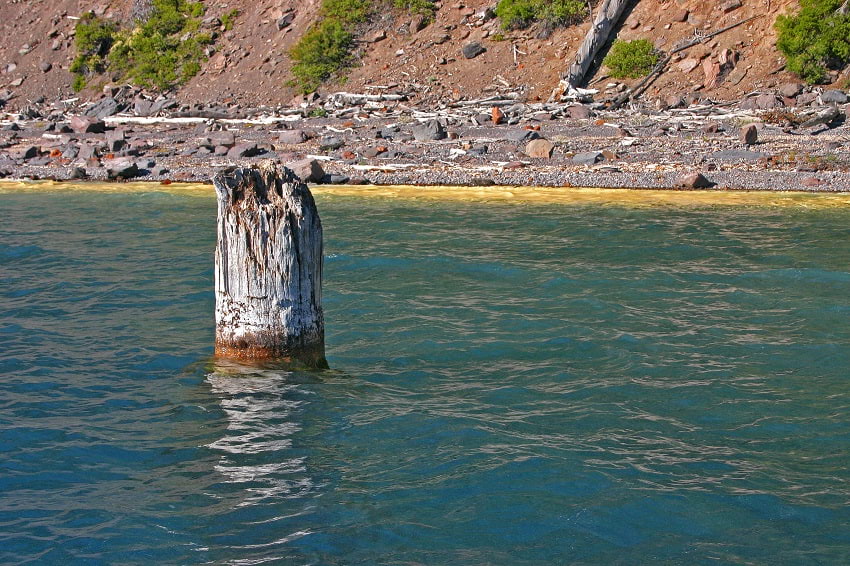
Old Man of the Lake in Oregon’s Crater Lake. (Markgorzynski / Wikimedia Commons)
A tree stump in Oregon’s Crater Lake has stood right in the middle of the waters, defying the laws of physics for more than a hundred years. Known as the Old Man of the Lake, the stump has baffled visitors and geologists alike regarding its more-than-a-century-old existence.
Legends associated with the formation of Crater Lake
Although it is known that the lake was formed as a result of volcanic activity, locals have a different belief. As per the Native American folklore, a battle of epic proportions was fought between two volcano gods about 7,700 years ago during the night in southern Oregon. The god of the underworld – Llao – fell in love with Loha, the extremely beautiful daughter of a local Klamath chieftain, who turned down his proposal, citing he was ugly to look at. Angered by the refusal and downright humiliation, Llao, standing on the summit of Mount Mazama, spat magma and threw extremely hot steam jets towards the sky. These fell back to the earth in the form of rain, pouring hot lava and fire on the village.
The Klamath chieftain then turned to the god above – Skell – to intervene and save them all. Skell then descended from heaven on California’s Mount Shasta and hurled volcanic ash and fireballs at Llao in retaliation. In the battle that continued for days, he blew up Mount Mazama and drove Llao back into the underground, locking him inside for eternity. To mark his victory over Llao and restore peace in the land, Skell covered the large caldera by filling it with crystal clear waters. That is how Oregon’s Crater Lake came into being as per local legends, which till date is considered sacred.
Location, formation and specifications of the Crater Lake
Known for its intense blue colour and water clarity, the Crater Lake is the deepest lake in the United State measuring a depth of nearly 1,949 feet (594 m). Situated in Klamath County, Oregon, Crater Lake was formed approximately 7,700 years ago, when Mount Mazama collapsed as a result of a volcanic eruption. The crater that formed in the process was almost 2,148-feet deep, and was later partially filled up with water resulting from annual rainfalls and snowfalls in the area. Since water does not flow out of the lake and also because there is an absence of water inlets, which could bring pollutants to fill up the caldera, Crater Lake has some of the purest waters in the world.

Crater lake in Oregon, United States. (Hunter Immel / Wikimedia Commons)
Scientists have measured a record clarity of 175 feet below the surface, which is till where the naked eye can see clearly under the waterline. Due to the low temperature of the water in the volcanic basin and greater levels of dissolved salts present in it, the cold, deep blue water in Crater Lake is slightly alkaline in nature.
The Crater Lake has no native fish, however, seven species of fish were introduced in the lake from 1888 to 1941 of which only kokanee salmon (Oncorhynchus nerka; landlocked sockeye salmon) and rainbow trout thrive today.
Two of the main features of the lake are the volcanic cinder cone in the far west of the lake called Wizard Island and the other is the puzzling Old Man that has been bobbling in different locations in the lake for over a hundred years.
History of the Old Man of the Lake
Apart from the lore and horror stories that are a part of the local culture, one bizarre phenomenon that literally sticks out from the water is the Old Man of the Lake. Standing untethered for more than a hundred years, the hemlock tree stump has gained celebrity status among tourists. Long before Oregon’s Crater Lake became a part of the national park, this unusual deadwood was found floating in a vertical position in the water body and nobody could guess where it came from.
It was initially thought that the Old Man of the lake, could have been vertically wedged between a rock, but it was not.
Trees that float (mostly horizontally) eventually sink to the bottom, however, the Old Man showed no such signs. Instead, it continued staying afloat for decades together, without having any root structure to support itself or any telling marks of decay.
In the year 1902, when Crater Lake achieved the status of a national park, American geologist Joseph Silas Diller was sent to scientifically study the aftereffects of the volcanic event and collect rock samples from the Crater Lake. This is when he first recorded about an unusual bobbing tree stump in the lake, which he had observed six years ago in 1896 and was still afloat in the lake. He noticed that the chunk of wood had moved from its earlier position from where he had first found it.
Specifications of the Old Man of the Lake
Aquatic biologist Scott Girdner ran carbon dating tests on it and found that the stump itself is approximately 450 years old. Measuring thirty feet tall in height, nearly four feet of the Old Man’s upper part sticks out of the water, which remains perpetually dry. The upper part is bleached due to continuous exposure to the sun and has a splintered texture. The part floating above the water is around two feet in diameter and the Old Man is wide and buoyant enough to support the weight of an adult person.

A man standing on the Old Man of the Lake, 1938. (NPS)
The stump keeps moving throughout Crater Lake due to water currents and wind patterns. On particularly windy days, the trunk travels at greater speeds, at a rate of nearly 6 kilometres/day.
How has Old Man of the Lake managed to stay afloat for more than 120 years?
Scientists believe that the lower rate of precipitation and evaporation and the relatively cold water of the lake have preserved the stump, making it possible for the Old Man of the lake to float freely. They also concluded that since the lower part of the tree stump has been in the cold water for over a hundred years, its density has increased, making it buoyant and balanced inside the water. However, there is no concrete data to support these claims.
Superstitions and stories related to the Old Man of the Lake
Along with the mysterious formation of the Crater Lake and the circumstances under which the Old Man ended up vertically in the lake, there are a host of other tales that are associated with the place. People have reported spotting campfires in the dead of the night on the uninhabited Wizard Island. Some even claim to have seen ghostly figures in the lake vicinity. Local people also say that the Old Man represents perfect balance like that between earthly elements – of darkness and light, good and evil, earth and sky, movement and immobility and Llao and Skell. It is also said that the perplexing tree stump possesses otherworldly powers with which it can control the weather. And surprisingly, a team of researchers had to give up on their expedition when the ancient stories appeared to come true.
In the year 1988, a team of scientists was sent on an expedition to study the geothermal activity in the volcanic basin at Crater Lake. A submarine was employed to take the explorers below the surface of the water and carry out their experiments. Known for its ability to travel with the winds and water currents, the team thought that the Old Man might pose serious navigational problems to the vessel, hampering their research. And so to keep it from getting in the way of their study, the team decided to tie it towards the eastern side of the Wizard Island for a few days until work was over.
But as soon as the Old Man stood still, all tied up in the lake, the research team experienced a sudden change in the weather. Oddly enough, the clear skies became dark and hazy and the weather became stormy. This continued on for a while making the team suspicious of the weather situation owing to the behaviour of the Old Man. So long as the dead tree stump was bound, the dark clouds refused to clear out and the team had to free the Old Man eventually. No sooner was the stump untied than the sky became clear and the weather settled, puzzling the researchers even more. The study was ultimately left midway and the Old Man was never bound again.
It is yet to be seen what new facts are unearthed from research works on the stump at Crater Lake, but one thing is clear that the Old Man of the Lake will continue to ‘stump’ people whenever they cross paths with it.
Enjoyed this article? Also, check out “Min Min Light: The Elusive Phantom-Lights of the Australian Outbacks“.
Fact Analysis:
STSTW Media strives to deliver accurate information through careful research. However, things can go wrong. If you find the above article inaccurate or biased, please let us know at [email protected].
RELATED
The post Old Man of the Lake: The ‘Stumping’ Story of a Century-Old Log, Bobbing Inexplicably in Oregon’s Crater Lake appeared first on .
]]>The post Remembering the Bone-Chilling Story of the Missing Sodder Children appeared first on .
]]>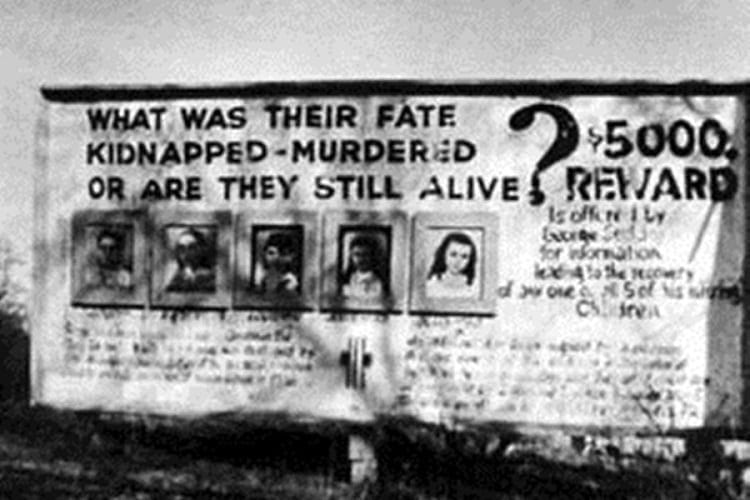
The famous billboard seeking information about the missing Sodder children. (Wikimedia)
There is nothing more chilling than a murder mystery. The reason being, that when a crime is unsolved then automatically the worst case scenarios will reel through a person’s mind. This would have been the torturous case for parents George and Jennie Sodder after five of their children seemed to have miraculously survived a house fire, their remains were never found.
A billboard was erected offering a generous reward for information leading to their recovery. Many people came forward with rumours, some relating to the Sicilian Mafia.
History of Sodder family
The location and background are both essential to the mystery. It occurred on Christmas Eve, 1945 in Fayetteville, West Virginia. Nicknamed ‘The Mountain State’, it is predominantly covered by the Appalachian mountain range. Much of the state was rural with many villages separated from the major towns and cities, located to harvest coal and other fuels.
The father George Sodder, moved to the US from Sicily at 13 years old with his brother. An exact reason was never specified but it was common for Italians to make the move for economic reasons. Eventually launching his own trucking company, George married Jennie and had 10 children settling in Fayetteville, a village with a strong Italian community. It was a community in dispute, however political tensions during World War II and the reign of Benito Mussolini caused division. George Sodder openly criticized the Italian government which made him enemies around town.
Sodder Children disappearance
In the run-up to the fire, some weird things happened. Two months previous, a stranger appeared at the house inquiring about work. He claimed the fuse boxes were unsafe even though George had them checked regularly. Around the same time, another man came to sell insurance. He threatened the family after they declined and quoted George’s dislike for Mussolini in his insults.
Weeks before, the older boys noticed a man in a vehicle parked along the nearest highway, watching them as they walked home from school. Christmas day was hours away – under normal circumstances the happiest time of year for families. 10 PM was the usual bedtime for the kids but they were allowed to stay up late with some early Christmas gifts. So Maurice (14), Martha (12), Louis (9), Jennie (8) and Betty (5) played upstairs while the others went to sleep.
Later, the mother Jennie awoke to a call coming from the office. An unfamiliar female voice asked for an unknown name with much laughter in the background – it was a wrong number. Jennie noticed that the living room lights were still glowing and the curtains were left open. On checking the main door, she found it unlocked – things that the children were meant to take care of. She saw Marion (17) sleeping on the couch in the living room and presumed other kids to be asleep too. She went back to sleep after locking the door, closing the curtains and turning off the lights. Moments later, again she awoke, after hearing a loud bang on the roof.
Shortly after, smoke began to bellow. Instinctively, four of the nine children present escaped to the garden with their parents. The two eldest brothers made it down from the attic but the younger kids a floor below were nowhere to be seen (although their voices were apparently heard). George attempted to get upstairs but the staircase was now alight. He ran for his ladder but it was not in its usual place. He tried to drive either of his two coal trucks to the house to climb atop but neither started, having worked perfectly during the day. One daughter ran to their neighbours to call the Fire Department but none of their phones were working. So a neighbour drove into town to find Fire Chief F.J Morris who set off the alarm.
The house had been completely destroyed in 45 minutes with F.J Morris not arriving until 8 AM (claiming he had to wait for a driver first). By then it was assumed that the five children had died. No remains were found with Morris suggesting the blaze consumed everything and the police deemed it faulty wiring. George and Jennie made the site into a memorial soon after, covering it with dirt and five graves.

The five missing Sodder Children. From left: Maurice, Louis, Martha, Jennie, Betty.
Investigation and leads
As the weeks passed the family began to doubt what happened. They kept wondering how the bodies of five children left no remains behind. A crematorium employee stated that even after bodies are burned for two hours at 2,000 degrees, the bones would still remain. More evidence came to the fore: A telephone repairman told the Sodders that their electricity lines appeared to have been cut, not burned.
An eye-witness came forward and said they saw a man with some car engine removing tools walking through town. They later found a napalm bomb called a ‘Pineapple Bomb’ in the garden area.
Then emerged reports of sightings. A resident of Fayetteville claimed to have seen the missing children exiting the village in a car while the fire was in progress. A woman operating a restaurant in a nearby city served them breakfast the morning after. Another woman met them in a hotel with adults of Italian extraction who kept the kids quiet.
Investigating further, in 1947, George and Jennie the Sodder couple sent a letter to the FBI director J. Edgar Hoover. He agreed to help the family after taking permission from the local authorities but unfortunately, they were declined by the Fayetteville Police and fire department. So they hired a private investigator named C.C. Tinsley.
His investigations revealed that the insurance salesman who threatened George was a member of the jury who declared the Sodder house fire to be accidental. In 1949, the Sodders hired a pathologist to excavate the site. He found human vertebrae but on examination, it showed greater skeletal maturation than the oldest child of 14. He also found an organ but it was tested to be beef liver and untouched by fire. A bizarre rumour was heard about the Fire Chief – Morris. The investigator told that Morris buried it himself hoping that the family would find it and cease their investigation.
A ray of hope
The famous billboard was then put up on Route 16 offering $5,000, later hiked to $10,000, for information. Over the next few years, many people took the opportunity. A letter arrived from a nearby state St. Louis stating that Martha, the eldest girl, was living there in a convent. Another news came from Florida claiming that the children were staying at a relative’s house known to Jennie.
George saw a newspaper photo of school children in New York City, he believed was Betty. Few mentioned incriminating conversations across the US about a Christmas Eve fire in West Virginia. George spent his life travelling the country to investigate but never found anything concrete.
In 1968, more than 20 years after the fire, Jennie received the most compelling piece of evidence that her children were still alive; a letter containing the photo of a man. The cryptic note with it read “Louis Sodder. I love brother Frankie. Ilil Boys. A90132 or 35.” Both zip codes were from Palermo, a city in Sicily, Italy. Once again they hired a private detective and sent him to Italy for further investigations.

Louis Sodder as a child (Left) and the photo that was sent to the Sodder family years later claiming it to be Louis (Right). (Wikimedia Commons)
They never heard from him again. In 1989, 44 years after the incident the billboard was finally put down. The Sodder parents have since died but their children and grandchildren continue the investigation as do many members of the public fascinated by the story. It is the very definition of a mystery because there are no strong theories on why the children were never discovered. Or if they died, why their remains were not found.
Enjoyed this article? Also, check out “Greenbrier Crime: When Trial Court was Forced to Record Version of Ghost from Netherworld”.
Recommended Read:
Sodder Family Tragedy: The Mystery of Five Missing Children | By Douglas MacGowan
Facebook Group:
Sodder Children. What Happened to Them?
Fact Analysis:
STSTW Media strives to deliver accurate information through careful research. However, things can go wrong. If you find the above article inaccurate or biased, please let us know at [email protected].
RELATED
The post Remembering the Bone-Chilling Story of the Missing Sodder Children appeared first on .
]]>The post HMS Terror: A British Warship That Was Lost for Over 170 Years appeared first on .
]]>
Engraving of HMS Terror by George Back. (George Back / Wikimedia Commons)
The HMS Terror was built and commissioned in the year 1812 for the British Royal Navy, to serve as a specialized warship and bomb vessel. Although the ship played a major role in the battles of 1812, she commenced her journey as a bomb vessel only in 1813 when Fort McHenry was bombarded in the Battle of Baltimore.
Two decades later, she was transformed into a polar exploration ship. The HMS Terror was a part of George Back’s Arctic expedition from 1836-37, Ross expedition from 1839-1843, and Sir John Franklin’s expedition to force the Northwest Passage in 1845. The Sir John Franklin’s expedition, however, proved to be the HMS Terror’s last voyage as the ship, along with all its crew, as well as the HMS Erebus, got lost in the Arctic waters, never to be found again.
Warship to exploration vessel
After suffering damages in one of the many battles it was deployed in, the HMS Terror was decommissioned as a military vessel in 1828. In the mid-1830s, however, the ship came back into service as it was remodelled into a state of the art exploration vessel, with incomparable features. The British left no expense spared to furnish this exploration vessel- from equipping it with sturdy iron plating around the hull, to including a very powerful propeller. HMS Terror became the first vessel to be equipped with an onboard desalination plant for turning seawater to freshwater. The ship was fully-loaded with rations sufficient — about 32,000 pounds of meat, 1,000 pounds of raisins, 58,000 gallons of pickles, and about 7,650L (2,000 US gal) of liquor for a 134 man strong crew, including the captain of the vessel. Although there were 5 sailors who were honourably discharged and sent back home, it continued sailing through the waters at full speed.
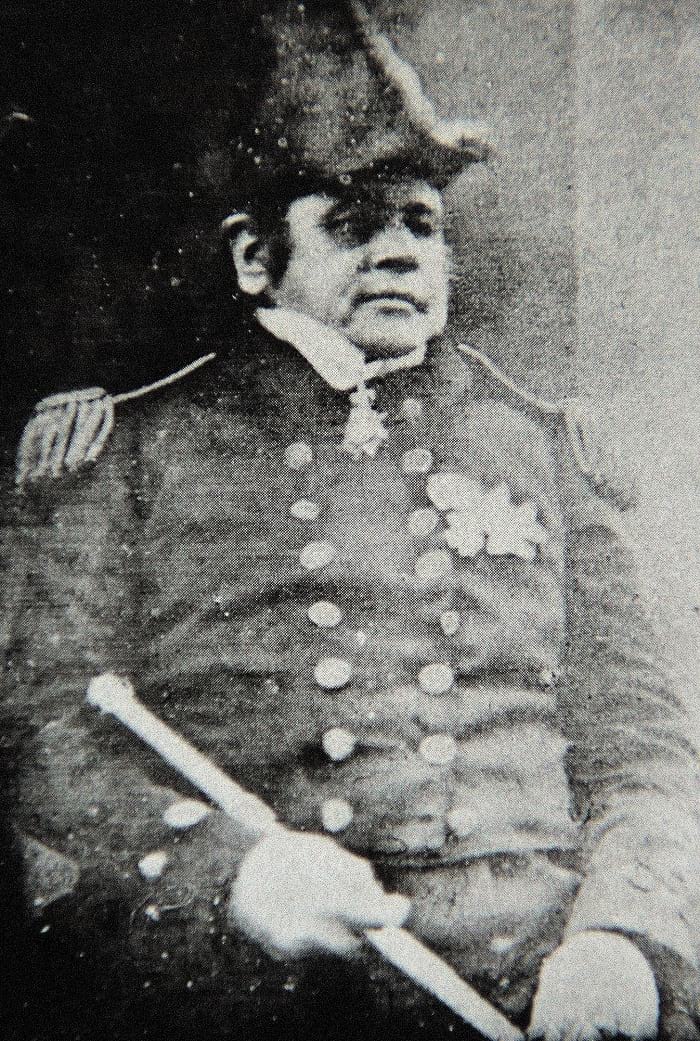
Photo of Sir John Franklin. (Maritim Greenwich Souvenir Guide, London 1993)
Sir John Franklin commandeering over the HMS Terror, and its companionship the HMS Erebus headed the expedition. His second in command, Captain Francis Cozier was in charge of the HMS Terror. Back in 1845, a number of countries sought to establish dominance over new land and sea routes. The Northwest Passage happened to be one of these much sought-after routes, being eyed by multiple nations, including Russia. The two ships, HMS Terror and HMS Erebus, set out to explore this route.

Captain Francis Crozier. (Francis Rawdon Moira Crozier)
Last sightings and cannibalism
The sister vessels HMS Erebus and HMS Terror made certain stops along their way to the Northwest Passage. Among their last stops were Scotland’s Orkney Islands, and Greenland, before the two ships completely disappeared, never to be heard from again. Two whaling ships had last spotted them when the vessels were on their course to Canada’s remote Baffin Island. After a couple of years when they did not return and no contact was made by any of the ship’s crew, search parties were dispatched in order to find them.
Human carcasses and bones were found aboard the shipwreck and scattered around the area where the ship had sunk. Bones were cracked in half according to reports by the local Inuit which led to the presumption that the crew members had resorted to cannibalism for survival. Later in the 1980s and 1990s, remains were found with knife marks on them which indicated dismembering of limbs and the bone marrow of fellow crew members before they were consumed.
Divers and drones
Parks Canada, a Canadian government agency had launched a search expedition for the wreckage in cooperation with the Inuit. Parks Canada archaeologists employed the use of professional divers as well as state of the art drones. Diving did not prove to be especially fruitful, owing to the extreme conditions such as pressure and the freezing temperatures. The use of drones allowed even the most remote areas of the ship, fragile and untouched by humans, to be explored and 3D imaging was used to create a map of the ship. Places like hatchways, crew cabins’ skylights, officers’ mess hall, and the captain’s stateroom were thoroughly looked into for any evidence required to ascertain the reason for sinking.
Eerily enough, all the doors were wide open, but all rooms appear to be unharmed with no signs of violence. Photographs from the wreckage indicated that the ship was in a rather pristine condition, including the condition of the personal belongings of the crew. A letter known as the Victory Point Note was found which had two handwritten messages. The first letter was signed by Franklin, and stated “all well” in May 1847, and the second mentioned that there were two dozen casualties aboard the HMS Terror, including Sir John Franklin in April 1848.
Extraordinary mystery: How did HMS Terror sink?
To this day it remains unknown, why the HMS Terror sank. Despite sustained attempts at researching the wreckage, there was no evidence that could ascertain why either the HMS Terror or the HMS Erebus would sink. They were made to withstand the extreme polar conditions and did so with absolute certainty. Even in the wreckage, all documents, cabinets, drawers etc were in top-notch condition and were in the exact place they were supposed to be in. Lead Archaeologist Ryan Harris said, “I’ve never seen anything like this”.
Three corpses were discovered by American and British search parties in Beechey Island. A 20-year-old was among the three who passed away on January 1, 1846, and was covered in permafrost for nearly 140 years. The autopsy of his malnourished body revealed he suffered from lead poisoning and botulism, which eventually made scientists arrive at the conclusion that the canned food on-board was responsible for causing lead poisoning and botulism amongst the crew.
HMS Terror wreck site & the understanding between Canada and Britain
While the wreckage has been successfully located by officials, its precise location has not been disclosed to prevent it from being looted by sea pirates. As a part of an agreement between Britain and Canada, Britain handed over the wreck of both HMS Erebus and HMS Terror to be placed under the care of the Inuit Heritage Trust, along with most of the artefacts and gold from the ship. Owing to the favourable weather conditions, a number of attempts were made in August 2019 to explore the wreckage further. Due to the layers of silt formed on the wreck which may damage the contents of Captain Francis Crozier’s cabin, Parks Canada is yet to explore that part of the vessel. There is speculation that the Captain’s cabin holds a lot of valuable materials, and also houses the secret behind why the HMS Terror sank.

Dish set from HMS Terror. (Oaktree b / Wikimedia Commons)
The region where the HMS Terror had sunk has been named Terror Bay in its honour. There are no survivor accounts or tangible proof of why the HMS Terror remained in such pristine condition or why it sunk with all its crew members on board. Till future expeditions unearth some new evidence, the HMS terror’s last voyage remains an unexplained mystery.
Trivia: Did you know that the US Presidential office desk is made from a barque-rigged ship called HMS Resolute? HMS Resolute was one among the six ships to be sent out for rescuing Sir John Franklin.
Fact Analysis:
STSTW Media strives to deliver accurate information through careful research. However, things can go wrong. If you find the above article inaccurate or biased, please let us know at [email protected].
RELATED
The post HMS Terror: A British Warship That Was Lost for Over 170 Years appeared first on .
]]>The post Gloomy Sunday: The Hungarian Song that Claims its Listeners Lives appeared first on .
]]>
Grave of Rezső Seress, composer of the Hungarian suicide song “Gloomy Sunday”. (Varga József / Wikimedia Commons)
Gloomy Sunday or Szomorú Vasárnap written by composer Rezso Seress and poet László Jávorin 1932, is a song about mortality. In it, the singer asks his dead lover to meet him at his soon-to-be funeral because he can’t bear to stay apart from her any longer; it appears as though the protagonist is completely broken, and wishes to end his life to be with his love. In general, it really is a heartfelt, remorseful song that tends to transport the listener to a rather uncomfortable space. That said, none could have predicted the dark history that was ready to tie itself to the track.

Rezso Seress, composer of Gloomy Sunday. (Wikimedia Commons)
Making of “Gloomy Sunday” the Hungarian Suicide song
As mentioned above, the song is a melancholic lament that many believe was written by László when his then-girlfriend passed away. However, others are inclined to think that this song was initially written by Seress, about war and catastrophe, and was later changed into a heartbreak ballad by Jávor. Whichever the case may be, the song soon came to known as “The Hungarian Suicide Song,” primarily because over the course of a few years more than 18 suicides would have established strong links to it.
That said, it must be noted that when the song first came out, it hardly made any impact on the music scene in Hungary, nor was it linked to any deaths. It was only when a refined version of the song, recorded by Pál Kálmar hit the market in 1936, that things started to go south.
Notable incidents and ban
The first suicide to be tied to the song was that of a Hungarian shoemaker, named Joseph Keller, who quoted lyrics to Gloomy Sunday in the suicide note that was left next to the scene. Thereafter, several bodies were discovered in the Danube river with the sheet music for the song clutched strongly in their hands. Further, two people apparently shot themselves while listening to a band perform the song live. The rest of the suicides linked to the song appear to have been committed by people while listening to it. Soon, the song became a big topic of discussion in the media and the Hungarian government saw no choice but to ban it in the country.
In a rather bizarre way, it only seems fitting, that almost 30 years later, Seress would end his life by suicide; paying the ultimate homage to the deathly legacy of his own song. The grief-stricken composer, fighting a losing battle with depression decided to jump off the highest storey of his apartment building in Budapest in 1968. While he survived the fall, later in the hospital, Seress eventually ended his life by choking himself with a wire. In his suicide note he wrote:
“I stand in the midst of this deadly success as an accused man. This fatal fame hurts me. I cried all of the disappointments of my heart into this song, and it seems that others with feelings like mine have found their own hurt in it.”
While we still can’t particularly comprehend what in the song drove people to end their lives, it seems like this is one urban legend we cannot deny.
For the lyrics of Gloomy Sunday or to listen to the song click here.
Enjoyed this article? Also, check out “Codex Gigas: The Dark Medieval Manuscript Dubbed as “The Devil’s Bible””.
Fact Analysis:
STSTW Media strives to deliver accurate information through careful research. However, things can go wrong. If you find the above article inaccurate or biased, please let us know at [email protected].
RELATED
The post Gloomy Sunday: The Hungarian Song that Claims its Listeners Lives appeared first on .
]]>The post The Disappearance of Michael Rockefeller: One of the Most Enduring Unsolved Modern Mysteries appeared first on .
]]>
Michael Rockefeller. (HurayforZay / Wikimedia Commons)
Michael Rockefeller was the son of American businessman and future United States Vice-President, Nelson Rockefeller, and was a fourth-generation descendant of the influential and famous Rockefeller family. On 19th November 1961, Michael Rockefeller mysteriously disappeared during an expedition to the Asmat province of Netherlands New Guinea. This region is now a part of the Indonesian province of Papua. His disappearance is one of the most enduring and prominent unsolved mysteries of the 20th century. Michael Rockefeller was neither recovered nor rescued despite an extensive search operation overseen by his father, Nelson Rockefeller.
Michael Rockefeller: An exceptional individual
Michael Rockefeller was the youngest child of Nelson Rockefeller and Mary Todhunter Clark Rockefeller. Rockefeller’s early education was completed at The Buckley School, a premium boarding institution based in upstate New York. After graduating from there, he went on to study at the Phillips Exeter Academy in New Hampshire. Michael Rockefeller was an exceptional student and he was also a student senator and a varsity wrestler. He went on to attend Harvard University and graduated cum laude with a Bachelor of Arts in Economics and History. In 1960, he served in the United States Army as a private for six months.
After his brief military service, he went on an expedition for Harvard’s Peabody Museum of Archaeology and Ethnology to research the Dani tribe of Netherlands, New Guinea in 1960. This expedition produced Dead Birds, a documentary film about the ethnic diversity of the Netherlands-New Guinea people. Rockefeller left this expedition for a brief period, in order to study the Asmat tribe from the southern part of Dutch New Guinea, with a friend. After he returned home from the Peabody Expedition he almost immediately returned to Dutch New Guinea to further study the Asmat people and collect Asmat art.
The disappearance
On November 17, 1961, Michael Rockefeller was 5 kilometres from the New Guinea shore, with the Dutch anthropologist René Wassing, in a pontoon boat. The pontoon boat carrying Rockefeller and Wassing was swamped, and it overturned. René and Michael were set adrift in a dugout canoe that measured up to 40 feet. Their local guides rose to the occasion and tried to swim to their rescue, but were a tad too late. After drifting for some time, Rockefeller abandoned René in the boat and tried to swim to the shore. According to René, Rockefeller had said, “I think I can make it,” before making a break for it. The canoe had drifted away quite a bit, and was now 12 miles (19 km) from the shore. René was rescued the next day, but Michael Rockefeller was never seen again.
Despite an intensive, expensive and lengthy search and rescue effort mounted by Nelson Rockefeller and his considerable resources, Rockefeller’s body was not recovered. At the time, his disappearance was a major news item and can be considered a major point in the popular culture of the 1960s. As the canoe was very far from shore, the most plausible theory about his disappearance is that he succumbed to exhaustion and exposure. This probably led to him drowning.
Speculations about Rockefeller’s disappearance
There is also speculation that Rockefeller might have been attacked and eaten by sharks or saltwater crocodiles. The Betsj River of Western Papua is infested with saltwater crocodiles and sharks, which are hyper carnivorous apex predators. As headhunting and cannibalism were still prevalent in some areas of the Asmat region in 1961, there is also wide speculation that Rockefeller was captured and killed after he arrived onshore.
An American journalist Milt Machlin travelled to the same region in 1969 to investigate Rockefeller’s disappearance. After extensive investigation, he said that there was absolutely no evidence of Rockefeller being held captive or living as a Kurtz-like figure in the jungle. However, he said that there was a lot of circumstantial evidence that pointed to the idea that Rockefeller had been killed.
If Rockefeller had successfully swum to the Asmat shore, he would have arrived at the village of Otsjanep. A few months before his disappearance, several of the village elders had been killed by the imperial Dutch patrol. This provides some rationale that Rockefeller might have been killed by the Asmat people of Otsjanep as retribution. Experts say that the Asmat did not practice headhunting and cannibalism indiscriminately. Instead, the tribe only indulged in such practices for the sake of vengeance or retribution, in a vicious tit-for-tat style. It is actually quite plausible that Michael Rockefeller found himself to be an inadvertent victim of the tribe’s thirst for vengeance.
Discourse about Rockefeller in popular culture
Author Paul Toohey opined that Michael Rockefeller’s mother had solicited the services of a private investigator to investigate Rockefeller’s disappearance, in his book Rocky Goes West. Whether these claims have any truth in them is debatable, but Toohey was certain in the knowledge of the Private Investigator bartering a boat engine with the Asmat tribe, in exchange of the skulls of three men. Toohey believed, these skulls belonged to the only white men who ever fell victim to the tribe. The Investigator thereafter returned to New York and presented the skulls to Mrs Rockefeller as proof of her son’s demise. The veracity of this incident has never been proven but the History Channel reported that Mrs Rockefeller did pay a $250,000 reward to a private investigator for the final proof that her son had expired.
Keep The River On Your Right is an acclaimed documentary film where the anthropologist Tobias Schneebaum alleges that he spoke to Asmat tribesmen who recalled finding Rockefeller washed up on the riverside and eating him. In 2014, the author and investigator Carl Hoffman published a book about his investigation into Rockefeller’s disappearance. During his many visits to the village of Otsjanep, Hoffman heard stories of Rockefeller being captured and killed after washing up on the Asmat shore.
Many of the artefacts and art collected by Rockefeller are now on display at the Metropolitan Museum of Art, which is one of the world’s most renowned art museums located in New York City. His work is under the “Michael C. Rockefeller Wing”. The disappearance of Michael Rockefeller became a major event in the popular culture of the 1960s and the entire 20th century. There have been numerous books, documentaries, comics and films made that chronicle the disappearance and provide theories as to how it might have happened. In 2012, Michael Rockefeller’s twin sister Mary Rockefeller published an autobiography and memoir titled When Grief Calls Forth the Healing.
Enjoyed this article? Also, check out “Bohemian Grove: A Club for the Rich and Powerful or an All-Male Secret Society?“
Fact Analysis:
STSTW Media strives to deliver accurate information through careful research. However, things can go wrong. If you find the above article inaccurate or biased, please let us know at [email protected].
RELATED
The post The Disappearance of Michael Rockefeller: One of the Most Enduring Unsolved Modern Mysteries appeared first on .
]]>The post An Unsolved Historical Mystery – The Lost Roanoke Colony of America appeared first on .
]]>
The word “CROATOAN” carved on a tree trunk. (Wikipedia Commons)
The Lost Roanoke Colony of America remains one of the fascinating mysteries of the continent. Over the years, researchers have suggested various theories to explain the disappearance of the English settlers that had settled on Roanoke Island. However, these theories only raise further questions, and there is no way of really knowing what might have happened to those people.
The first Roanoke Colony of America
In 1584, Queen Elizabeth I ruled over England, and English mariners sailed across the ocean to seek adventure and fortune. At this time, the notion of exploring and settling in the New World took root, and Queen Elizabeth I showed her approval by granting suitable rewards.
Sir Water Raleigh received a charter to settle English people in the Chesapeake Bay, and he dispatched Sir Richard Grenville with a group of settlers. They arrived on Roanoke Island, which is off the coast from present-day North Carolina, and were impressed by the rich natural bounty of the land. Also, the local Indian tribes appeared to be friendly, and there weren’t any impediments in the way of building a permanent base on the island. The men constructed their settlement and prepared to remain there for the long haul.
Unfortunately, they were not prepared to live in harmony with their Native Indian neighbours. In their long history of colonialism, the English have shown a tendency to appropriate the natural resources for themselves and to leave as little as possible for the native people. They followed the same pattern on Roanoke Island. As a result, ill will soon be developed between the settlers and the local Carolina Algonquins. Things escalated to the point that the settlers ended up burning a village of the Carolina Algonquins. The latter stepped up the hostilities, and the settlement failed.
The second Roanoke Colony of America
The second group of settlers, under Sir Ralph Lane, arrived in 1585. The scientist-mathematician, Thomas Harriot, and the artist, John White, were two prominent members of this group.
Thomas Harriot drew maps of Roanoke Island and catalogued the local birds and plants. He also persuaded two Native Indians, Manteo and Wanchese, to teach him their Algonquin language. Meanwhile, John White spent his time drawing and painting the Carolina Algonquin Indians and recording their habits and customs.

Engraving by Theodor de Bry based on the map of the coast of Virginia and North Carolina drawn by John White. (Theodor de Bry / Wikimedia Commons)
As with the first party of settlers, however, the initial enthusiasm of the settlers soon waned. They did not succeed in cultivating the land and ran out of resources they had brought with them. Moreover, they too were unable to retain friendly relations with the Native Indians.
After a year, most of the settlers, including Harriot and White, were ready to throw in the towel and head back to Merrie England. Fortunately for them, Sir Francis Drake, an English naval officer, was returning home from the Caribbean at this time. When he stopped by at Roanoke Island to replenish his ship’s water supplies, he agreed to take the settlers back with him.
Fifteen die-hards decided to remain behind and keep the flag flying, but this turned out to be a terrible decision. By the time the next batch of settlers arrived in 1587, these men were no longer alive. The new arrivals learned from some friendly natives that the men had been attacked and killed by their hostile neighbors.
The third Roanoke Colony of America
The earlier failure to settle on Roanoke Island hadn’t doused John White’s adventurous spirit. Back in England, he set about persuading people to join him to form a new settlement in the New World. His mentor, Sir Walter Raleigh, and Queen Elizabeth I approved of the plan and proclaimed him the new Governor of the still-to-be founded new settlement.
Early in May 1587, John White set sail from England with 115 prospective settlers. Included in this group were his wife Tomasyn, his newlywed daughter Eleanor, and his son-in-law Ananias Dare. Their destination was the Chesapeake Bay, but their ship’s navigator foiled that plan.
He was a Portuguese sailor named Simon Fernandez, whose ill-temper and unpleasant attitude had already created tensions with the passengers; they referred to him as The Swine amongst themselves. When they stopped over for water at Roanoke Island on July 1587 en route to the Chesapeake Bay, he let the passengers disembark there for a rest. However, he then announced that he was not going to proceed to the Chesapeake Bay and refused to let them back on board. He abandoned them and sailed back to England. Thus, they were forced to remain on Roanoke Island.
Settler’s life on Roanoke Island
From the beginning, the settlers made things difficult for themselves. John White’s previous acquaintance, Chief Manteo, told him that the Dasamongueponke and other hostile Indians had treacherously killed the 15 Englishmen that had remained on the island. Since the settlers had arrived too late to do any planting and had a lot of time on their hands, they decided to avenge their compatriots. At dawn, on 8 August 1587, they raided and destroyed what they took to be the Dasamongueponke village. Unfortunately, it turned out to have belonged to a friendly tribe that, for obvious reasons, turned hostile on them from then on.
To make things worse, the settlers soon discovered that their supplies had begun to run out; the supplies were insufficient to begin with and, moreover, with no planting done, a food shortage loomed ahead. Worried about their future on the island, particularly with winter approaching, the settlers held a meeting and decided to appeal to Sir Walter Raleigh for assistance. For this purpose, they decided to send John White back to England.
John White returns to England
John White was not eager to leave his family. His daughter, Eleanor, had just given birth to his granddaughter. Named Virginia Dare, she was the first English child to be born in the New World. Also, he was worried about what would happen to his belongings in his absence. After the settlers assured him that they would care for his property while he was gone, he agreed to take on the mission. He departed for England and had a hard voyage back.
He arrived in England in October 1587 and learned that Queen Elizabeth I had forbidden all English ships from leaving the English shore. An invasion from the Spanish Armada was imminent, and it was crucial to have all available ships at hand to face the attack. That meant that John White couldn’t find a supply ship to sail back to Roanoke Island.
Desperately worried about his family, White finally found two small pinnaces. However, his attempt to sail them across the Atlantic was unsuccessful. First of all, the pinnaces were not suitable for a long ocean journey. Secondly, when they set off, French pirates attacked and looted the pinnaces. In that scuffle, as he later noted himself, John White was unfortunate enough to get shot ‘in the side of the buttoke’. He and his crew somehow managed to escape back to England, but the piracy left him without the resources to begin another journey.
It wasn’t until 1590, with Sir Walter Raleigh’s assistance, that he was able to get two ships, Hopewell and Moonlight, and endure another eventful journey to return to Roanoke Island.
The abandoned settlement on Roanoke Island
After a rough landing, the rescue expedition arrived at the settlement to find it completely abandoned. All the structures had either been taken down or were in a ruined state. The rescuers found the word ‘Croatoan’ carved on a tree trunk in the fort. Other than these, there were no other clues about the whereabouts of the settlers.
Since Croatoan was the name of a friendly tribe from the nearby Hatteras island, the rescuers assumed that perhaps the settlers had moved there to live with them. However, due to bad weather, White and the others couldn’t explore further, and they had to return to England.
Subsequent expeditions to find the lost settlers failed to find any traces of them, and after years of unsuccessful searching, everyone presumed that they had all died. Different theories circulated about how this might have happened. Perhaps they had starved to death or met with an accident in the wilderness. Maybe the hostile tribes had attacked and massacred everyone. Or, they had left to integrate and intermarry with friendly tribes further away.
It was also possible that they had been taken captive by the hostile tribes and sold as slaves. For many years, there were reported sightings of white people in various Native Indian camps, but nobody was ever able to verify if these were true.
In more modern times, researchers have attempted to examine DNA samples taken from local people to discover traces of the white settler of Roanoke Island. However, so far, nobody has been able to find a conclusive answer to the mysterious disappearance of the settlers on Roanoke Island.
Enjoyed this article? Also, check out “The Baffling Oak Island Treasure Trove Mystery“.
Fact Analysis:
STSTW Media strives to deliver accurate information through careful research. However, things can go wrong. If you find the above article inaccurate or biased, please let us know at [email protected].
 Recommended Read:
Recommended Read:
A Kingdom Strange: The Brief and Tragic History of the Lost Colony of Roanoke | By James Horn
Genre:
Non-fiction > History
RELATED
The post An Unsolved Historical Mystery – The Lost Roanoke Colony of America appeared first on .
]]>The post The Philadelphia Experiment: When an American Navy ship Supposedly Teleported appeared first on .
]]>
USS Eldridge, ca. 1944. (National Archives and Records Administration)
In October 1943, the United States Navy is believed to have intentionally teleported the US Navy destroyer escort ‘USS Eldridge’ from Philadelphia to Norfolk and back in a flash. Some people believe the incident was a hoax. Others believed that it was a figment of the imagination of a ravings lunatic.
But, some other continue to believe that the teleporting of the USS Eldridge did occur and feel that there is a large conspiracy around it only to cover it up.
An American legend
Whatever may be the case, the story of the Philadelphia Experiment has become an American legend. So, is it a real story?
The plausibility that the Philadelphia Experiment did happen is backed by the clear public mistrust of the American federal government and the US Defense forces.
The two individual bodies had over years admitted to carrying out innumerable unethical experiments either on their own citizens or on their soldiers.
It is interesting to note that the claims of the experiment’s legitimacy are linked to Albert Einstein and to a secret technology that has a scientific theory. But, it continues to remain out of reach for the scientific community even today.
Einstein’s “unified field theory”
The experiment is believed to be based on Einstein’s “unified field theory” (UFT). The UFT was never proven by Einstein or anybody else. The theory attempts to join together the forces of electromagnetism and gravity into one fundamental field.
The UFT basically explains everything about the very nature of the universe, about human beings, how we are made of and where we come from.
Also that everything is connected. UFT points out that there are infinite beings living in an infinite universe and that we have an infinite relationship with them at all scales and all times. Because everything in this world is connected by space and it goes into the nature of what that space is. How that space is structured? The dynamics in the space. The density of the space. The geometry of the space.
The Philadelphia Experiment
A few weeks later, on October 28 of 1943, the experiment was conducted again. In Norfolk, Virginia, some men aboard the SS Andrew Furuseth are believed to have seen a ship suddenly appear in the water in Norfolk. The disappearance from Philadelphia and then the teleportation to Norfolk are said to be two dissimilar functions of the Philadelphia Experiment.
Meaning, the disappearance may not have been the result of the teleportation. Rather it came before it.
Soon after the USS Eldridge reached Norfolk waters, it is believed that something went strangely wrong. Some of the sailors just vanished during the trip. Some others are believed to have gone mad. Few more kept becoming invisible only to reappear later on.
A different version of the Philadelphia Experiment
As per a different version of the Philadelphia Experiment, the USS Eldridge was fitted with large generators. This was part of a top-secret mission. The idea was to win the Battle of the Atlantic at any cost.
As per rumours aboard the ship, the generators were believed to have been designed to power a new kind of magnetic field. This could make the warship invisible to radar technology of the enemy. It was time to test the system in broad daylight with the full crew on board. The powerful generators were switched on and they hummed into action.
What happened next is said to have baffled scientists and spread rumours for decades.
As per eye-witnesses, an eerie green-blue glow surrounded the hull of the battleship. Then, in an inexplicable manner and instantaneously the Eldridge is said to have vanished into thin air.
Several hours later, reports on the Eldridge briefly appearing in the Norfolk Naval Shipyard and immediately reappearing back at Philadelphia spread far and wide.
As per classified military reports, crew members of the battleship suffered from horrifying burns and even disorientation. Some more were believed to have become fused with the ship.
Either this is a true incident or it could also be a false story.
Carlos Allende claims to be a witness to the experiment
A decade after the experiment is believed to have taken place; the story of the Philadelphia Experiment came to light through a disreputable man called Carlos Allende (pseudonym) or Carl M. Allen.
Writing a detailed description of the experiment in his 50 handwritten letters, Carlos claimed he was a witness aboard the SS Andrew Furuseth when the USS Eldridge got teleported to Norfolk and back.
He mailed his description to the US Navy’s Office of Naval Research and author and amateur astronomer Morris K. Jessup. A year earlier, Jessup had published a book titled “The Case for the UFO”. In his letters, Carlos is said to have criticised Jessup’s understanding of UFT.
Soon after that, common people got hold of it, and the story took off in spite of the several unlikely developments described in Carlos’s letter.
A conspiracy is born
It was Carlos who claimed that the Philadelphia Experiment was made possible by Einstein’s UFT. In order to prove that a UFT existed, Allende is said to have told Jessup in his letters of his eyewitness account of the disappearance of the Eldridge from the Philadelphia in 1943.
Carlos’s letter is said to have explained how the US military used Einstein’s theory to teleport an entire naval destroyer along with its crew. This is the first-ever written statement on the Philadelphia Experiment. Strangely, though, there were no other witnesses of the alleged event.
Jessup is believed to have attempted a investigate Carlos’s claims, but dropped the idea in the late 1950s. Sadly, though, Jessup got badly hurt in a car accident and in 1959 committed suicide. Carlos, however, continued to live until 1994. He never gave up his habit of writing letters to anyone who showed interest in his bizarre tale of the Philadelphia Experiment.
No evidence of teleporting
Like most US Navy ships in war times, The USS Eldridge had a detailed log of where it was positioned in October of 1943. These logs are open to common people to study.
As per the logs, USS Eldridge was not in Philadelphia waters in October of 1943. The SS Andrew Furuseth was also not stationed in Norfolk waters when the Eldridge was there.
Other evidence shows that the experiment did not take place. A man named Lieutenant Junior Grade William S. Dodge, who commanded a Liberty ship at the time of the teleporting experiment, claimed in his letter that neither his crew nor he ever saw any strange developments at Norfolk in Virginia.
Following these developments, the Office of Naval Research, US investigate the issue, but they failed to find any evidence of the experiments in teleportation.
For the American Navy, the Philadelphia Experiment did not happen
It is always interesting or exciting to talk of invisible ships. But the truth is not as we expect. So, as far as the American Navy is concerned, the Philadelphia Experiment did not take place and the teleporting technology does not exist.
However, one cannot put down a good hoax like the Philadelphia Experiment. It has all of the signs of a lie:
1) a single witness, 2) a secret government plot, and 3) pseudoscientific revelations possibly from alien sources.
Interestingly, the World Wide Web is certainly home to dozens of dubious websites that are dedicated to the unknown facts on the Philadelphia Experiment.
Film on Philadelphia Experiment
In 1984, the Philadelphia Experiment was popularised in a bizarre but low-budget film. Later, in 2012 there was a sequel on Syfy channel movie on the subject.
In the 1984 movie titled “The Philadelphia Experiment,” two men on a ship travel forward in time as a result of the experiment. The film, directed by Stewart Raffill, was written by Michael Janover (screenplay) and William Gray (screenplay). Actors Michael Paré, Nancy Allen and Eric Christmas starred in the movie.
The fate of the USS Eldridge
The fate of the USS Eldridge was more or less short-lived. Official records show that in 1951 the ship was given to Greece. There it was renamed as HS Leon. Greece engaged the ship in several Cold War missions. Later, it was decommissioned and sold as scrap. Overall, the ship was in service for 50 years.
Enjoyed this article? Also, check out “Battle of Los Angeles: When the City Fought a Bizarre Battle with Nobody“.
Fact Analysis:
STSTW Media strives to deliver accurate information through careful research. However, things can go wrong. If you find the above article inaccurate or biased, please let us know at [email protected].
RELATED
The post The Philadelphia Experiment: When an American Navy ship Supposedly Teleported appeared first on .
]]>The post Phantom Island: The Islands that Might Have Existed Only in the Imagination appeared first on .
]]>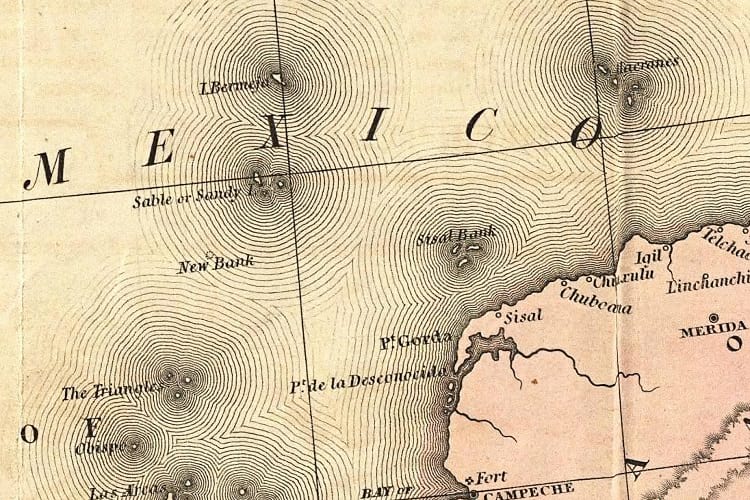
An old map showing Bermeja, a phantom island near Mexico. (Tanner, Henry S.)
Phantom islands are islands that once appeared on nautical charts and maps but do not actually exist. There are various reasons for this. Some islands may have been purely mythical creations from old legends. Others may be deliberate fabrications, while others are geographical errors, optical illusions, or lands lost due to natural catastrophes.
Phantom Islands and the age of exploration
The Age of Exploration was a grand period in the history of mankind. The earth and its realms were a mystery to most people back then. There were many things they didn’t understand, and they tried to explain these with legends and fantasies.
As you can imagine, discovering new lands was a big deal in those times. It turned you into a hero overnight. And, if your home country’s reigning royalty didn’t try to steal your thunder, you could even name the new land after yourself. That could ensure your family was set for the next seven generations at least.
Despite such an incentive, comparatively few brave men actually set forth to traverse the vast oceans and make these new discoveries. The rest of the public remained safely at home and eagerly awaited their return and lapped up their tales of exciting adventures and marvellous sights. Naturally, some of these adventurers couldn’t resist playing to the galley and embroidering their trials and escapades to a good extent. In short, they added fuel to the existing legends.
It was easier to tell tall tales than to discover new lands. Often, to keep up and enhance their prestige, many of the voyagers outright lied about coming across an island or two. Travelling across the seemingly unending oceans for months on end was no child’s play. Sometimes you were glad to settle for an island, even if it was only a phantom island. Back then, nobody was going to take the next boat to go verify it after all. Or, if they did, there could always be a reasonable explanation for not finding it. Moreover, they could return with tales of phantom islands of their own.
Phantom Islands and nautical charts
In the Western world, the earliest Greek and Phoenician ocean farers began the practice of mapping the world. Piece by piece they tried to put together an entire picture of the earth. Other ocean farers that followed then made use of these charts to navigate the oceans. Furthermore, they added to them as they came across previously uncharted territories.
As a result of this practice, phantom islands also found their way on nautical charts.
However, all these phantom islands were not fabrications. Some were actual islands, but the voyagers got their geographical locations wrong. Or, they were actual islands that later disappeared into the ocean due to volcanic eruptions, underwater landslides, or some other natural disasters. In some cases, the voyagers mistook sandbars, icebergs, floating pumice from underwater volcanoes, and other debris for islands. In other cases, they didn’t survey the land correctly and mistook land that was actually connected to a larger landmass to be an island. Sometimes, the islands they thought they saw were only mirages or optical illusions.
Apart from the voyagers that reported these islands, nobody else was able to find or reach them again.
Despite this, many of these islands remained put on the nautical charts for many centuries. Even if other people couldn’t find them, they retained the hope they might someday be able to do so.
There are several hundred instances of phantom islands from the ages of antiquity to more modern times.
The last phantom island was Emerald Island, said to be near New Zealand. It even appeared in many atlases until 1987.
Famous Phantom Islands
Mythical Islands
The Greek poets Homer and Horace created poems on mythical islands like the Isles of Blest. Also known as the Fortunate Islands, these were supposedly Utopian islands where hardships were unknown. Of course, no human ship managed to sight, never mind land on, these fabled phantom islands.
Another famous island of legend was Atlantis. Plato mentions its existence and how it ultimately sank under the sea. The legend of Atlantis persists to the present day and many modern underwater explorers have had a go at finding it on the ocean floor. So far, nobody has been able to find anything that we can with a great degree of accuracy assume to have been Atlantis.
Actual Islands that were misidentified or were subject to geographical errors
In the 4th century BCE, Pytheas, an ancient Greek seafarer, arrived on an island he called Thule. Nobody else ever found it, but, since ancient times to the present age, explorers have argued that Thule was either Scandinavia, Iceland, or the Shetland Islands. Some say it didn’t even exist except in its discoverer’s salt-encrusted imagination.
For quite a long while, Pepys Island figured on the charts. Later, explorers discovered that it was not a different place. Just a different name for the Falkland Islands.
When early explorers to the American continent arrived in the Baja California Peninsula, they did not realize that it was connected to the mainland. Instead, they took it to be an island and noted it on the map as such.
Captain James Cook made a similar mistake when he landed on the Banks Peninsula in New Zealand. He mistook the 1150 square kilometres land mass to be a separate island, when, in fact, it is connected to New Zealand’s South Island on its eastern coast.
Islands that only their discoverers found
Ever heard of New South Greenland? It was also known as Morrell’s land after its discoverer, Benjamin Morrell. While captaining the Wasp schooner on a voyage of exploration in Antarctica’s Weddell Sea, he made his discovery in March 1823. According to the account he gave, his schooner sailed along 480 kilometres along the island’s coastline. He gave details of this and also marked the precise coordinates of the land. Nobody doubted his discovery and New South Greenland was duly added to the ever-expanding world nautical chart. However, in the 20th century, voyages to Antarctica proved conclusively that there was no such land. Captain Morrell, it turned out, was just another one in a long line of fabricators.
Islands that might have existed but no longer do
Spanish explorers of the 16th century came across Bermeja Island along the Yucatan peninsula’s north coast. In 1539, Alonso de Santa Cruz included the island in his El Yucatán e Islas Adyacentes. By 1844, however, British cartographers reported it had sunk underwater. There have been various theories about its disappearance. The best one involves the CIA—they sank it to extend the USA’s economic zone.
In 1825, George Norris, a captain of a whaling ship, came across Thompson Island in the South Atlantic Ocean. Another vessel reported sighting the island in 1893. Nobody ever saw it again thereafter. Researchers think it probably sank into the ocean after a volcanic eruption. However, until 1943, the world maps continued to include it.
Writer’s opinion
Phantom islands are a relic of a bygone era when one could cast an eye at the horizon and wonder about magical, mysterious lands that might exist way beyond. We now live in a somewhat more jaded age where some scientists actually think that there is nothing more for us to discover. They talk of ‘settled science’. Well, folks, nothing is that settled. As long as we are alive, there are discoveries to be made, even if only on the personal level.
Enjoyed this article? Also, check out “When Default Becomes De facto: Island of California, the Cartographic Mistake Which Became the Gospel Truth“.
Fact Analysis:
STSTW Media strives to deliver accurate information through careful research. However, things can go wrong. If you find the above article inaccurate or biased, please let us know at [email protected].
RELATED
The post Phantom Island: The Islands that Might Have Existed Only in the Imagination appeared first on .
]]>The post Min Min Light: The Elusive Phantom-Lights of the Australian Outbacks appeared first on .
]]>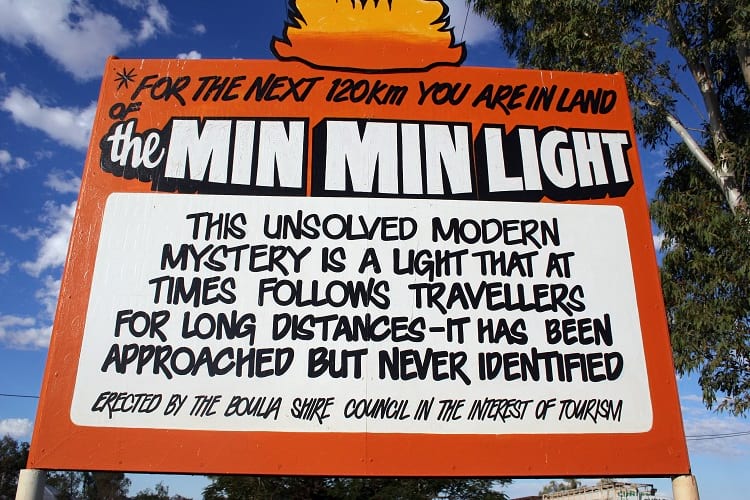
Min Min light sign in Boulia, Queensland, Australia. (www.gondwananet.com)
The small outback town of Boulia in Queensland, Australia, is home to a peculiar phenomenon that has been spooking trespassers for ages. These sentient ‘ghostly orbs of light’, dubbed Min Min light by the locals, are usually described as about the size of a football, and can grow in size or brightness, as well as alter in colour, while they follow the travellers in their path.
Though these Lights were first documented by Europeans in 1838 (in the book “Six Months in South Australia”) after the colonization of Australia, they have been prominent in Aboriginal lores for aeons before. The cause of this mysterious phenomenon has eluded scientists as well as conspiracy theorists since its discovery.
The Stockman’s report
The origin behind the name of the Min Min Light, revealed in a Sydney Morning Herald article about an eyewitness’ account, is in itself quite interesting. Published on January 25, 1947, the story states the account of a local stockman who claimed he was followed by these lights on his way to Boulia.
The Min Min Hotel, burnt down in 1918, was notorious in the era as a den for modified alcohol and drugs, where a lot of people died over the years in brawls, murdered by robbers, or from the use of drugs and tainted alcohol, and were buried behind the hotel. The graveyard remains to this day.
The Stockman (who gave his story for the article) had passed by the area shortly after the infamous hotel had burnt down, and he witnessed a “strange glow appear right in the middle of the cemetery” which “got bigger, till it was about the size of a watermelon” as quoted to the police. He claimed to have tried to ride away, but kept being pursued by the phantom lights till he arrived at the town boundary. The police had not believed his account, but there have been thousands of alleged sightings since the Stockman’s report. The name of the bewildering ghostly lights stems from this mysterious Min Min Hotel around which the sightings were reported.
Regional folklore
Word about the Min Min Light has been a part of local folklore for centuries before the Stockman’s report. The stories date back so far that it is difficult to ascertain an exact timeline of the sightings, having passed on through the oral traditions of the Aboriginals.
The Aboriginal Australians have always been wary, and have consistently believed that the lights were the spirits of their dead ancestors risen from their graves. This theory got a further boost with the increase in sightings of these phantom lights in the Boulia region after Europeans started killing off the Aborigines. The natives believed their ancestors had risen to avenge the atrocities against the community.
Phantom lights around the world
The Min Min Light have also been reportedly spotted in other regions of Australia such as the Northern Territory, and northern New South Wales. In fact, stories of such phantom lights have cropped up in the folklore of numerous cultures around the world, most notably in the Celtic culture of Ireland, Scotland, and Wales. Popularly known as ‘Will-o’-Wisp’, these orbs appear mostly around bogs and marshes, and believed to be fairies or spirits. The popular Jack-o’-Lantern Halloween decoration stems from this folktale. Other names associated with this phenomenon include ‘fairy lights’, ‘ghost lights’, and ‘ignis fatuus’. Other sightings of this phenomenon include that of ‘Luz Mala’ (‘evil light’) in Southern American countries and the ‘Brujas’ of Mexico (believed to be witch souls), both rural phenomena that are associated with negative superstitions and are part of the local folklore.
Fact or fiction?
The theories about the origin of these mysterious glowing orbs are endless, though none of them are definite. Barring the superstition discussed already, conjectures range from firefly-like bioluminescent insects, to UFOs and aliens, to the result of gaseous releases from the earth, such as those often seen at graveyards.
One of the most popular scientific theories backing the appearance of the Min Min Light is that of the Fata Morgana, hypothesized by Professor Jack Pettigrew, Emeritus Professor of Physiology and Director of the Vision, Touch and Hearing Research Centre at the University of Queensland.
Professor Pettigrew has had multiple encounters with these lights, which he had initially thought to be the planet Venus, or a cat’s glowing eyes, but then carried out extensive research and narrowed it down to a kind of mirage caused by temperature inversions when a layer of dense cold air is trapped under a layer of warm air. He called this optical phenomenon the Fata Morgana and explained that in such situations the light passing through the layers of air undergo steep refraction, making it seem as though the image is floating above the horizon or in front of the person. The Boulia region is especially conducive to this optical illusion because of the gullies and flat surfaces which can effectively trap the cool air.
The Professor backs his theory with an experiment where he recreated the appearance of the Min Min Light: while driving a car for 10kms in the requisite weather conditions with the headlights on, 6 witnesses believed they saw the phantom lights. Well-known Australian scientists such as Dr. Karl Kruszelnicki have vouched for Professor Pettigrew’s research.
The cultural impact of Min Min Light
Though the mystery of the Min Min Light of Boulia seems to be apparently resolved, it will continue to be passed down the generations. Whether it is parents frightening their children with this Bogeyman-like legend, or a reminder of the rich oral traditions of the Aborigines, the Min Min Light have undoubtedly taken on a cultural importance in Australia, featuring in books like those of Mavis Thorpe Clarke’s “The Min Min” (1967) and “Trust the Dream” (2004), and in popular Australian television series like “McLeod’s Daughters” and “Wolf Creek”.
Enjoyed this article? Also, check out “The Classic Whodunit Mystery of the Marree Man of Outback Australia“.
Fact Analysis:
STSTW Media strives to deliver accurate information through careful research. However, things can go wrong. If you find the above article inaccurate or biased, please let us know at [email protected].
RELATED
The post Min Min Light: The Elusive Phantom-Lights of the Australian Outbacks appeared first on .
]]>The post The Hum: The Mystery Behind a Humming Noise that Can Be Heard Worldwide appeared first on .
]]> The phenomenon called the Hum is an invasive and persistent low-frequency humming or a rumbling noise which is generally not audible to most people. Scientists say that up to 4% of the people on the Earth can hear the strange and low-pitched Hum.
The phenomenon called the Hum is an invasive and persistent low-frequency humming or a rumbling noise which is generally not audible to most people. Scientists say that up to 4% of the people on the Earth can hear the strange and low-pitched Hum.
According to researchers, the hum can be heard like the sound of static on an old television set that is slowed down at least 10,000 times.
A seismologist at Columbia University, Spahr Webb says, it is false to imagine that the Earth is solid and immovable. In fact, it is compressing, vibrating and stretching. The Earth, Spahr claims, is constantly ringing like a bell.
The seismologist says for various reasons the Earth vibrates at different amplitudes and frequencies. But, he says, not all such vibrations can be bracketed as the ‘hum’. Some of the vibrations could result in earthquakes that cause huge gong bangs.
Theories & research
Seismologists and scientists alike still do not know the cause of the hum. According to some theories, the hum could be the echo of colliding ocean waves or unknown movements in the environment.
Scientists feel if they can hear the humming music more audibly, deep secrets from inside the Earth can be revealed. If that happens, they feel, it would be easy for them to map out the alien planets. Interestingly, the scientists say the hum is getting louder and clearer day by day.
The mysterious hum has been recorded everywhere including in places like Antarctica, Algeria the United Kingdom and the United States of America.
The American geologist and geophysicist David Deming did a study in 2004 on the earliest reports of the hum phenomenon. He found that the first reliable report of the phenomenon dates back to the late 60s and early 1970s in the UK.
During 1998, a research team of the University of California Santa Barbara analysed the data from east of Antarctica. They found that some of the humming sounds actually don’t stop indicating that they are continuous signals.
In 2001, the team recounted that the humming waves were between 2 to 7 millihertz, which is vastly lower than the range of human hearing.
Primary cause
During the 21st century, seismologist Webb was a key researcher in studying the cause of the hum of the Earth. According to Webb, the primary cause of the hum phenomenon was the ocean wave that banged on the sea floor around the Earth.
Webb also observed that the hum is also the result of the ocean waves sloshing in opposite directions and transmitting vibrations into Earth’s crust. The observation could be an important step in understanding the mysterious Hum.
Whatever may be the cause of the hum, the harmony of low frequencies is invaluable to scientists who want to know what happens beneath Earth’s surface.
Research limitations & evidence
However, for years scientists had limitations in studying the Earth. Because almost three-quarters of the Earth is underwater.
A new study by geophysicist Martha Deen has made attempts to overcome these limitations. Martha’s team from the Paris Institute of Earth Physics recently published its study on the hum in the American Geophysical Union’s journal.
Several years ago, Martha’s team had placed several seismometer stations in the Indian Ocean near Madagascar. The seismometer stations were basically to study volcanic hot spots and not about the hum. But, when they cleaned the data, they realized they had the first-ever underwater recording of the hum.
The humming noise rose sharply between 2.9 and 4.5 millihertz, the data revealed. The readings were similar to measurements taken from Algeria’s a land-based station.
The Hum hearer
As mentioned earlier, few people can hear the hum. Simon Payne of Cambridgeshire is one such hearer of the mysterious Hum.
Most of the hearers are reported to be from the urban areas and they are said to be suffering from symptoms of insomnia, headaches and dizziness. Geoscientist David Deming was himself a hum hearer. He was, however, unable to find the source of the mystery hum.
In 2012, after hearing the hum, former university lecturer Glen MacPherson decided to get to the bottom of this phenomenon. In the process, he developed the World Hum Map and Database. It is an interactive map that continues to accumulate the experiences of thousands of hearers from across the Earth.
Otoacoustic phenomenon
As per some interesting characteristics of the mysterious hum, the noise follows hearers wherever they go. Only they can hear the hum and nobody else. This could be a typical otoacoustic phenomenon originating from the brain and the auditory organs.
Cracking the mystery of the world hum is not that easy. It has been a mystery for over 50 years. It may remain so for a longer period.
Enjoyed this article? Also, check out “Edinburgh’s Miniature Coffins – The Mysterious Lilliputian Coffins, Discovered in Scotland“.
Fact Analysis:
STSTW Media strives to deliver accurate information through careful research. However, things can go wrong. If you find the above article inaccurate or biased, please let us know at [email protected].
RELATED
The post The Hum: The Mystery Behind a Humming Noise that Can Be Heard Worldwide appeared first on .
]]>The post The Unsolved Mystery Behind the Devil’s Tramping Ground in North Carolina appeared first on .
]]>
Devil’s Tramping Ground. (Jdhorne / Wikimedia Commons)
Devil’s Tramping Ground is an empty 40 ft in diameter circular patch of woods that is barren of plant life. The US state of North Carolina appears to be a place full of startling and amazing natural phenomena. One such phenomenon was the vanishing of the first English colony in North America. The colony was established in 1585 on Roanoke Island in Dare County of North Carolina. Sir Walter Raleigh had sponsored the colony.
There was no trace of the mysteriously vanishing of the colony, except for the word “Croatoan“, which was scrawled on a tree.
The Devil’s Tramping Ground
Another popular haunting mystery of North Carolina is the Devil’s Tramping Ground in Chatham County. It is one of NC’s famous ghost stories that remain a scientific mystery even today.
Devil’s Tramping Ground is approximately 80 km south of Greensboro and roughly 12 km off the State Route 902. There is a sign that says “The Chatham County Vortex,” and points towards the haunting site.
Legend says at the stroke of 12 every midnight the devil sneaks up one path, stomps around in a circle for a while and then leaves along a second path. In the process, the devil kills all life within the circle.

Devil’s Tramping Ground, North Carolina. (DrStew82 / Wikimedia Commons)
Classic stories
Several other explanations have been given for the barrenness of the circular tramping ground.
According to one classic version, the ground was the site of a battle between two rival native Indian tribes. Blood spilt and socked the ground during the gory battle. Ever since then nothing ever grew on the site.
Another version says the location was the burial ground of Croatan, one of the greatest Indian tribal chief. Out of respect for the chief, the Indian gods are keeping the site barren.
A modern-day explanation for the barrenness of the Devil’s Tramping Ground is that it was the site of the landing of a UFO. Radiation from the UFO’s engines is said to have permanently destroyed the fertility of the site.
Scot-Irish settlers
The obsession with the supernatural appears to have started with the arrival of the settlers from England, Scotland and Ireland. These immigrants arrived during the 18th century and settled along the course of the Cape Fear River. Especially in places like the Appalachians and the Uwharries.
Along with their personal possessions, the immigrants brought in their faiths and beliefs like the devil. The devil was a major part of their culture. They were genuinely obsessed with the supernatural, ghosts, witches and goblins. Such demon-haunted immigrants came to America.
It is but natural that much of North Carolina’s folklore originated from the Scot-Irish mindset. The Scot-Irish were such people that they named any strange place after the devil. There are several such locations in North Carolina. Some of them include places like the Devil’s Rock, Kill Devil Hills, a Devil’s Courthouse and two Devil’s Forks.
Nocturnal legends
According to legend, if a person places an object in the middle of the path the devil throws it away in order to dance at night. To disprove this story, years ago a journalist allegedly spent a night at the Devil’s Tramping Ground with his two dogs. Later, he claimed that he heard footsteps.
Some people have also claimed to have seen red glowing eyes in the middle of the Devil’s Tramping Ground’s circle.
This leads us to believe that the Devil’s Tramping Ground’s circle is home for some nocturnal animal or some spooking folks. However, locals have passed down the legend from generation to generation.
Whatever may be the reason, the barren Devil’s Tramping Ground continues to be identified with the supernatural. However, when visitors today arrive at the site of the Devil’s Tramping Ground expecting a spectacle, find it disappointing.
Today, the visitors find that the barren circle’s diameter has shrunk to just 20 feet. They also see that the place is littered with beer cans, cigarette butts and ash from the bonfires left behind by revellers.
Scientific tests
Meanwhile, scientists are yet to conclude as to why nothing grows at the Devils Tramping Ground. Scientists are of the opinion that the soil at the site could help solve the barren land mystery.
Years ago, soil scientist Rich Hayes of Chatham County conducted a number of soil tests at the Devils Tramping Ground. The property belongs to the Dowd family. In his attempt to find a non-devil-related reason for the barren land mystery, he took soil samples from both inside and outside the circle.
He then tested the soil samples for copper and salt contents. High concentration of these two items could turn the soil infertile. Hayes said the test data showed that the soil in the circle had higher levels of pH, zinc, copper and sodium than the soil outside the circle.
However, he said, plants could still survive in inside the circle as the levels of the elements and metals are not toxic for the soil.
Mystery remains unsolved
The soil tests threw up more questions than answers.
It was then that Hayes turned his attention on to the pile of ash at the centre of the Devil’s Tramping Ground circle. He said campfires could be one of the factors pushing the vegetation away from the circle. He said fires raise levels of pH, potassium and zinc.
Fact Analysis:
STSTW Media strives to deliver accurate information through careful research. However, things can go wrong. If you find the above article inaccurate or biased, please let us know at [email protected].
RELATED
The post The Unsolved Mystery Behind the Devil’s Tramping Ground in North Carolina appeared first on .
]]>The post The Hands Resist Him: A Haunted Painting that Spooked the Virtual World for Decades appeared first on .
]]>Story of the painter
Born in Boston in 1947, William Bill Stoneham never knew who his biological parents were. When he was nine months old, he was adopted from an orphanage. His new family took him to Chicago and later settled in California, where the artist switched jobs, being an independent painter to even working in the film industry. Though William, fondly known as Bill, struggled to make a living as a professional painter, as it did not fetch him enough money. Things then changed for the better for him in the year 1972, when Charles Feingarten Gallery contacted him, under a two-year contract, to produce two artworks each month for a fee of USD 200. With a deadline to chase, Bill could not think of any other option but to pick up an old photograph of his as an inspiration to put on canvas.
His first wife Rhoann had penned a poem in 1971, based on Bill’s sad experience of never having seen or met his biological family. The line from the poem – ‘The hands – resist him…’ caught Bill’s attention and he decided to name one of his creations after his wife’s emphatic lines. With a family to feed and a looming deadline, Bill decided to go for a self-portrait.
He picked out an old photograph from a family album, in which he was five years of age, and painted it with a few modifications to hand it over to the gallery. But despite having displayed several of his other paintings at a one-man show at the Charles Feingarten Gallery, only his ‘The Hands Resist Him’ sold at the gallery. Well-known actor John Marley purchased his piece of art for a huge sum. But Bill’s story did not end there.
What is the painting about?
‘The Hands Resist Him’, measuring 36”x 24”, is an oil on canvas artwork, which depicts a young boy in front of a panelled door, with a sad-looking, life-sized doll standing beside him, holding a broken dry cell in her hand. Several hands are pressed against the panelled door from the inside, where the two figures stand in dim lighting. As per Bill’s interpretation of the painting, it depicts his younger self, standing at a doorway, which is the dividing line between the real world and a world of fantasy. The doll is his escort, which will guide him on to the other side, while the hands depict either alternate lives that the boy could have beyond the doorway or several possibilities awaiting him on that side. The hands also represent the endless opportunities Bill could have beyond the door, which he couldn’t have in real life as an adopted child.

The Hands Resist Him painting by William Stoneham. (© Darren Kyle O’Neill)
How did the painting become viral?
In the year 2000, a woman from California, who only mentions herself as Lucy, found the original painting abandoned near an old brewhouse. Saddened by the condition of such a fine piece of artwork, she took it home. Soon strange things began to happen in her home. Her four-year-old daughter came to her with complaints that the people in the painting did not let her sleep at night. She claimed that the boy and the doll from the painting would come alive each night and fight in her room. Alarmed at what she had heard, Lucy and her husband decided to put up a motion-triggered camera in their daughter’s room to check if what the little girl had said was true or just another one of her nightmares.
And surprisingly, the pictures did show supernatural occurrences. One had the young boy leaving the painting as if he had been threatened by the doll. In another photograph, the expressionless doll, now seemingly angry, had been holding a gun and pointing it towards the boy, instead of the dry cell, which was actually painted in the original. That was when Lucy decided to let go of the painting and immediately listed it for auction on eBay, though with a warning that the picture was cursed. The news of the strange, haunted painting spread over the Internet like wildfire and more and more people got interested in having a look at it.
Haunting stories associated with the painting
After the painting was listed on eBay with the admonition, curious buyers and some non-believers, who wanted to have a brush with the supernatural, tested it for themselves. One buyer said that he fainted at the sight of the painting. Another buyer said she felt like her throat was being tightened by an external grip. One potential buyer saw the listing on his computer and said that the moment he saw the painting on the monitor, it turned white and a blast of heat began to emit out of it. He even began crying for no reason. A lot of people admitted to having difficulty breathing when they first saw the painting, while many others said that their children became uncontrollable and began to scream when they saw ‘The Hands Resist Him’ on the computer screen.
When news reached Bill…
Many bidders tried their best to lay their hands on the painting, but a gallery owner in Michigan, Kim Smith, bought the piece of art for USD 1025. It was then that his inbox started flooding with emails pertaining to people’s own experiences with the haunted painting. He quickly got in touch with an artist named Bill Stoneham, who it turned out, was the actual artist of the original painting. It was also when Bill got to know that a simple painting he had created years ago had come back to him amid all the weird reactions of people and stories of bizarre happenings.
The final fate of The Hands Resist Him painting
The now septuagenarian Bill Stoneham, who works only at his home studio in Washington, says he never knew his artwork had stoked up such chatter on the Internet after he sold it off to John Marley. He had heard of deaths of people who tried to own ‘The Hands Resist Him’, but shrugs the news off as mere coincidences. Though he created sequels of the same painting, he doesn’t know what happened in the process that his oil painting became a matter of such intrigue in all these years. Today, the artwork is still in Kim Smith’s possession, who says that he neither wants to sell it off nor has he experienced any kind of paranormal activity because of the painting. Smith’s sons do not want to keep the ‘most haunted painting in the world’ in their family home and so the original artwork today rests in the back room of their Perception Fine Art Gallery, carefully locked away, only making an appearance on special occasions.
A book titled ‘The Hands Resist Him: Be Careful What You Bid For’ by Darren K. O’Neill, lists all the supernatural experiences of people in a story format for the world to read. Even a movie based on Bill’s painting was made, but nobody knows what led it to become so eerie that the world refuses to take a look at it.
Enjoyed this article? Also, check out “The Haunting Visage of the Bélmez Faces: An Anecdote of Lost Souls or Purported Skullduggery?“.
Recommended Read:
The Hands Resist Him: Be Careful What You Bid For | By Darren Kyle O’Neill
Fact Analysis:
STSTW Media strives to deliver accurate information through careful research. However, things can go wrong. If you find the above article inaccurate or biased, please let us know at [email protected]
RELATED
The post The Hands Resist Him: A Haunted Painting that Spooked the Virtual World for Decades appeared first on .
]]>The post The Curious Case of Charles Coghlan’s Coffin appeared first on .
]]>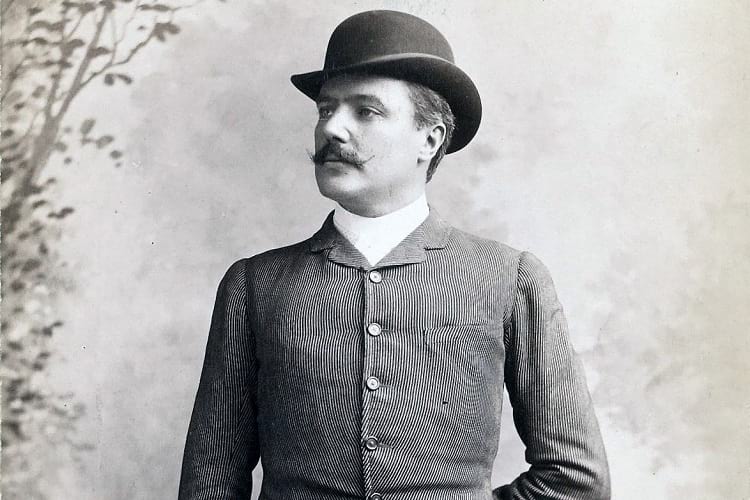
Charles Francis Coghlan. (Harvard Theatre Collection)
Charles Francis Coghlan was a famous Anglo-Irish actor and playwright born to Amie Marie and Francis Coghlan in Paris on June 11, 1842. His father, Francis was a renowned Irishman who founded Coghlan’s Continental Dispatch and published Coghlan’s Continental Guides. Francis had esteemed literary associations, with Charles Dickens as one of his friends. Charles Coghlan grew up being prepped for a legal career but chose to pursue acting, while still a teenager.
The calling of an actor
Charles Francis Coghlan embarked on his acting career at the young age of 17. During the summer tour of Sadler’s Wells Theatre in 1859, Charles was associated with the theatre in small roles as an actor. During the theatre’s stint in Dublin, Charles approached the manager of Haymarket Theatre, John Baldwin Buckstone, with the desire to present a play he had written. Buckstone did not show any interest in the play but did offer Coghlan the role of Monsieur Mafoi in a play adapted by Lord Byron from ‘The Alhambra’ by Washington Irving. The play, ‘The Pilgrim of Love‘ opened at the Haymarket Theatre on April 9 in 1860, and Coghlan went on to act in several supporting roles. His performances slowly built him as an actor of substance.
Coghlan finally secured an important role as Charles Surface in ‘School for Scandal’ by Richard Brinsley Sheridan. The play opened at the St. James’s Theatre in London in the year 1868. Later on, he went on to play the role of Sir Oscar to eminent British stage actress Adelaide Neilson’s Lillian in ‘Life for Life’ by John Westland Marston at the Prince of Wales Theatre. The next couple of seasons at the theatre saw him playing important leading roles to the likes of Geoffrey Delamayn in ‘Man and Wife’ by William Wilkie Collins, and Henry Spreadbrow in ‘Sweethearts‘ by W.S. Gilbert.
The rise and fall of Charles Francis Coghlan
John Augustin Daly was the first recognized stage director of America and in 1876, he brought Charles Francis Coghlan to America as part of his production company. The same year, Coghlan made his debut on Broadway as Alfred Evelyn in the comic play ‘Money’ by Lord Lytton, at the Fifth Avenue Theatre on September 12. Coghlan enjoyed a successful career in America and in England before filing for bankruptcy in London due to liabilities amounting to £312 on January 29, 1891.
Coghlan reached the height of his career when he was able to stage his own adaptation of Alexandre Dumas’ play ‘Kean’ on Broadway. Titled, ‘The Royal Box’, it opened at the Fifth Avenue Theatre on December 21, 1897, and ran successfully till February 1898. Unfortunately, Coghlan died on November 27 in 1899, when he had taken his production ‘The Red Box’ to Galveston, Texas. He had arrived in the city on October 30 that year but had not been able to perform himself due to ill health. Coghlan was suffering from acute gastritis.
The coffin that travelled
After his death, Coghlan’s body was placed in a metal casket to be shipped for burial on his farm in Fortune Bay at Prince Edward Island. The farm was Coghlan’s summer residence. However, some days after his death, there was a press announcement that Coghlan’s cremation would take place in New York. Meanwhile, his mortal remains stayed stored in the vault of the Galveston cemetery until a concrete decision could be reached regarding his funeral rites. What happened next is as bizarre as it can get. Nearly ten months after Coghlan’s death and indecisiveness over his burial, his casket went missing.
On September 8 in 1900, a category 4 hurricane hit the town of Galveston in Texas. The hurricane with a wind speed of more than 135 miles per hour, wreaked havoc on the town, destroying thousands of buildings and taking the lives of many. The disastrous hurricane-displaced and washed out to sea several coffins from the graveyards, one of them being that of Charles Francis Coghlan. Resources were put together to find the missing coffin that was apparently floating around somewhere in the sea. The New York Actors’ Club also announced a reward for the recovery of Coghlan’s coffin, which went unclaimed for years.
Over the following years, several false claims were made of the recovery of Coghlan’s floating coffin. In September 1900, there were reports of Coghlan’s coffin being found near the city of La Marque in Tesax. However, on January 22 in 1904 newspapers reported of a metallic casket like Coghlan’s on a beach near Galveston Yet again, on January 19 in 1907, a newspaper reported that Coghlan’s coffin had been found by a group of hunters in a marsh amongst the weeds a little distance away from Galvenston. On September 15, 1927, Robert Ripley made Coghlan’s floating coffin famous in his column ‘Ripley’s Believe It or Not!. He claimed that Coghlan’s coffin had traversed the sea from Galveston to finally be washed ashore the Prince Edward Island where his home was. Charles Francis Coghlan had come home.
His leading lady of one time, Lilly Langtry recalled in her memoir ‘The Days I Knew’ that the outcome to Coghlan’s mortal remains had been predicted to him by a crystal gazing gypsy woman. Coghlan, believing the gypsy woman, had said on his departure from Prince Edward Island, “I will return come hell and high water“. Notwithstanding the many stories of Coghlan’s floating coffin being found, his sister Rose Coghlan stated in June 1922 that the coffin was still missing. And so, the floating coffin of Charles Francis Coghlan remains an enigma.
Enjoyed this article? Also, check out “Edinburgh’s Miniature Coffins – The Mysterious Lilliputian Coffins, Discovered in Scotland“.
Fact Analysis:
STSTW Media strives to deliver accurate information through careful research. However, things can go wrong. If you find the above article inaccurate or biased, please let us know at [email protected].
RELATED
The post The Curious Case of Charles Coghlan’s Coffin appeared first on .
]]>The post 2006 Mumbai Sweet Seawater Incident: When the Seawater had Miraculously Turned Sweet appeared first on .
]]>
2006 Mumbai Sweet Seawater Incident took place at Mahim Creek. (Nicholas / Wikimedia Commons)
They say curiosity leads man to do certain things that he had never done before. And in a strange case in the financial capital of India, a bizarre incident had led people into doing such extraordinary things that it became a hot topic of discussion for a very long time. Back in the year 2006, the usually salty seawater at Arabian Sea creek had inexplicably turned sweet and people residing by the water body thronged the shores to collect the sweet water, thinking it was some kind of divine intervention.
2006 Mumbai sweet seawater incident
It all started early in the morning of August 19, 2006. The water surrounding Mahimi dargah, situated near the Mahim creek had turned sweet all on its own. When local fishermen began their routine and went out to the sea, they noticed the difference and reported the incident. News then spread like wildfire in the vicinity and by afternoon, Mahim beach was suddenly crowded with people, who wanted to witness the strange incident all by themselves.
One man was seen bathing a child on the Mahim beach, a suburban area in Maharashtra’s capital city of Mumbai. It wasn’t an unusual sight to behold, until people came out in large numbers with utensils, plastic bags and bottles to carry the seawater back home for drinking and cooking purposes. Several others began taking a dip in the Arabian Sea, the western coastline of India, to rid themselves of diseases, thinking the water had, in fact, gained some kind of healing properties. Soon enough, news of the rare occurrence began floating in the entire neighbourhood and authorities had to jump in to intervene.
Reports of a similar incident of seawater turning sweet had also started coming in from Teethal, which is a coastal area in the Valsad District of Gujarat. Unbeknownst to the repercussions of drinking the impure, toxic and polluted water, people from Mahim carried the sweetly-saline seawater home, despite authorities warning them against it. Religious fervour caught up amongst superstitious people and by nightfall, Mahim became a holy site, where believers from nearby areas like Dadar and faraway suburbs turned up to test the rather odd phenomenon. A lot of Hindus, as well as Muslim devotees, claimed that the seawater turning sweet was nothing but the revered Sufi saint Makhdoom Ali Mahimi’s doing and that the seawater was now holy. People in Valsad even worshipped it for possessing extraordinary powers.
What had actually happened?
As soon as news channels reported of the mad rush near Mahim Bay, police officials sprang into action. Geologists at the Indian Institute of Technology – Bombay (IIT-B) called it a natural phenomenon while scientists at the National Institute of Oceanography (NIO) in Versova, said that the phenomenon was not unusual. Researchers said that in the months of monsoon, Mumbai had received heavy rainfall, which had caused rainwater to deposit in underground rocks, which in turn, released the fresh water into the creek. As the density of rainwater is lesser than seawater it floats on the surface of the saline water, mixing with it in the course of time.
Also, due to the continuous rainfall that the city had received, the overflowing Virar Lake emptied its fresh water content into the Mithi River, which mixes in the sea, thus making the water in the Arabian Sea sweeter and less salty in the process. Heavy rainfall and low tide could also have played a role in this phenomenon.
As the authorities from the Municipal Corporation of Greater Mumbai (MCGM), also known as Brihanmumbai Municipal Corporation (BMC), along with the Mumbai police, did their best in keeping everyone away from the strange happening, people did not give up. They drank the seawater, bathed in it, collected it in containers for future use and engaged in all such activities well after midnight. The police kept a strict vigil on the nearby hospitals and medical institutions, hoping to avert any kind of water-related epidemic if the need arose. But no news of an outbreak of water-borne diseases came by till the dawn of next day and no concrete report of what could have caused the water to turn sweet returned.
What did the reports say?
Despite Mahim Bay being an area of excess pollution, the water had changed in taste. A lot of industrial waste as well as raw sewage flow into the water every day, making it unfit for drinking. The Maharashtra Pollution Control board collected samples and sent it for study and also got in touch with the NIO in Goa, which too, confirmed that it was only because of the upsurge of rainwater inside rocks that had caused such an event. BMC health department’s tests conducted on the water samples showed that the salinity was as low as 600 particles per million as compared to the usual 10,000.
Enjoyed this article? Also, check out “Old Man of the Lake: The ‘Stumping’ Story of a Century-Old Log, Bobbing Inexplicably in Oregon’s Crater Lake“.
Fact Analysis:
STSTW Media strives to deliver accurate information through careful research. However, things can go wrong. If you find the above article inaccurate or biased, please let us know at [email protected].
RELATED
The post 2006 Mumbai Sweet Seawater Incident: When the Seawater had Miraculously Turned Sweet appeared first on .
]]>The post The Baffling Oak Island Treasure Trove Mystery appeared first on .
]]>
Aerial photo of an excavation site in Oak Island. (Richard McCully / McCully Nova Scotia Archives)
The story of the Oak Island is replete with elements of mystery, enchantment and even tragedies. However, it’s not the island in its actuality that people are inquisitive about. It increasingly centres on the inexplicable treasure and unexplained objects that are seemingly stockpiled and concealed somewhere inside the island.
Be that as it may, does the conundrum allude as to why no one has figured out how to discover this hidden treasure trove, or whether the fortune even exists by any stretch of an imagination?
Oak Island is an expansive plot of land sprawling over 140 acres is situated along Canada’s Atlantic drift off the shores of Nova Scotia. Treasure hunters intrigued by the enigmatic island are lured to what has been famously dubbed as the “money pit.”
Oak Island Treasure: Anecdote on the hidden fortune
These confident fortune seekers were also beady-eyed about the Nolan’s Cross which is presumably a gigantic cross that pinpoints to the place of the secret treasure that supposedly consisted of artefacts like Marie Antoinette’s jewels and gems, Shakespearean manuscripts and other religious artworks. It’s an enormous and distinct cross formed of huge boulders that brought forth hordes of speculations and theories about its inception and what it reflects.
The razzmatazz over the likelihood of wealth enshrouded in the Oak Island is relatable to the “Golden Age of Piracy” of theft and piracy which happened between 1690 and 1730. Many European settlements did not exist in Nova Scotia at the time.
Pirate Kidd’s treasure trove
This made the Oak Island a favoured destination stop-over for freebooters who arrived from the Boston frontiers because of the island’s plenitude of unexplored landmass and natural resources. Also, in light of the fact that the zone was far away and secluded, it was considered an ideal location to reserve their booties.

Painting of Captain Kidd. (James Thornhill / Wikimedia Commons)
According to early theories, the pit accommodated a pirate treasure that was interred by Captain Kidd, a rover who reportedly hatched a conspiracy with Henry Avery and made Oak Island their community bank.
Early settlers recounted an account of a moribund sailor Gordon Chase from Captain Kidd’s crew who claimed that a fortune worth £2 million was buried in the island. However, his attempts to unravel the riches ended abruptly after he was assaulted and wounded by a different treasure stalker, Micheal J Whynot.
Early accounts of Daniel McGinnis
Most of the accounts exhibit concurrence that the first suspicion about the treasure was conjectured in 1795. According to a widely-known story, a young boy named Daniel McGinnis observed flashing lights from a far-off island in Nova Scotia.
When he visited the island to conduct some exploration at the sight, he discovered an extensive circular depression on the ground. The island was densely forested. However, in the zone around the depression, it was evident that a few oak trees had been felled.
As the legend goes, McGinnis convinced and recruited some friends identified as John Smith and Anthony Vaughn to start excavating the land. After burrowing, McGinnis and his mates ran over massive oak timber platforms at every 10 feet, trenching down no less than 30 feet. They noticed specific and ambiguous “marks” at each of these intervals.
They could surmise that something of paramount significance was buried. Yet they left the spot as there a requirement of a bigger and better-financed campaign to reveal whatever was hidden underneath.
The very next year they returned, yet they could never go deep beyond 108 feet. For, at whatever point they touched that mark, water mysteriously used to inundate the pit.
200 years after that first expedition, innumerable treasure hunters have dared to venture into the Oak Island. From adventurists to businessmen to explorers, irrespective of all the past endeavours that fizzled out and still undeterred, came to the island, being convinced that they would be able to uncover the hidden valuables. Strange peculiarities found en route, just added fuel to the fire to disentangle the mystery and temptation to explore the Oak Island.
Onslow and Truro dig ups

Ongoing excavation during the 19th century. (www.unmuseum.org)
Around eight years after the failed McGinnis dig, Onslow Company cruised to the Oak Island from the central Nova Scotia. They proceeded with the excavation work down to a depth of 90 feet and discovered charcoal layers, coconut fibres and a large stone engraved with symbols. The excavation project was later discontinued without any fruitful end-result, when the pit was flooded with water and safeguarding became inadequate.
In 1849, the Truro Company was formed by investors who started the excavation work again. They could drill to a depth of 98 feet when the pit was flooded again. At the end of their pursuit, they could drill to hit oak layers, a spruce layer and few metal pieces yet, without any substantial outcome.
First casualty
In 1861, the first incident of death and tragedy struck the island when a man was fatally wounded and later succumbed to the injuries after a boiler was detonated and blown up.
Oak Island Association
In the same year, a newly formed company, Oak Island Association, comprising of hopeful treasure trove hunters, attempted new ways to secure the treasure but in vain. Water surged into their digging up and the “money pit” plunged further to a depth of more than 15 feet.
Various other techniques were attempted consistently to discover the Oak Island treasure that included efforts to block the water flow and separate drilling activities in different parts of the island.
Old gold salvage and Roosevelt’s endeavours
Even Franklin Delano Roosevelt needed to partake in the action and monitored the island’s activity closely. In 1909, he enrolled for affiliations to the Oak Island Association and Old Gold Salvage, another fortune chasing group. In spite of the fact that the groups departed from the island that same year, Roosevelt pursued to keep tabs on the Oak Island news during his entire presidency tenure.

Photograph of Franklin D. Roosevelt and his associates at Oak Island in 1909. (National Archives and Records Administration)
Excavation by American Industrialist
Between 1928 and 1939 William Chappell and Gilbert Hedden undertook exhaustive excavation projects none of which were successful. At a depth of 127 feet, William Chappell could unearth a few artefacts that included a fluke anchor, an axe, and a pick. Other than that, there was no trace of any worthwhile treasure.
Discoveries by Erwin Hamilton
Alongside the mishaps and disappointments, revelations were also made that sustained the Oak Island treasure chase and kept it alive. In 1939, amid drilling, gravels and rocks were chanced upon by Erwin Hamilton.
He professed that they were very much unfamiliar to the area which hinted at the possibility of some foreign encroachment. He likewise asserted that he came across a layer of natural limestone deep down at 176 feet, beyond which he found wood.
Death of Robert Restall and his son
On August 17 1965, disaster struck once more. Robert Restall, his accomplice Karle Graeser and his 18-year-old son were excavating the island when Restall was grossly dazed by noxious hydrogen sulfide fumes and succumbed to death.
Restall’s son, who followed him alongside Graeser and two other workers, Andy DeMont and Cyril Hiltz, eventually lost consciousness. None of them, except DeMont, survived the spurious fumes and returned alive at the end of that fateful day.
Indications of the existence of a treasure
Those looking for the treasure have had their reasons to believe that it does exist with the ample indications and findings of the ruffled surfaces of the earth and sand, oddly carved stone plaques and wood and the hypothesis that the inevitable flooding is an intricate booby trap.
Cynics, beside the conspicuous fact, that no treasure had ever existed in the island also claim that the artificial “flood tunnels” which every time obstructed the uncovering of the treasure too have no proven evidence. They likewise state that the Oak Island is bestrewn with natural sinkholes.
Treasure finally uncovered?
Ultimately, the treasure has been unearthed from the cursed Oak Island. It’s a brooch that is believed to be a morsel from the lost whopping treasures of Marie Antoinette, who was the last Queen of France. The brooch contained a 500-year-old multi-faceted and uneven red-coloured rhodolite garnet gemstone.
The breakthrough discovery was carried out by brothers Rick Lagina and Marty Lagina along with metal-detecting expert Gary Drayton, all of who forefront the treasure hunt down in Oak Island. The brooch’s uncovering came minutes after Gary Drayton and Rick Lagina also discovered an ancient military cuff button that could have dated back somewhere between 1780 and 1820.
Apart from the gemstone, other worthwhile discoveries made by the Lagina brothers include a Roman sword and Portuguese carvings which have lineage to the Aztecs. In 2010 the Oak Island Treasure Act was passed prohibiting any further attempts to hunt for the treasure.
Enjoyed this article? Also, check out “The Fascinating Tale of the Lost Treasure of the Beale Ciphers“.
Fact Analysis:
STSTW Media strives to deliver accurate information through careful research. However, things can go wrong. If you find the above article inaccurate or biased, please let us know at [email protected].
RELATED
The post The Baffling Oak Island Treasure Trove Mystery appeared first on .
]]>The post Edinburgh’s Miniature Coffins – The Mysterious Lilliputian Coffins, Discovered in Scotland appeared first on .
]]>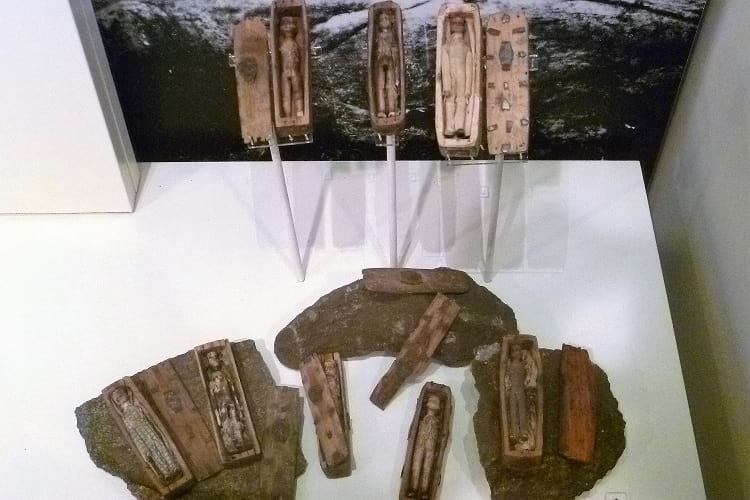
Edinburgh’s Miniature Coffins. (Kim Traynor / Wikimedia Commons)
The past was a mysteriously eerie place in so many ways, especially to look back on now from those fortunate enough to do so from the comfort of their own homes. Every day, items are found pertaining to these shadowy times and while the purpose of most can be explained they provide an intriguing reminder of times gone by and how our ancestors used to live. There are also those discoveries however with no indication of where it came from and why. They confuse even the most educated of archaeologists and historians. And therein lies the mystery.
This is a story from Edinburgh, Scotland, at the time known as Auld Reekie in Scots because of the smoke from coal fire and factory chimneys as well as the stench from a nearby Loch, were bodies among other things were dumped. On Arthur’s Seat –the biggest peak on a formation of hills around the Scottish capital – a set of miniature figures were discovered. Disturbingly, they were all included inside coffins. It is a mystery which has been ongoing for almost two centuries, deeply perplexing those to study it. Their purpose and origin are still completely unknown although as with every good mystery many theories have arose.

Arthur’s Seat in Edinburgh, Scotland. (David Monniaux / Wikimedia Commons)
Discovery of Edinburgh’s Miniature Coffins
In 1836 a group of boys were hunting rabbits on a famous hill to the east of Edinburgh. It is famous for hill-walking, climbing and in those days hunting. Yet the youngsters found a particularly more important prize, even if they did not know so themselves. They were on Arthur’s Seat, an elevated spot suspected to be named after the legendary King Arthur but the more likely etymology is from a strategic point for archers as opposed to Arthur. Inside a small cave-like opening and behind three slabs of slate were seventeen wooden models of figures inside coffins. They are expertly carved, effigies of humans, only four inches long at maximum, all dressed with different fabrics and painted black boots. It is found that the models were deposited at different times as some had already showed signs of ageing and decay. The top coffins were very new at the time of unearthing for example.
Several newspapers reported the story including the Scotsman naming this part of the article A Strange Discovery, published on July 16, 1836.
“…Lilliputian coffins… Evident that the depositions must have been made singly, and at considerable intervals—facts indicated by the rotten and decayed state of the first tier of coffins and their wooden mummies [… while] the coffin last placed, and its shrouded tenant, are as clean and fresh as if only a few days had elapsed since their entombment.”
This is important because it means there was not just one random drop or stash. Someone systematically looked out the spot at various intervals, even spanning years after the initial deposit in 1800, with the last in the 1830’s. These findings were presented by former president of the Royal Scottish Society of Arts – Allen Simpson among others.
What happened to them?
It is told that many were lost by the boys on the day of the finding. They were throwing them at each other in means of play-fighting oblivious to their age, fragility and importance. A jeweller called Robert Frazier fortunately managed to get his hands on the surviving figures, adding them to his private collection. After his retirement in 1845 he auctioned off what became known as the celebrated Lilliputian coffins found on Arthur’s Seat, 1836, and they reached four pounds (about 500 pounds now. In 1901 they passed to their final resting stop of the National Museum of Scotland – eight of which still remain today.
Possible theories
Theories have of course arisen with many of which attributing the figures to witchcraft as well as superstition. This is to do with the prevalent history of witches in those times and especially within Scotland. In terms of witches, Arthur’s Seat has historically been a site of witchcraft and other illicit practices. One such name for the ancient volcano is the Windy Gowl where more witches were burned and hanged there in the 16th Century than anywhere in Scotland. In terms of superstition, it is thought even that sailors created them as a charm to keep safe at sea. (Edinburgh sits on the banks of the North Sea) Another theory came from the Evening Post. They noted that an ancient customer from Saxony, Germany explained that it is an ancient tradition to bury a miniature coffin as a remembrance to a friend or family member who had died in a distant land.
Others surmise that the figures are to do with a duo of serial killers who murdered in Edinburgh – William Burke and William Hare. The main reason is that they killed seventeen victims, and only ten years before the cache was located. A popular trade in the 19th Century was that of cadavers. This was for medical students who usually only had a limited supply of recently executed convicts. Hare rented a boarding house and came up with the idea when one of his guests died whilst still owing some money. They used his body as collateral, turning to a life of crime and selling the corpse to a doctor called Robert Knox. After amassing a small fortune they were discovered and convicted. Hare actually testified against Burke who was hanged dissected and his skin made into a book cover. It is said that Burke would have had the intricate ability as he was a shoemaker.
This was later strengthened as a solution when in 2014 an anonymous box was delivered to the National History Museum. It was a replica of the models with a note stating ‘XVIII?’ which had quotes from a Robert Louis Stevenson story called The Body Snatchers (1884), a shot piece based on the Burke and Hare murders. It was addressed as a ‘gift’ to the museum ‘for caring for our nation’s treasures.’ However, this has also been doubted as a theory because the figures are all dressed in men’s clothes whereas the victims were mostly woman. Also, the eyes are open on the models.
The figures are not known the world over but they have become a small, mysterious symbol of Scotland’s capital which very much suits the style of the models. Famous crime writer Ian Rankin even wrote about them, giving them a mention in his Inspector Rebus novel The Falls. While we do not know their true origin perhaps as technology improves more will be revealed.
Enjoyed this article? Also, check out “Tana Toraja in Indonesia: The Celebratory Funeral Ceremonies and the Tree of Baby Graves“.
Fact Analysis:
STSTW Media strives to deliver accurate information through careful research. However, things can go wrong. If you find the above article inaccurate or biased, please let us know at [email protected].
RELATED
The post Edinburgh’s Miniature Coffins – The Mysterious Lilliputian Coffins, Discovered in Scotland appeared first on .
]]>The post The Ghost Blimp L-8 and the Unexplained Disappearance of the Two US Navy Pilots appeared first on .
]]>
Ghost Blimp: U.S. Navy L-8. (National Archives)
Many strange events occurred during the Second World War and many of them remain unexplained till date. This is the case with the US Navy Blimp L-8, whose two-man crew disappeared without a trace in 1942. Despite a widespread search and a thorough investigation, the US naval authorities could not come up with any plausible and adequate explanation of why, when, and how the crew had abandoned the blimp and what had happened to them.
The mystery of the Ghost Blimp L-8
On 16 August 1942, at 6:03 a.m., US Navy Blimp L-8 took off from Moffett Field on Treasure Island in the San Francisco Bay on a routine mission. It was a clear day, with a calm sea, and you wouldn’t have known there was anything amiss with the world.
The Second World War was raging in Europe, Asia, and Africa, and the United States. After the Japanese attack on Pearl Harbour, United States was paranoid about being on the receiving end of Japanese attacks on the West Coast mainland. The L-8 was instructed to patrol the coast and look for Japanese submarines that might be lurking in the Pacific Ocean. The two-man crew was equipped with a .30 calibre machine gun and 300 rounds and two Mark 17 depth charges. If they spotted the enemy’s submarines, they were to make every effort to destroy them.
The L-8 flight was to last for four hours, after which the pilots were to return to Treasure Island to refuel and then go back on another patrol. At 7:38 a.m., the crew radioed their base to report that they had spotted an oil slick in the water four miles to the east of the Farallon Islands. They said they were going to investigate the area for possible submarine presence. That was the last radio contact the men made, but a Liberty ship, Albert Gallatin, and a fishing trawler, Daisy Grey, saw them after this time. The blimp had dropped two smoke-producing Mark IV float-lights or flares at 7:42 a.m. to aid them in better scrutinizing the area. The personnel on the ship and the trawler later informed the naval authorities that the blimp had patrolled the area for about an hour and they had seen the L-8 descend to 30 feet above the water surface at one point. The fishing trawler hurriedly pulled up its fishing nets, fearing that they would be ruined if the blimp unleashed one of its depth charges against a lurking Japanese submarine. Nothing alarming happened, however. No Japanese submarine appeared and, after the flares, the L-8 did not drop anything else into the ocean. The blimp and its crew looked perfectly alright to the watchers on the Albert Gallatin and the Daisy Grey. There was no indication of any kind of trouble.
Sometime after 9 a.m., the L-8 dumped ballast, rose back up in the air, and began its return journey to Treasure Island. Many eyewitnesses saw it on this return journey. None of them thought there was anything wrong with the blimp, although a few did notice it sagging in the middle.
There was no further radio contact, however, and the attempts of the naval base to establish contact came to nothing. They were not much alarmed since it was common for radio connections to fail on occasion. In addition, the pilots were experienced and had enough fuel to return to base. Even so, at 8:50 a.m., when they still hadn’t heard from the L-8, they sent two Vought OS2U Kingfisher floatplanes to conduct a search and informed other planes in the area to report to them if they saw the blimp.
A few reports soon trickled in. The pilot of a Pan Am Clipper called at 10:49 a.m. to say he had seen the L-8 over the Golden Gate Bridge. Then, at 11 a.m., one of the Kingfisher floatplanes reported they had seen the blimp ascend to 2000 feet three miles to the west from Salada Beach. Later, the pilot of an Army P-38 saw the blimp near Mile Rock. In all these sightings, the L-8 appeared to be in fine fettle.
The next person to see the blimp was Richard Quam, a Navy seaman who was off-duty and was driving along the coastal highway to spend the day on the beach. He thought something didn’t seem quite right with the blimp. There was a noticeable bend in its middle. He took a photograph out of sheer curiosity. The naval authorities later confiscated his camera film.

Ghost Blimp L-8 sagging in the middle. (National Archives)
When the blimp came inland, it was eight miles off course to the south of San Francisco. After nearly touching down on the Ocean Beach near Fort Funston, it continued onward and crashed into a nearby cliff. There was only one bather on the beach at the time and he reported later that the impact against the cliff dislodged a 325-pound depth charge that rolled out of sight down the hill. The impact also bent the starboard engine’s propellers. Considerably lightened by the unloading of the depth charge and although with a V-shaped sag in its middle, the blimp rose up into the air and continued onward.
The blimp passed over the Olympic Club golf course, astonishing a crowd of golfers. One of the golfers looked at the blimp through binoculars and told the naval authorities later that he had seen two men in the gondola. After passing over Lake Merced, the L-8 went over the Daly City BART station and Mission Street. By now, hundreds of people had spotted the blimp and, as it was now visibly deflating and appeared to be in trouble, they had begun running after it.
Soon the L-8 began losing height and, after scraping over rooftops and nearly getting entangled in telephone lines, it crashed into a house in Daly City and then landed in the middle of a street. The now deflated gas bag of the blimp draped over a car – the owner had been cleaning it just minutes before the blimp’s descent and had fled for his life when he saw it coming down on him – and the upturned gondola touched down gently and drew up against a telephone pole. When the onlookers rushed to it, they discovered there was no one on board. The door had swung open, with no sign of the safety bar, and two of the three life jackets were missing; since it was mandatory for the crewmen to wear life jackets at all times while on board, the life jackets had obviously disappeared along with the men that were wearing them. One of the crewmen’s hats was still there though, dangling on the controls, and a briefcase that contained secret codes was still locked in place. Also, on board were the rubber life raft and the three parachutes – putting into doubt the claim of one eyewitness that he had seen a parachute drop out of the blimp earlier; nobody was found in the reported area, despite a thorough search.
L-8 – The Ghost Blimp
The L-8 was manufactured by the Goodyear Tire & Rubber Company for promotional purposes. It was 150-foot-long and had a 47-foot diameter. It could hold around 123,000 cubic feet of helium and could attain a speed of 43 knots. It was powered by twin 145 horsepower Warner Super Scarab Type 5 engines.
When the United States entered the Second World War, the Goodyear company bowed to the US Navy’s requisition order and presented the L-8 and four other blimps to the US Navy to help with the war effort. The navy refurbished the L-8 and made it a part of the lighter-than-air Airship Patrol Squadron 32. They used the L-8 for sending supplies to offshore ships and to patrol the coast. The blimp and its gondola were in excellent condition. The blimp had made 1,092 trips without encountering any problem, and, moreover, it had undergone a thorough inspection prior to the flight.

L-8 blimp being used to deliver supplies to the USS Hornet. (U.S. Navy)
On that fateful day, the L-8 had been ordered to fly to the Farallon Islands, turn northward to Point Reyes, turn southward to Montara, and then turn back over the Golden Gate Bridge to Treasure Island.
The L-8 crew
The two-man crew were Lieutenant Ernest DeWitt Cody, 27, and Ensign Charles E. Adams, 35. They were both married, were experienced pilots, and had impeccable career records. They were both described as level-headed and competent.
Lieutenant Cody had graduated from Annapolis in 1938 and was not as experienced as Adams in piloting lighter-than-air flights. He had logged only 756 hours of such flights. Adams, on the other hand, had 20 years of experience in manning lighter-than-air flights and had logged 2,281 hours.
However, what he lacked in experience, Lieutenant Cody made up in determination and skill. Earlier in the year, in April 1942, he had delivered a 300-pound cargo of plane spare parts for the B-25 bombers to the USS Hornet; the vessel was carrying the bombers to Japan to carry out bombing raids over Tokyo. To deliver the cargo successfully, Lieutenant Cody had to hover over the ship, keeping the blimp steady, quite a piloting feat. He received a promotion for this successful cargo delivery.
Search for the missing L-8 crew
A widescale search was launched on air, land, and sea to find the missing crewmen, but they were never found. The naval authorities, under Commander Francis Connell, investigated the incident, and, in their seven-day-long inquiry, questioned civilians as well as naval personnel about what they had seen of the blimp on the day that its crew disappeared. Despite all the eyewitness testimonies, they could not come up with a reasonable explanation about what had happened. There was no sign that the blimp had been shot down or caught fire anywhere. Nor were there any sign that it had touched down at sea since its underside was completely dry and was dusty as well. There were also no signs of a fight or any other misconduct by the crew or a stowaway within the gondola.
A year later, with now new findings coming to light, the Navy closed the investigation, marking it as a 100% unknown and undetermined case, and then they legally declared the two missing men to be dead.
Theories about what happened to the L-8 crew
No one knows conclusively what happened to the two crewmen. Their bodies were never found, and nobody heard anything about them. How could they have disappeared without a trace in a busy city like San Francisco, and, moreover, right under official and public scrutiny? If anything had gone wrong, why hadn’t they radioed to inform the base? The radio, after all, was in perfect working order. There was no way they could have lost radio contact. Which meant they had either chosen not to make radio contact or they hadn’t been in the position to use the radio.
Over the years, people tried to come up with various explanations for their mysterious disappearance. According to one theory, it is likely that they climbed out of the gondola to carry out some repair work and fell to their deaths. Another theory is that perhaps the gondola door wasn’t barred as it should have been, and it swung open in mid-flight and they fell out. Perhaps the two men had a disagreement over flying the L-8 or over a woman they both like, and things grew violent and out of control and, in shoving one another, they ended up falling together out of the gondola.
Naval authorities dismiss these theories as nonsense. Cody and Adams were professional navy men and knew how to conduct themselves on a mission. Also, according to the code of operational technique, the airship crew was not supposed to bail out from the blimp when everything was working perfectly. Also, if they had fallen and died, the search teams ought to have found their bodies. Certainly, they couldn’t have fallen into the ocean, since many eyewitnesses reported seeing two men in the gondola as the blimp moved over San Francisco.
So, what could have happened to the airmen? Maybe they decided they wanted no part of the killing theatre that was the Second World War and went AWOL. Perhaps they were spying for Japan and escaped on a Japanese submarine. That again goes against the eyewitness testimonies.
Or, maybe, the Japanese submarine they were looking for, found them instead and forced them to jump at gunpoint. The Japanese then put their own men in the gondola and these were the men that onlookers saw from the ground below as the blimp coasted over San Francisco. What happened to the Japanese usurpers then? Perhaps they bailed out before the L-8 crashed and then they melted away into the city crowds to begin a spying operation against the United States. Well, that sounds exciting but not as exciting as the claim that it may have been Extra-Terrestrial Aliens that abducted the two men. Or that a shark jumped out of the water when they descended to look at the oil slick and grabbed them both.
Another theory put forward by researcher Otto Gross, is that, rather than looking for submarines, the L-8 was, in fact, conducting radar tests. Cody and Adams were knocked unconscious by the microwave radiation and, as the gondola door was improperly fastened, they probably fell out of the gondola. The US navy and army were conducting several top-secret research programs at this time, so there may be something to this theory. Given the secretive nature of the program, the bodies of the two men may have been retrieved and disposed off without informing the public.
What happened to the Ghost Blimp L-8 afterwards
The L-8, after being repaired, was returned to active service shortly after the disappearance of the crewmen. After the war ended, the Navy returned it to Goodyear, who refurbished it and began using it for promotional purposes once again. They renamed it America and it was in operation until 1982. The gondola of the L-8 is now on display in the Naval Aviation Museum in Pensacola in the Florida Panhandle.
Enjoyed this article? Also, check out “Hindenburg: The Tragic Death of World’s Biggest Commercial Airships“.
Recommended Visit:
Naval Aviation Museum | Pensacola, USA
Fact Analysis:
STSTW Media strives to deliver accurate information through careful research. However, things can go wrong. If you find the above article inaccurate or biased, please let us know at [email protected].
RELATED
The post The Ghost Blimp L-8 and the Unexplained Disappearance of the Two US Navy Pilots appeared first on .
]]>The post The Egyptian Vultures of Tamil Nadu’s Vedagiriswarar Temple appeared first on .
]]>
A priest feasting the sacred Egyptian Vultures. (Edgar Thurston / Madras Government, India)
Some of India’s temples are famous not only for their architectural finesse, their beautiful surroundings, and the piety they invoke in believers but also for certain quite inexplicable happenings that continue to baffle onlookers. The Vedagiriswarar Temple is a fine example of this. For several centuries, the temple was famous for hosting a remarkable pair of birds that appeared exactly at noon to accept prasad from the temple’s priest.
The birds of Vedagiriswarar Temple
Nobody knows exactly when the birds started arriving at the upper temple, but they came regularly for many centuries. They alighted on a rock near the temple at noon on the dot and then the priest would feed them a prasad of ghee, sugar, rice, and wheat. If on occasion, the Egyptian Vultures did not show up, it was on account of the presence of sinners amongst the crowd (or) onlookers.
The Temple authorities and the devotees do not consider the Eagle Vultures to be ordinary birds, but there are differing folklores about what they actually are.
According to one version, the Eagle Vultures are the eight sages or Asthavasus who once displeased Lord Shiva and the quick-tempered God then cursed them to live as birds until they had performed penance. Lord Shiva ordered them to visit his temple in Vedagiriswarar to pray to him and receive prasad from the temple priests. The birds lived for three yugas or epochs, with six of the sages getting mukti (emancipation) and the last two surviving to the present epoch.
By another version, the Eagle Vultures are Sage Poosha and Sage Vruddha. They once prayed long and hard to Lord Shiva in order to obtain the elevated Sharoopa status. Lord Shiva, however, was willing to grant them only the Sayujya status at that time and said that he would consider granting them the Sharoopa status later perhaps when he thought they were worthier of it. Instead of accepting what Lord Shiva offered them, the two Sages argued with him and insisted on being given the Sharoopa status right then and there.
Angered by their insistence, Lord Shiva cursed them and turned them into Eagle Vultures and informed them that they would remain birds until the end of the Kali Yuga. In the meantime, they were to worship him at the Vedagiriswarar Temple. For generations, the birds followed his diktat and appeared at the temple. In the Thretha Yuga, they went by the names Sandan and Prasandan. In the Kritha Yuga, they called themselves Sambathi and Jadayu. In the Dhawapara Yuga, they called themselves as Sambhukthan and Mukundan. Now, in the Kali Yuga, they are Pusha and Vidhadha.
The local lore tells us that the birds daily fly across a distance of some 3218 km from Varanasi to Thirukazhukundram to feed at Vedagiriswarar Temple at noon and then first fly southward to Rameswaram and then northward to Chidambaram to spend the night there for some much-needed rest. The next morning, they fly to bathe in the Ganges in Varanasi and the return again by noon to Vedagiriswarar Temple.
Perplexing bird behaviour
Egyptian Vultures are birds that normally congregate in flocks and feed on carcasses. For only a pair to appear on a regular basis at Vedagiriswarar Temple and that too to feed on food that is not the natural food of Vultures is odd behaviour, if you consider the matter from a scientific point of view. Some bird researchers think that if the birds have been coming to the temple for centuries it is on account of learned behaviour that the parent birds have passed down to their progeny or from bird relatives to other birds.
The Egyptian vultures stop visiting Vedagiriswarar Temple
Since 1998, the Egyptians Vultures have stopped showing up at Vedagiriswarar Temple. It may be because there are too many sinners flocking in the area. Or it may be that the last pair of Ashthavasus has finally attained moksha. Or, more prosaically, the last pair of Egyptian Vultures failed to either raise a new generation or failed to point them in the direction of the temple or failed to cultivate in them a taste for the temple prasad.
No one knows what the reason is exactly, but the priests at Vedagiriswarar Temple continue to scan the skies and keep vigil in the expectation that the birds may one day return as they did in past centuries.
Vedagiriswarar temple
Dedicated to Lord Shiva and located in the town of Tirukalukundram, also called Thirukazhukundram, in Tamil Nadu, the Kings of the Pallava Dynasty built the temple and it displays some of the best elements of ancient Dravidian architecture.

Vedagiriswarar temple. (Simply CVR / Flickr)
Vedagiriswarar Temple is actually a temple complex that has two temples. One of the temples is at the foot of the hill and the other one is at the top of the hill. You must climb over 500 steps to reach the upper temple.
Lord Shiva resides in the upper temple and his consort, Parvati, resides in the lower temple. Vedagiriswarar is one of Lord Shiva’s many names and Parvati, in this instance, goes by the name of Thiripurasundari Amman.
Her temple, the Bakthavatchalaeswarar Temple, covers a large area of around 10 acres and has exquisite architectural features that include four gopurams, curved mandapams, and a high compound wall. The architectural style is similar to that of the Annamalaiyar Temple. There is also a huge water tank called Sangu Theertham that looks almost like a lake. The water contains minerals that confer it with health-giving properties and the priests use it to perform the abhishek rites on the temple deities. Devotees can drink this water.
Another remarkable thing about the Sangu Theertham is that every 12 years a Sangu or Couch Shell emerges from the depths and floats on the water surface. The priests have collected these Couch Shells and made them available for public viewing.
According to Hindu Mythology, Vedagiriswarar Temple sits on top of the tallest of the four Vedic hills – hence the name Vedagiri or mountain of the Veda – that Lord Shiva created to fulfil Sage Bharadhwaja’s wish to master the four Vedas. The Sage wanted to live for a very long time, so he would be able to learn everything in the Vedas.
Shiva granted him his wish but informed him that learning was a never-ending process and no matter how long one lived one could never know everything there was to know in the Vedas. Spending years learning the verses in the Vedas, therefore, wasn’t the proper way to attain to salvation. For true salvation, one needed genuine devotion or Bhakti.
In addition to being called Vedagiriswarar, devotees also call the temple Kazhugo Koil, which means an Eagle Temple, and they call the surrounding town Pakshi Theertham or a Pilgrimage Place of Birds. Interesting, the official name of the town, Thirukazhukundram, also pertains to birds in the Tamil language. Thiru means respectful, Kazhu means an Eagle or a Vulture, and Kundram means mount. So Thirukazhukundram means Respectful Mount of the Eagle or Vulture.
Thirukazhukundram is a very famous pilgrimage destination for Hindus and is about 15 km away from Mahabalipuram and 15 km away from Chengalpattu.
Enjoyed this article? Also, check out “Dhanushkodi: Where a Cyclone Ripped Apart an Entire South Indian Town, Rendering it Uninhabited“.
Fact Analysis:
STSTW Media strives to deliver accurate information through careful research. However, things can go wrong. If you find the above article inaccurate or biased, please let us know at [email protected].
RELATED
The post The Egyptian Vultures of Tamil Nadu’s Vedagiriswarar Temple appeared first on .
]]>The post Bohemian Grove: A Club for the Rich and Powerful or an All-Male Secret Society? appeared first on .
]]>
Harvey Hancock (standing) speaking in the presence of California Governor Ronald W. Reagan, Former US Vice President Richard M. Nixon and other unidentified men at the Bohemian Avenue. Circa 1967. (Lawrence Berkeley National Laboratories Image Library)
Quietly nestled in one of the highly restricted areas on Bohemian Avenue in California, USA, this gentlemen’s club is one of the most secretive places in the world, which comes to life in mid-July every year. Known as the Bohemian Grove, this all-male club has very limited access to outsiders and nobody knows what goes on inside this vast property. The huge main gates are shut tight for two weeks with guests inside, isolated from the outside world. Rumours of human sacrifices and the place being haunted are some of the stories that make the club more mysterious than any such club in the world.
Bohemian Grove
The 2700-acre property hosts members like heads of the state including a few former US Presidents, business leaders, military officials, political figures, and artists from various fields, media barons and people in power since the time of its establishment. The bohemian-styled club came into form as a summer getaway of sorts for men in 1872 in San Francisco, but after British artist Henry Edwards announced his relocation to New York City in 1878, members of the camp gathered at the present-day Bohemian Grove for his send-off party and made merry all night long, which became an annual practice ever since.
Located amidst a lush forest and surrounded with over 1000-year-old tall redwood trees, Bohemian Grove boasts of an artificial lake inside the property, where high-ranking officials deliver lectures on immediate public issues every once in a while. The club’s motto comes straight out of William Shakespeare’s ‘A Midsummer Night’s Dream’ – “Weaving spiders, come not here!”, which explains that all worldly occupation and business deals need to be kept outside the club and dealt with later, while men bond over topics of art and leisure inside.

The artificial lake inside the property. (Aarkwilde / Wikimedia Commons)
Guests and visitors
Bohemian Grove sometimes allows guests, which could be a premium member’s family or friends that are allowed to stay inside only until dark, after which they are sent back. The membership of the elite club is also not easy to come by. One might need to wait for as long as 30 years to get one and an initiation amount of 25,000 USD, only after which he can become a part of the somewhat-secret society. Many known names such as Richard Nixon, Ronald Reagan, Calvin Coolidge, Will Irwin, Henry Kissinger, Gerald Ford, Herbert Hoover, Theodore Roosevelt, George H W Bush and Nelson Rockefeller have once been a part of the private club.
Divided into as many as 127 smaller camps, Bohemian Grove has its own kitchen, which serves scrumptious lamb, steaks and salmon delicacies each night, bars that offer some of the best wines, spacious dining areas, bathrooms, luxurious sleeping facilities and spaces reserved for relaxing right in the middle of the private property. Activities like golfing, canoeing, swimming, music and arts are reserved for bohemians, who catch up with each other in the strictly guarded campsite.
Until now it all seems like the club is like any other across the world, only that its members are some of the richest and most powerful people in the world. But what sets it apart are the ‘other activities’ that are carried out inside the grove. Phillip Weiss, a journalist working for Spy Magazine founded by Vanity Fair editor Graydon Carter, was once sent to gain access into the secret club to get to know more about its activities in 1989 when he came back with reports of some bizarre practices.
What happens inside Bohemian Grove?
Weiss reported that a peculiar opening ceremony at the man-made lake was carried out under the club’s mascot – an owl – symbolising worldly wisdom, which is a 40-foot moss-covered structure made of stone and steel. Known as Cremation of Care, the ceremony started off with burning an effigy of a wooden skeleton inside a coffin, which eased and relaxed the members as outwardly stress and care burnt right in front of them and also as a mark of respecting the forest. High priests dressed in bright red robes then sang songs with undertones of homosexuality. Another Texas-based filmmaker Alex Jones, who had found his way inside, vouched for the same and even claimed to have filmed the entire bizarre ceremony.
But that’s not all. If rumours are to be believed, Bohemian Grove is said to be a place where once a child was murdered in 1984. Several people who have only heard the stories claim the place is haunted by the child’s ghost. While there were no official reports of womenfolk entering the private club, many claimed that sex workers were secretly sent inside for entertaining their influential guests. After there were complaints of discrimination, the once all-male Bohemian Grove was ordered to begin hiring women and employ them accordingly.
As per reports in newspapers, in the September of 1942, Earnest Lawrence, the S-1 Committee and Robert Oppenheimer, which later became the Manhattan Project, met at Bohemian Grove that later changed the future of the world. In the wake of the bombing of Pearl Harbor in 1941, the S-1 Committee is said to have discussed and strategize the building of a nuclear bomb right inside the premises of the privately-owned grove a year later.
After a number of intruders tried to sneak inside Bohemian Grove over all the years, the security became tighter than ever before and reports of activities carried out inside the elite club have only been few and far between. Whatever shady businesses or proceedings go on inside the privileged club, it is but obvious that nothing worthwhile regarding one of the most secretive clubs in the world will ever come out from behind the closed gates.
Enjoyed this article? Also, check out “The Disappearance of Michael Rockefeller: One of the Most Enduring Unsolved Modern Mysteries“.
Fact Analysis:
STSTW Media strives to deliver accurate information through careful research. However, things can go wrong. If you find the above article inaccurate or bias, please let us know at [email protected]
RELATED
The post Bohemian Grove: A Club for the Rich and Powerful or an All-Male Secret Society? appeared first on .
]]>The post The Fascinating Tale of the Lost Treasure of the Beale Ciphers appeared first on .
]]>
Beale Papers. (Wikimedia Commons)
If the Beale Ciphers are to be believed, it is prime time to rewrite American history. The Beale Papers narrate a captivating story that has become an integral part of the Virginia legend. A thrilling tale of adventure, lost treasure trove, early bonanza and secret codes that significantly remain obfuscated till current times.
Discovery of the vast treasure trove
In the year 1817, Thomas Jefferson Beale, who was a Virginian native, along with the comradeship of thirty other adventurous companions set out for hunting buffaloes and grizzlies in the western part of America.
Quite by an accident, in the following year, Beale’s party unearthed a fabulous and massive treasure of silver, gold and jewels about 300 miles north of Santa Fe. This discovery happened thirty years prior to the great gold strike in California. The buried treasure is estimated to be worth more than US $54 million as of currency value in January 2018.
Beale and his compatriots decided to work together and distribute the treasure equally. With the thought of protecting the huge reserve of wealth and ensuring their own safety, they chalked out a comprehensive plan to hide the treasure.
The concealment strategy comprised of three ciphertexts. The first ciphertext described the location of the treasure. The second one contained information about the constituents of the treasure. The third ciphertext tabulated the treasure owners’ names and details about their next of kin.
The fortune was then transported by wagons in two episodes to Virginia. It was then concealed and fortified in a rock-made vault dug up in the ground.
Sequence of events
The decision to hand over the documents to a confidante
Beale’s comrades were worried that if they would meet with an accident and die, the secret treasure would never find its way to their loved ones.
Therefore, they urged Beale to solicit the service of a reliable person who could be entrusted to fulfil their wishes in the eventuality of their unforeseen death. And for Beale, Morris was the only chosen one.
Handing over the box to Robert Morris
Beale secured the ciphertexts of three encoded letters and a few other confidential papers inside an iron box. In the spring of 1822, he handed over the box to a certain Mr. Robert Morris, who was a Lynchburg innkeeper.
Beale vouchsafed the locked box and categorically informed to Morris that the box contained documents of immense value and significance.
Morris safeguarded the box dutifully and waited for Beale to return and collect it. But the saturnine mysterious man did not come back to Lynchburg. He vanished leaving no trace and never returned again.
Promise to send the key to crack the cryptograms
Beale had instructed Morris not to unbolt the box. He informed that he or one of the group members would return from the voyage within 10 years. A few months later Beale wrote a letter to Morris from St. Louis.
Beale apprised and promised Morris that his friend would dispatch the key to disentangle the cryptograms. But the friend never made any appearance.
Opening of the box in 1845
When Beale did not return even after 23 years, Morris’s inquisitiveness overshot to the roof. He assumed that Beale by then might have been dead. His unrelenting curiosity got the better of him and he broke open the locked iron box.
He was astounded and exhilarated by the box’s content. There was an inscription in plain English written by Beale and three sheets replete with numbers. The note elaborately described Beale’s several adventures and escapades and the discovery of the mammoth quantity of the valuables.
Morris’s attempt to decode the ciphers
Morris began to decrypt the three ciphers right away. Unfortunately, even after decades of painstaking attempts, Morris had no luck in solving the mystery.
In 1862, when Morris realized that his days were numbered, he discerned the urgency to pass on the conundrum of the Beale ciphers.
At the age of 84, Morris died, but not before giving the box and its top-secret contents to an unidentified friend. The friend also put in decades working on the deciphering of the messages.
Progress in the deciphering of the messages
Utilizing a version of the United States Declaration of Independence as a potent means, Morris’s anonymous trusted young friend could manage to decrypt successfully the second of the three ciphertexts components.
It provided a depiction of the huge reserve of the buried wealth. However, he was unable to comprehend the interpretation of the remaining two texts, including the most important one that incorporated the cipher offering information about the location of the treasure.
The friend eventually made the story about the Beale ciphers public in a pamphlet named “The Beale Papers” that was published by another friend, James B. Ward, in the year 1885. It has created an enormous level of controversy ever since. And the press has been agog in reporting innumerable claims of the codes being deciphered and made intelligible, often with some head-twisting outcomes.
Information about Morris’s friend
Only a couple of simple and straightforward information could be gathered about Morris’s friend. Firstly, he published The Beale Papers pamphlet, where he chronicled the entire account of Beale including the Beale ciphers. It also enclosed the narrative of Morris’s efforts and events to find an answer to the undisclosed mystery. Secondly, the unnamed pamphleteer made the first headway in decoding one of Beale’s encrypted papers.
Unknown identity of the author of The Beale Papers
Who actually wrote The Beale Papers still continues to be a topic of hot debate and dispute. The introductory piece of the pamphlet offers a prelude of Ward sharing anecdotes about how the author became an indispensable part of the baffling Beale Papers. It also included the reasons as to why he resolved to divulge all the details of whatever he could comprehend through the pamphlet.
It is speculated how the author took over the mantle of unearthing the veiled ciphertexts from Morris and writing plain and explicit accounts in the form of The Beale Papers. From that time onwards, he frequently engaged in solving the puzzle of the Beale ciphers that eventually led to his financial and emotional demise.
Vague identity of James B. Ward and the Masonic aspect
Although very little is known, James. B Ward was believed to be a Freemason – a member of an international order developed to foster mutual help and comradeship and which holds intricate unofficial ceremonies.
The Beale Papers are surmised to have used a few Masonic descriptions or figurative languages and terms. Conjectures specify that the text required to decode and use the 1st and the 3rd Beale Papers could be a quintessential Masonic Text.
This is assumed to be one of the reasons why the text could not be discovered, as Masonic Texts are confidentially held. Therefore, it is often suggested that the successful decryption of the Beale Papers might not result in finding a physical treasure but one that is truly spiritual, somewhat similar to exploring the Lost Word in Masonic Lodges.
Are the Beale ciphers real or just a hoax?
The absence of any progress or a hint of success could imply that the Beale papers are an elaborate and convoluted scam. Cynics have hunt down flaws and inconsistencies in the Beale story.
For instance, the letter of Beale that was ensconced inside the box along with the ciphers was assumed to be written in 1822. Surprisingly the letter contained the word “stampede” that was unavailable in print until 1844.
In any case, it is quite conceivable that the word could have been commonly used in western America from a much earlier time which Beale might have come across during his expeditions.
There also have been shreds of evidence in favour of the veracity of the ciphers. These originate from the historical records which can be utilized to corroborate the tale of Thomas Beale.
A local historian named Peter Viemeister, extensively looked for sufficient documentation to evince that Thomas Beale existed. He used the census of 1790 and other anecdotes to identify numerous Thomas Beales born in that era in Virginia. Some of their backgrounds are in sync with a few familiar facts gathered so far.
The points of interest we have about Beale is his talks about his journey to Santa Fe. And there is sound proof to substantiate his uncovering of the gold booty.
For instance, Jacob Fowler, who was an explorer between 1821 and 1822 mentions in his chronicles, about the existence of the Pawnee and Crowe tribes who were believed to be in friendly terms with around 35 number of White men, a group size that was similar to Beale’s gang.
Also, a Cheyenne legend that dates back to the 1820s recounts the incident of gold and silver being transported from the western part and interred somewhere in the eastern mountains.
Also to an extent, the Masonic perspective hints at the purpose and meaning of the treasure as not being one like a physical monetary stash of gold, but the precious esteem that lies within, or a clandestine and esoteric understanding of wisdom that would be unfolded through the solution of the last two codes.
Treasure hunters. Codebreakers. Cryptanalysts.
Countless people who have ardently believed that there is a considerable fragment of truth and authenticity in the Beale Treasure story address the issue primarily in two major ways.
They either embark on a physical exploration of the fortune subsequent to probing and analyzing with however much as could reasonably be expected from what is provided. Or, they spend their endeavours in attempting to unknot the codes. Throughout the years many people have physically hunted down for the treasure but met with no success.
Until the point when more confirmation and evidence can be found to either prove or disprove the incredibly legendary Beale Treasure, the search for these lost valuables will proceed on. The allure, fame and popularity garnered by the person who accomplishes this hugely complicated task and acquires the wealth alongside are sufficient to keep people inquiring about. It is a paradox that beckons the daring and the intrepid to accept the challenge.
Research Material: NSA Declassified Documents
Enjoyed this article? Also, check out “The Baffling Oak Island Treasure Trove Mystery“.
Fact Analysis:
STSTW Media strives to deliver accurate information through careful research. However, things can go wrong. If you find the above article inaccurate or biased, please let us know at [email protected].
RELATED
The post The Fascinating Tale of the Lost Treasure of the Beale Ciphers appeared first on .
]]>The post Area 51: Is America Really Building UFO’s? appeared first on .
]]>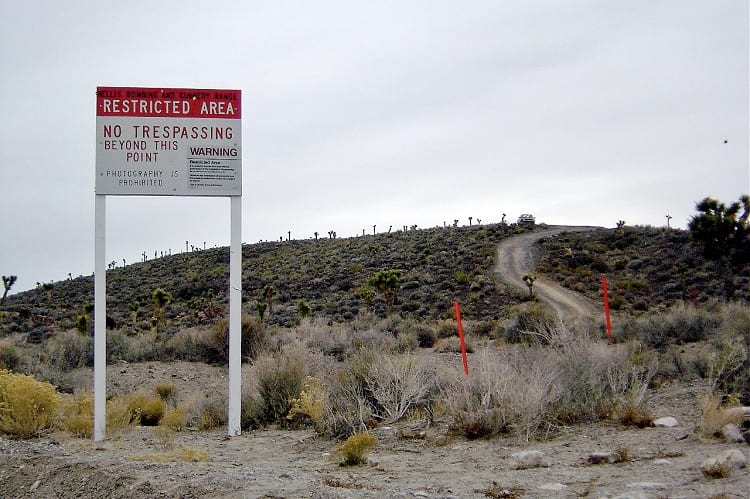
A warning sign near Area 51. (X51 / Flickr)
About 80 miles from Las Vegas, on the outskirts of Nevada is a top-secret United States Air Force military base, dubbed as Area 51 that has been active since the Second World War. During the war, the ground was used for training and testing machine guns. A decade after the war saw President Eisenhower approving a secret area of land meant to develop and test stealth aeroplanes as part of a defence system in light of the events at Pearl Harbor.
The territory has been managed by the Edwards Air Force base in California. At the centre of the base sits a large military airfield. This airfield had to later be expanded as technologically advanced aeroplanes were being built. It wasn’t until 2013 that the United States government officially acknowledged the area’s existence in an almost completely unredacted version of an older CIA report from 1994.
Security measures at Area 51

Satellite photo of Area 51. (NASA WorldWind)
Since the territory had been sanctioned by the US Government to carry out top-secret missions, it is of no surprise that the security measures here would be top-notch. In fact, not only are the security measures tight, they have actually gone out of their way to keep the area inaccessible to the common people.
For starters, the entrance is protected by a boom gate, which is a bar that moves horizontally to prevent entry and can only be accessed from a single point of control. There is no fencing around the property, but there are signs that say trespassers will be fined and that photography isn’t allowed. The security guard has been given the freedom to use deadly measures with persistent trespassers. Right above the boom gate are multiple security cameras that keep a lookout from all angles 24 hours a day. There are also motion detectors around the perimeter of the area that can discern even the slightest movement.

Boom gate to area 51. (Simon Johansson / Wikimedia Commons)
They have tight security not just at the ground level of the base, but also in the airspace above it. Pilots who accidentally fly into the buffer zone of restricted airspace are subjected to punishment from their commanders, although the punishment is quite lenient. Whereas, the punishment for pilots who knowingly fly through the restricted airspace is much harsher. They can be summoned in the court, face a dishonourable discharge from their position, subjected to time in prison, or even a combination of these. Helicopters also help keep a lookout on trespassers every now and then.
Area 51: Experiments and theories
One of the plausible reasons people thought they saw UFOs could be because some of the aircraft being tested by the US military were way beyond their time. For example, Commercial grade aeroplanes were only capable of flying up to 20,000 ft and it was believed back then that aeroplanes couldn’t go above 40,000 feet.

Lockheed U-2. (Sgt. Rose Reynolds / U.S. Air Force)
Despite the US government’s efforts to keep the development and testing of new aeroplanes a secret, some projects were inevitably known to the public. The U-2 Lockheed Reconnaissance Aircraft was one the secret projects started back in the 1950s. It was capable of flying at heights of 20,000 meters and also flew 160 km per hour faster than other aeroplanes As the Soviet Union’s missile technology began improving, there emerged a need for better aeroplanes than the U-2. The U-2 was succeeded by the Suntan which could fly at a whopping 3,200 km per hour. The only issue with this plane was the type of fuel the government needed to procure. It used liquid hydrogen and would have been too expensive for long-term use.

A-12 Oxcart. (U.S.Air Force)
The A-12 Oxcart was the world’s first titanium plane before it got discontinued in 1968. It flew at a speed of 3,700 km per hour and heights of 25,000 meters. Because of its speed, the aeroplane would appear in and out of clouds rather quickly and at much higher altitudes than commercial airlines. This quick disappearance act made commercial airline pilots think they were looking at a UFO. This plane was also kept out of speed competitions since it had to be kept a secret. Since the aircraft flew at such high speeds, it was bound to get heated up quickly. Hence, the plane used a special kind of fuel (called JP-7) that could withstand very high temperatures; in fact, it doesn’t burn even when you throw a lit matchstick into it. This fuel also helped act as an internal coolant.
The Oxcart was then succeeded by the SR-71 Blackbird. This was one of the fastest air-breathing manned aircraft until it retired in 1998. It flew at speeds similar to the Oxcart but could attain a massive altitude of 27,400 meters. Other aeroplanes like the Tacit Blue, Have Blue and the Bird of Prey were some of the first attempts at stealth aircraft. The Bird of Prey was actually an experimental aircraft that was made with one single piece of structure put together using 3D technology.
Area 51: Tourist attraction
The Area used to be called by various names before the name Area 51 was chosen for it. Of the many different names it was given over time, Paradise Ranch stands out. This name was chosen on purpose at the time to attract people to work there. Other given names were Groom Lake, Water Town, and Dream Land. Giving the territory an enticing name like Paradise Ranch was important because initially the only entertainment available for workers there was a tennis court and a bowling alley. The tv and radio signals were strictly controlled in a way that only radio signals could make it through the mountains in the evening.
There is also a small town called Rachel, with an approximate population of 54 people, that lies off the course of Area 51 in Nevada and it is a haven for tourists inquisitive about the area and also alien fanatics. There are other interesting items to lure tourists, such as an Alien Research Centre, and an inn by the name of Little A’Le’Inn surrounding the town of Rachel. The highway that goes through the town was also renamed to the Extraterrestrial Highway in 1996.

Signboard at Highway 375, popularly known as Extraterrestrial Highway. (Cooper / Wikimedia Commons)

A display outside Little A’lee’inn. (Tim1337 / Wikimedia Commons)
It is certain that as much as we try to speculate, guess, and research on the subject, at some point we will have comfort ourselves with the fact that happenings with the area are going to remain confidential for a long period of time. As much as we want to satiate our curious nature, some questions remain unanswered.
Enjoyed this article? Also, check out “Was Canada’s VZ-9 Avrocar Flying Saucer the UFOs That Were Seen on Earth?“.
Recommended Visit:
1. Alien Research Center | Tourist Attraction, Nevada, USA
2. Little A’Le’Inn | Hotel, Nevada, USA
Fact Analysis:
STSTW Media strives to deliver accurate information through careful research. However, things can go wrong. If you find the above article inaccurate or biased, please let us know at [email protected].
RELATED
The post Area 51: Is America Really Building UFO’s? appeared first on .
]]>The post The Incredible Geoglyphs of Peru, the Nazca Lines appeared first on .
]]>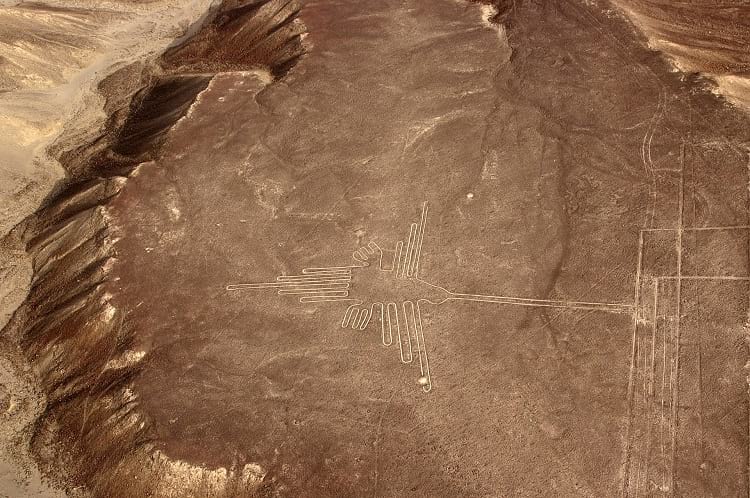
Nazca Lines: Aerial photo of “The Hummingbird” geoglyph in the Nazca Desert. (monikawl999 / Pixabay)
In Peru, there is an arid stretch of a desert valley known as Pampa Colorada, in between the towns of Nazca and Palpa where a collection of geoglyphs can be found, called the Nazca lines. These lines form figures and symbols on such a large scale that they are visible from the sky, they were classified as World Heritage Site by UNESCO in 1994.
These ancient geoglyphs are said to be over 2,000 years old and have been studied by archaeologists and historians for more than 80 years. The first mention of these lines was in 1553 by a Spanish explorer Pedro Cieza de León in his book “Crónicas del Perú” describing the discovery and history of Peru. Though, Pedro mistook them to be trail markers that were used by ancient civilisations to mark the way for guidance during travels.
The origination of the geoglyphs
According to anthropologists, these geoglyphs were created by the Nazca people of South America, hence also called Nazca lines. The lines are of three kinds; straight, geometrical, and biomorphs depicting animals, birds etc. There are over 800 straight lines in the area, some that are nearly 48 km long. The biomorphs are nearly 70 pictorial representations of plants, animals and birds, nearing 1200 feet in length. The region where the lines appear is dry with hardly any wind and almost no rainfall favouring the survival of the Nazca lines over the years.

Owlman also popularly known as “The Astronaut”. (nwhitford / Flickr)
The designs have been made by removing the rust coloured gravel that covers a parched whitish cream coloured land, whereas in some cases, shallow trenches of 10-15 cm form the basis of these lines. There are several lines of varying widths and lengths created in this manner to form figures, shapes, plants, animals, birds, and even human forms. There is also a pictograph of, what seems to be, an “owlman”. The mystery surrounding the Nazca lines still remains with no explicit explanation of what they represent. The longest straight line in this region goes on for 9 miles.
The various explanations to the Nazca lines
Toribio Mejia Xesspe, a Peruvian archaeologist spotted the lines rather by chance on an adventure hike through the foothills, in 1927. He described these as ceremonial roads of religious importance at the XXVII International Congress of Americanists in Lima, in 1939. Paul Kosok, a professor at Long Island University in Brooklyn, New York was quite intrigued by the topic and decided to study the lines to understand their meaning. He was soon joined by his assistant, mathematician and archaeologist Maria Reiche.
On June 22 in 1941, Paul observed that a set of lines came together at a particular point which marked the winter solstice in the Southern Hemisphere. He also discovered the same pattern to mark the summer solstice. This clearly stated that the lines were drawn to mark the changes in the sun’s position in a year. Paul came to the conclusion that these lines might be a record of some sort of an astronomical calendar. He referred to this stretch of approximately 310 square miles as “the largest astronomy book in the world.”
After Paul’s return to the US, Maria Reiche continued the research on Nazca lines. She discovered 18 more figures, of animals and birds. She found that some of the figures were actually representations of constellations in the sky. According to her, the geoglyph of a monkey is actually the illustration of the cluster Ursa Major, while the spider represents Orion.

The monkey geoglyph. (Diego Delso / Wikimedia Commons)
She published her theories in her book “The Mystery on the Desert” in 1949. Though her explanations were debated by many, her work along with Paul Kosok led to a growing interest in the Nazca lines. Such was Maria Reiche’s obsession with the Nazca valley that she had asked to be buried there. She passed away in 1998 at the age of 95, and now rests in peace in the same valley she had devoted her life to.
The evolving interest and theories
The most famous theory that circulated was that of aliens interacting with ancient human settlers. One of the geoglyphs resembles an airstrip which was conjectured to have been used for spaceships to land and take off. The theory was, of course, debunked as no concrete proof has ever been established of alien life.
Boston University astronomer, Professor Gerald Hawkins and his team studied the Nazca lines in 1973 to establish Maria Reiche’s theory of astronomical calendar. After studying 186 lines with a computerised programme, he came to the conclusion that there was only a 20% chance of any likeness to the orientation of stars or clusters.
German archaeologist Markus Reindel conducted a scientific study of the lines in 1997, along with Peruvian archaeologist Johny Isla. They decided to commence their study from an area which was further away from the Nazca Valley. Their observation concluded that the lines led or pointed to actual areas. They were convinced that the lines were directions to areas of settlement and sources of water. The trapezoids were drawn to show the width of water streams and their course.
Recent discoveries
As of April 2018, more than 50 new Nazca lines have been discovered in Peru between the towns of Palpa and Nazca. However, these appear to be several centuries older than the first geoglyphs discovered in the Nazca Valley. The researchers, using lightweight drones to scan the area, discovered these new lines.
These are believed to have been created by the people of the ancient Topará and Paracas settlements. Johny Isla of the Peruvian Ministry of Culture, also in charge of the restoration work and safeguarding of the lines, is of the belief that this changes the previous theories about the geoglyphs.
The Nazca lines have intrigued researchers and many archaeologists for decades now. It can only be hoped that one day we will have answers to their existence.
Enjoyed this article? Also, check out “The Classic Whodunit Mystery of the Marree Man of Outback Australia“.
Recommended Read:
Mystery on the desert: A study of the ancient figures and strange delineated surfaces seen from the air near Nazca, Peru – 1949 | By Maria Reiche
Recommended Visit:
Nazca Lines | Peru
Fact Analysis:
STSTW Media strives to deliver accurate information through careful research. However, things can go wrong. If you find the above article inaccurate or biased, please let us know at [email protected].
RELATED
The post The Incredible Geoglyphs of Peru, the Nazca Lines appeared first on .
]]>The post Voynich Manuscript: An Enduring, Undecipherable Mystery of the Literary World appeared first on .
]]>
A page from the Voynich manuscript. (Beinecke Rare Book & Manuscript Library / Yale University)
The Voynich Manuscript is one of the mysteries of the world that continues to baffle everyone. Written sometime in the 15th century – carbon dating carried out in 2009 points to a period between 1404 and 1438 – it is perhaps one of the most well-known books in the world that nobody has ever read. For the simple reason that nobody has so far been able to make head or tail of its strange, written script.
It is a script like no other and does not match anything in any of the multiple languages that human beings around the world once used and still use. Several high-profile and highly-qualified linguists and cryptologists have tried to decipher the script over the years and all of them have, so far, failed in their attempts. In more recent times, researchers have tried to crack the code using artificial intelligence, but that hasn’t produced anything convincing either.
Origins of the Voynich Manuscript
The truth of the matter is that nobody even knows who wrote the book in the first place. Some sources attribute its authorship to Roger Bacon, the multifaceted genius of Elizabethan England, who seemed to know something about much of the available knowledge of the period. Moreover, he was a dab hand at codes and cryptology. There is, however, no definite evidence pointing to him.
In any case, somebody wrote the Voynich Manuscript and in quite a beautiful hand too, with a quill pen, with seemingly no errors or mistakes in the transcription. This indicates that the person probably copied it entirely from another written manuscript and the copier was an expert scribe, who understood the script he was writing.
Over the ages, the book has passed through several ownerships.

Some pages open up to reveal elaborate diagrams. (Beinecke Rare Book & Manuscript Library / Yale University)
According to one of the stories circulating about this book, King Rudolf II of Bohemia once owned the Voynich Manuscript. In 1639, the book was in the hands of a certain Georgius Barchius of Prague. Since he was unable to read the script, he wrote to Athanasius Kircher, a Jesuit in Rome and one of the leading cryptologists of the period, and apparently sent him some facsimiles of the pages, while refusing to part with the actual volume.
After Barchius’s death, his friend Johannes Marcus Marci, a physician and scientist from Prague, inherited the book and he eventually sent it to Athanasius Kircher, with whom he had corresponded for 25 years. Kircher, however, had no luck with deciphering the manuscript either.

Wilfrid Voynich. (Wikimedia Commons)
In 1912, Wilfrid Voynich, a Polish book dealer, bought the book along with several other antique books, and, since he made it publicly prominent, we now know of the book as the Voynich Manuscript. It was, he said, an oddly plain volume that stood out in a collection of illuminated manuscripts that he discovered in ancient chests in a Southern European castle. The cipher script, the calligraphy, and the illustrations intrigued Voynich, and he assumed it was a ‘natural encyclopaedia.’ He took it with him first to the UK and then to the USA. To have the script deciphered, he had many experts examine it.
There was a stir in 1919 when William Romaine Newbold declared he had managed to translate part of the text, but, in 1931, John M. Manly debunked this claim, and further attempts in the 1940s and the 1960s came to naught. The mystery of the Voynich Manuscript remained a mystery.
P. Kraus, an antiquarian, bought the book for $24,500 in 1961, hoping to sell it for a profit. Not finding any buyers, however, he donated it to Yale University’s Beinecke Rare Book and Manuscript Library. Here it remains to this present day.
Features of the manuscript
The Voynich Manuscript is around 6.5 by 9 inches in size and has 235 pages and some 38,000 words.
The text runs from left to right and has several sections and paragraphs dividing it. These have pen and ink and watercolour illustrations interspersing them. Some of the pages are text only, while others have text and illustrations. Some of the pages fold double. The pages are of calfskin vellum, some with differing thicknesses, and were new when first written upon. The goatskin cover, which binds the pages, has a much later date and is a later addition. The cover is blank, without any title or author inscription.
Since the text is indecipherable, researchers have tried to come up with tentative ideas about the content from the illustrations. Since illustrations of a similar kind appear together in sections, researchers give the sections as herbal/botanical, astronomical, cosmological, biological, pharmaceutical, and culinary/recipes.
The illustrations are in ink and painted with watercolour. There are illustrations of plants, cell structures, gadgets, alchemy equipment, nude women seated in pipe-connected pools and containers, zodiac signs, astrology, comets, galaxies, and even dragons.
Researchers have been able to identify only a few of the plants in the botanical drawings. Some, they claim, are from the New World. Some plant drawings look like combinations of different plants, using the roots of one, the stems of another, and the leaves of yet another. In brief, made-plants that don’t actually exist.

A page from the manuscript appears to be showing various types of unidentified plants. (Beinecke Rare Book & Manuscript Library / Yale University)
The images of women wearing crowns and seated in pools and containers are also puzzling.
Real or an elaborate hoax?
From the illustrations, it seems it could be a medieval medical text, but, given the oddness of some the illustrations, one can’t be hundred percent certain about this.
One researcher claimed that the writing wasn’t so much code as abbreviation and abbreviation of medical terminology at that. The book was about gynaecology and women’s health and its author plagiarised much of it from other medical texts of the period. This version sounds plausible, but other scholars have found inconsistencies and errors with it.
Other hypotheses:
It is a complicated code that, unfortunately, does not have a key or a clue to solving it.
It is an artificial, contrived language.
It is a meaningless hoax, created to gull people for money.
It is a message from the Martians. This may seem far-out, but, in 1896, there was a woman named Helene Smith, who called herself and claimed to have had telepathic conversations with Martians and even wrote down their strange Martian script. Of course, nobody knows how true this is and the Martians don’t appear to have contacted anybody else ever since.
Researchers have tried to use linguistic rules from various languages to make some sense of the Voynich script, but that, again, has not worked out.
The Voynich manuscript continues to defy all decryption.
Since the Berenich Collection has completely digitized the Voynich manuscript, people around the world can now visit their website and view it in its entirety. The efforts to crack the code continue.
View the complete book at archive.org.
Enjoyed this article? Also, check out “Codex Gigas: The Dark Medieval Manuscript Dubbed as “The Devil’s Bible”“.
Fact Analysis:
STSTW Media strives to deliver accurate information through careful research. However, things can go wrong. If you find the above article inaccurate or biased, please let us know at [email protected].
RELATED
The post Voynich Manuscript: An Enduring, Undecipherable Mystery of the Literary World appeared first on .
]]>The post Tunguska Event and the Vulnerability of Our Universe appeared first on .
]]>
Fallen trees, aftermath of the Tunguska event.
We live in a Galaxy replete with millions of stars, the sun being just one of them. And billions of such Galaxies constitute Universe or Cosmos. Some galaxies are so far away from earth that light must travel for billions of years to cover this distance. Hence we never know their ‘present’ status. All we know is how they appeared billion-years-back when the earth was a ball of fire with no life existing on it.
Now imagine a huge cosmic body from the universe hitting a part of the earth and exploding. The blast happened at 7.15 AM on June 30, 1908, and is known as Tunguska Event.
What was the Tunguska Event?
Location was Podokamennaya Tunguska River, Siberia, Russia. No wonder, even 110 years later, our knowledge about ‘why’ and ‘how’ of the blast is inconclusive. All we know is that this explosion was a thousand times more devastating than the atomic bomb that was dropped on Hiroshima, Japan, in 1945. Yet, surprisingly, no human casualty was officially reported (at the Tunguska Event). International Newspapers reported the event as volcanic eruption based on similarities with 1883 volcanic eruption of Krakatoa.
Russian Revolution happened in 1905 and repeated in 1917. The year 1914 saw World War-1. Partly because of these volatile times and partly because of the extremely inhospitable climate of the Tunguska region, a dedicated investigation of Tunguska Event couldn’t be carried out for well over a decade.
What caused the Tunguska Event?
Various theories have done rounds to explain the event. The absence of an impact crater, no evidence of extra-terrestrial material (later investigations though claimed to have found them) and eyewitness accounts varying widely lead to the conclusion that Tunguska Event was caused by a comet hitting the earth.
The comet, largely made of ice, vaporized completely before the hit. But doubts were raised on how an ice body can penetrate so deep into earth’s atmosphere. A nuclear explosion by some alien species was too farfetched to hold ground.
Black hole colliding with earth, causing matter-antimatter reaction leaving no debris, was also mooted. The anger of Gods and alien spaceship crashing while searching for water were other outlandish views.
Lucas Gasperini from the University of Bologna argued that a small lake, Cheko was created by the Tunguska explosion. The lake is unusually deep, he said, whereas all surrounding water bodies are shallow. Also, the lake finds no mention in official records prior to 1908, he contended. Wolfgang Kundt, an Astrophysicist, said the explosion was caused by 10 million tons of natural gas released from earth crust.
None of the above theories succeeded in quelling all doubts. The only thing known for sure was that what fell on earth was a cosmic body. Another theory of a large meteoroid of 50 to 100 meters diameter colliding with the earth seems most plausible. Such meteoroid collisions happen once in a few hundred years.
Russian team led by Leonid Kulik made a trip to the explosion site in 1927 and found eighty million burnt and splintered trees lying scattered across 820 square miles area. A 50Km spread of singed vegetation lay in the butterfly shape. The ground was so deeply scorched that little vegetation grew there even as two decades passed. The manner in which the mutilated trees were sprawled around the epicentre of blast supports the asteroid theory. The energy of the explosion is estimated to have been 10-15 megatons of TNT (trinitrotoluene) and the asteroid exploded some 3-6 miles above ground.
Regarding why no extra-terrestrial material was found at ground zero, it was argued that swampy earth may have swallowed it deep down. Subsequently impact related minerals, like Nano-diamonds, metallic and silicate spherules were found and these were linked to the crashing meteoroid body.
Eyewitnesses saw blasts from as far as 800 Kilometres, strong hot winds shook buildings and shoved materials, seismic waves were recorded in the Western Europe; these point to a cosmic body crash. Impact crater did not form because the meteoroid vaporised completely in the air itself (friction in earth’s atmosphere causes this vaporisation producing bright light which flashed across Siberian and European skies at night).
The caveat in asteroid theory is that the impact related minerals found at the site may have been cosmic dust from small meteorites which keep disintegrating in earth’s atmosphere every day. Further, it is inconsistent with some eyewitnesses saying that explosions lasted more than 10 minutes. A meteoroid fall couldn’t have generated multiple explosions for 10 minutes.
Tunguska event is more than a scientific curiosity. It shows our extreme vulnerability to cosmic events which happen every 100 to 1000 years. Scientists estimate that if the fall of Tunguska cosmic body was delayed by just 4 hours, its target would have been St. Petersburg, the capital of Imperial Russia and not the sparsely inhabited marshy range of Siberia. Should such event happen in today’s world, the extent of damage can only be imagined. Our interface with the Universe is as mysterious as the Universe itself.
Enjoyed this article? Also, check out “The Hum: The Mystery Behind a Humming Noise that Can Be Heard Worldwide“.
Fact Analysis:
STSTW Media strives to deliver accurate information through careful research. However, things can go wrong. If you find the above article inaccurate or biased, please let us know at [email protected].
RELATED
The post Tunguska Event and the Vulnerability of Our Universe appeared first on .
]]>The post Battle of Los Angeles: When the City Fought a Bizarre Battle with Nobody appeared first on .
]]>
Battle of Los Angeles: Searchlights directed towards an unidentified object seen in the sky on 24 February 1942. (Los Angeles Times / Wikimedia Commons)
In true Hollywood style, Los Angeles once fought a battle that never was. It is a well-known fact that the participation of the United States in World War II was instigated by the Japanese. The Imperial Japanese launched a surprise attack against the United States, on Pearl Harbour in Hawaii in the early morning hours of December 7, 1941. What followed then is history. It saw the involvement of the United States in World War II as one of the formidable Allied forces.
The events that led to the battle of Los Angeles
Needless to say, after the military strike on Pearl Harbour, the Americans were wary of an impending enemy attack. The hyperactive nervous tension amongst the armed forces was causing a frenzy at the slightest hint of an attack.
December 9, 1941, set invasion tremors in New York following a misleading, unconfirmed information of an approaching aircraft. Moreover, there were reports from the West Coast of the country of suspicious overactive young pilots and radar men mistaking anything in the waters for an enemy attack.
Apparently, they were mistrustful of everything they saw; fishing boats, floating logs, and sometimes even whales were erroneously assumed to be Japanese submarines.
An increase in Japanese activity off the West Coast had added to the public’s fears and confirmed the reality of the Japanese threat. By December 17 in 1941, the Japanese Sixth Fleet had nine submarines stationed near the West Coast.
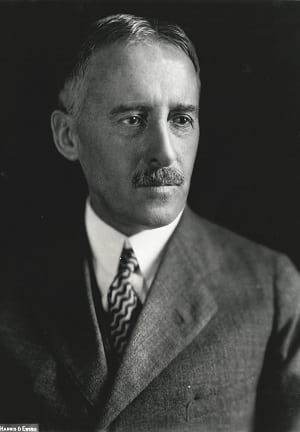
Henry Lewis Stimson. (Harris & Ewing / LOC)
In addition, an announcement by the U.S. Secretary of War, Henry Lewis Stimson, made matters even worse. Germans had attacked the island of Aruba on February 16, 1942, causing damage to the oil refineries and disrupting the fuel supply to the Allied forces. A few days later, on February 19, Stimson announced that the public should be prepared for “occasional blows” since the Army could not be dispersed everywhere.
One of the submarines, the 1-17 surfaced at Goleta, near Santa Barbara in California February 23rd 1942, and fired 13 rounds into the Ellwood Oil Field. Fortunately, it was unable to inflict severe damage. Even though the attack did not cause any casualties, it marked the first bombing of mainland United States. The defence mechanism of the country was having an overload of attack jitters.
Los Angeles air raid
On February 24, 1942, the US Naval intelligence issued the warning of a probable attack within the next 10 hours. That same evening, following reports of flares and blinking lights in the sky, an alert was sounded at 7.18 pm via air raid sirens.
However, the alert was lifted at 10.23 pm when nothing untowardly could be detected during that time period. The defence forces, on the other hand, continued a vigilant lookout for enemy attacks. A few hours later, in the early morning hours of February 25 at around 2.15 am, the radars picked up an object flying 190 km off the coast of Los Angeles.
A realisation dawned on the American soldiers that a war was imminent. Troops were put on “Green Alert“, in a ready to fire position and the searchlights lit up the sky. By 2.21 am it was confirmed that the object was closing in on the city and a city blackout was initiated to prevent identification of targets by the enemy.
Reports of enemy planes over the city started pouring in, though the object approaching seemed to have dropped off the radars and vanished. A 78th Coast Artillery Regiment located in Long Beach reported of enemy planes over the Douglas Aircraft plant. A coast artillery colonel saw 25 planes flying at 12,000 feet towards Los Angeles.
Just a little after 3 am, antiaircraft guns started firing at an object seen above Santa Monica and the Battle of Los Angeles began, continuing over the next 1 hour. Whatever it was that was spotted in the sky, it showed no signs of attacking and neither was it destroyed. The gunners fired 1,440 three-inch shells of antiaircraft guns into the sky without any sign of enemy aircraft fragments or any other enemy damage. By 4 am, it was obvious that there was no enemy threat but the alert was only lifted by 7.21 am.
During the firing, as the shells lit up the sky above the city with explosions, the raining shrapnel caused damage to homes and other building structures. The residents of the city watched the unfolding drama standing on rooftops and hills along the 40-mile arc of the coastline. There were few civilian casualties reported due to the shrapnel and unexploded ammunition that fell. A couple of people were reported to have died of a heart attack due to the tension of an invasion. After the “all clear” was issued; various theories, speculations and explanations followed.
Investigations & aftermath
The official reports that came in from the various regiments stationed along the coast confirmed that enemy planes were definitely flying over the city between 3 am and 4 am. The commanding general of the Southern California Sector in Fort MacArthur stated in his report that a detachment in Santa Fe had sighted 14 planes flying south at 2.35 am. He went on to confirm this by corroborating information received at 3.28 am from Artesia that 14 or 15 planes had been spotted flying west. His report concluded that the presence of unknown planes over Los Angeles from 2.30 am to 4.30 am had been established.
After receiving all the reports and compiling the information, the Army authorities decided on an official count of 15 enemy planes over Los Angeles. California congressman William Johnson made an official statement of 15 planes sighted “flying at slow speed from 9,000 to 18,000 feet“. Later that day the Secretary of War, Henry Lewis Stimson also issued a statement confirming 15 planes, though he made sure that his statement was ambiguous enough to get out of. He mentioned that the planes might have been enemy operated commercial flights flown in numbers to terrorise the Americans or to detect strategic antiaircraft units.
Soon afterwards, the Naval Secretary William Franklin “Frank” Knox announced at a press conference that the air raid had been a false alarm and probably the result of “jittery nerves“. The Air Force and the Navy confirmed that there was no conclusive proof of enemy planes flying over the city on February 25, 1949. The fact that no aircraft carrier could be located in the vicinity dismissed the possibility of an aerial attack. After World War II ended, the Japanese confirmed that they had not partaken any such activity on that fateful day.
Eventually, news started trickling in that the panicking soldiers could have been firing at a floating meteorological balloon. Balloons of 4 feet in diameter were often released by the regiments stationed around Los Angeles.

Weather balloon being prepared for launch. (NOAA Photo Library)
This was to stay updated with the wind directions to make necessary changes in firing of the antiaircraft guns, accordingly. Two regiments had released meteorological balloons in that time frame, that had been carried along the coast with the wind. The balloons were tied to a glass ball with a candle inside to enable tracking at night. However absurd or hilarious the accounts of that day maybe, they do not take away from the dreadful threat of an enemy attack.
Enjoyed this article? Also, check out “Area 51: Is America Really Building UFO’s?“.
Fact Analysis:
STSTW Media strives to deliver accurate information through careful research. However, things can go wrong. If you find the above article inaccurate or biased, please let us know at [email protected].
RELATED
The post Battle of Los Angeles: When the City Fought a Bizarre Battle with Nobody appeared first on .
]]>The post The Tragedy of the Unsinkable Ship – MV Joyita appeared first on .
]]>
Partially sunk MV Joyita. (Xinhua News Agency)
Built in Los Angeles as Luxury Yacht for movie director Ronald West, MV Joyita, the merchant ship, is now a story laced with mystery. It was sold and resold, pushed into myriad jobs and remained in vogue even after the mishap that killed 25 people on board.
Just before the Japanese attack on Pearl Harbour, Joyita served as Yard Petrol boat, YB 108, with US Navy. Damaged heavily in 1943, it was repaired and made operational for sails. When one of its buyer, Louis Brothers, added cork lining to its hull it became ‘unsinkable’, its trademark identity for future.
MV Joyita goes missing
Countdown to ship’s mysterious tragedy begins on October 3, 1955, 5.00AM, as it leaves for Tokelau Islands, some 430 KMs away from the starting point of Apia harbour in the state of Samoa. The sail was scheduled to begin on 2nd October but was postponed as port engine clutch didn’t work. Clutch wasn’t repaired, but the ship sailed off on 3rd with just one engine working. This propped surmise that captain of the ship, Dusty Miller, had some ulterior motive, else why would he venture out without repairing the dead engine?
The ship didn’t reach Tokelau Islands on October 5th as expected, nor did it send any SOS (distress signal) message. This triggered emergency search operations from 6th to 12th October. Air sorties by New Zealand Airforce over lakh square miles of sea surface failed to locate Joyita or any of its dead or surviving passengers.

MV Joyita after being discovered. (Wikimedia Commons)
On November 10th, floating Joyita was sighted by the captain of a merchant ship – Tuvalu. It was in a dishevelled state, partially submerged in water. Four tons of loaded Cargo and 25 passengers were missing. Radio was found tuned to distress channel. Signs of wasting and destruction were evident on Vessel. Life jackets provided on the ship were fewer in number and couldn’t have sufficed for all on board. Three life rafts and a rescue boat were found missing. The starboard (right side) engine was covered with mattress, either to check a leak or to save electric wiring from water splash.
An effort seemed to have been made to operate the water pump, to flush out water flooding into the ship perhaps… Radio set was found disconnected with aerial; hence distress signals couldn’t reach the right place. Navigation lights were switched on and the clock read 10:25; an indication that incident happened at night time.
Ship’s logbook, navigational equipment and firearms were also found missing from the boat (indicating a dedicated attempt at leaving the ship and sail out to safety with the help of survival equipment/rescue boat). A doctor’s bag, stethoscope, scalpel and blood-soaked bandages indicated that Doctor on board attended to an injured. Experts opine that ship may have travelled a distance of 391 KM (just 80 KM short of Tokelau). Failure of engine’s cooling system following corrosion of the metallic pipes was a significant finding.
What really went wrong?
When cargo cruiser Joyita was unsinkable by design, inmates should have stayed on the ship rather than flee. Why did they flee? This question baffled investigators and gave birth to a host of hypothesis.
One view is Dusty Miller; Captain of the ship, either died or got grievously injured creating panic among crew and passengers. A more likely scenario though is fist-fight between Captain Miller and Chuck Simpson (the co-captain and his bête noire) leading to incapacitation or death of one or both.
According to the daily telegraph, some Japanese forces from World War 2 were holding up in scattered island bases and they attacked the ship in vengeance. Cold war between America and Russia being concurrent then, Soviet Submarine kidnapping the occupants of the ship is yet another possibility.
Insurance fraud hypothesis on the subject says Dusty Miller, the Captain, was under huge debt following the failure of his fishing trips on Joyita. But Miller was engaged in a profitable state business which could have easily taken care of his debt burden.
Mutiny hypothesis of Robin Maugham is noteworthy. Crumbling of engine’s cooling pipes and failure of pumps (because of wrongly fitted valves, as would come to light much later on in 1959) led to engine’s flywheel splashing water over the electrical switchboard. Mattresses were flung over switchboard to check damage to electrical fittings with splashed water. This crisis led to a mutiny situation. Miller was desperate to reach a destination (just 80 KMs away from that spot) to save his business. But Chuck Simpson felt that the ship was seriously damaged and couldn’t be trusted to complete the remaining journey. In the brawl that followed Miller was severely injured. Simpson then sailed out with safety equipment/rescue boat, carrying navigation instruments, the crew, the passengers and injured Miller along to the safety of a perceived reef or island nearby. But the group couldn’t reach there because of bad weather and fell to shark attacks or other dangers on the high seas including sea pirates.
In one of the subsequent voyages in 1959, MV Joyita got flooded with water. Exhaust pump, instead of flushing the water out, was found to be filling more water into the hull. Obviously, the pump valves were wrongly fitted. This could have contributed to the ship’s tragedy on 4th October 1955. The crew must have tried to clear vessel of the flooded water but ended up pooling more water into the boat.
Enjoyed this article? Also, check out “The Ghost Blimp L-8 and the Unexplained Disappearance of the Two US Navy Pilots“.
Fact Analysis:
STSTW Media strives to deliver accurate information through careful research. However, things can go wrong. If you find the above article inaccurate or biased, please let us know at [email protected].
RELATED
The post The Tragedy of the Unsinkable Ship – MV Joyita appeared first on .
]]>The post Overtoun Bridge: A Mysterious Site from Where Dogs Leap to Their Deaths appeared first on .
]]>
Overtoun bridge during sunset. (© Joe Son of the Rock / Flickr)
Scotland is one nation, which is not just rich in natural beauty and resources but also has a unique identity of its own. Right from the traditional clothes the Scottish people wear to the food they eat, one can never find this kind of exclusivity anywhere in the world. But apart from the many strange things that have become a part of pop culture originating in this country, there is one bizarre happening that has puzzled people worldwide. Not many people know but a bridge in this mysterious country lures dogs to jump to their deaths.
History of Overtoun bridge
Located in Milton in Dumbarton, Scotland, the Overtoun Bridge was built in 1895 by H. E. Milner – one of the most successful landscape architects and civil engineers of the 19th century- at the behest of John Campbell White, also known as Lord Overtoun. A Category B-listed structure, the ornate yet heavy granite Overtoun Bridge was constructed over the Overtoun Burn creek as an approach road to Overtoun House – the property owned by the Baron.
As the businessman-turned-political-figure bought nearby lands to expand his estate in the late 1890s, he hired Milner’s services to construct a bridge that would make travelling to and fro from his mansion a lot easier.

The mansion across the bridge. (Rosser1954 / Wikimedia Commons)
Incidents on the bridge
But ever since the bridge was constructed, news quickly spread that it was haunted and locals started to believe that it was a hub of paranormal activity. In 1994, a man named Kevin Moy threw his 15-day-old son from the bridge, stating that the child was the Devil incarnate and hence needed to be killed before it could inflict humankind.
The 32-year-old new father also tried to commit suicide by jumping off the bridge but his attempt was thwarted by his wife. When he was taken to the Overtoun House, Moy tried to end his life by slashing his wrists and failed yet again. Though his infant died in a hospital the very next day, he was presented before the court, where the jury acquitted him in the case for being clinically insane and ordered him to be detained in the state hospital. But that was not where the problems began.

Overtoun bridge from below. (© Lairich Rig / geograph.org.uk)
Back in the 1950s and 60s, a bizarre phenomenon rocked the West Dunbartonshire County, as dogs started leaping to their deaths from the top of the Overtoun Bridge. After as many as 50 dogs jumped off the bridge, canine psychologists and animal behavior experts started to look into the matter with deep concern.
One animal behavioral specialist came up with an explanation. Stan Rawlinson said that canines or animals in general, could become depressed but they have no sense of decision-making, hence dogs committing suicide was totally out of the question. He was also of the opinion that since dogs are colour blind, they see the bridge (and every other thing) in a pastel shade, which blends with its surroundings. As a result, dogs cannot gauge where the edge of the bridge is, which could also be one of the reasons for canine casualties. Rawlinson however, stressed on the fact that dogs can sense the occult and that could be one possibility, which led them to take such a drastic step.
Investigations
Local expert Stan Rawlinson’s vague explanations did not suffice other animal behaviorists and they stepped forward to dig deeper into the matter. What came out of their extensive investigations was baffling. Researchers found that dogs were jumping off the bridge on a clear day from the exact same spot and all the dogs belonged to the dolichocephalic breed, meaning they were all long-snouted (like German Shepherd, Scottish Terrier, Doberman).
Dog behavioral consultants summarized that there’s science behind it all. Noted animal behaviorist, Dr. David Sands, offered his insight into the curious case. He said small animals like squirrels, minks and mice that nested under the bridge were letting off a peculiar smell, which stimulated the dogs’ olfactory nerves. As a result, these long-nosed canines, with a strong sense of smell, were lured into hurling themselves off in pursuit of the smaller animals.
He also added that dogs are naturally inquisitive like any other animal, and wanting to peer down the bridge is one of the most logical reasons why they tried to get closer to the edge, resulting in their fall.
But when locals convinced them that minks were never found in the area, they had to start looking for newer angles again. As of now, approximately 600 canines have tried to leap to their tragic end from the century-old Overtoun Bridge, hitting hard 50 feet on the rocky surface below. Eyewitnesses also say that if a dog fails in its first attempt, it returns to the edge to jump for the second time.
The Scottish Society for Prevention of Cruelty to Animals (SPCA) is continuously working towards finding the trigger that has led so many canines to meet such a fate, but it has only come to a naught each time. Meanwhile, it has also alerted citizens to keep a strict watch over their pet pooches while crossing the obscure bridge.
Enjoyed this article? Also, check out “Animal Suicide: Do Animals, Like Humans Resort to Ending their Own Lives?“.
Optional Visit:
Overtoun Bridge | West Dunbartonshire, Scotland
Fact Analysis:
STSTW Media strives to deliver accurate information through careful research. However, things can go wrong. If you find the above article inaccurate or biased, please let us know at [email protected].
RELATED
The post Overtoun Bridge: A Mysterious Site from Where Dogs Leap to Their Deaths appeared first on .
]]>The post The Classic Whodunit Mystery of the Marree Man of Outback Australia appeared first on .
]]>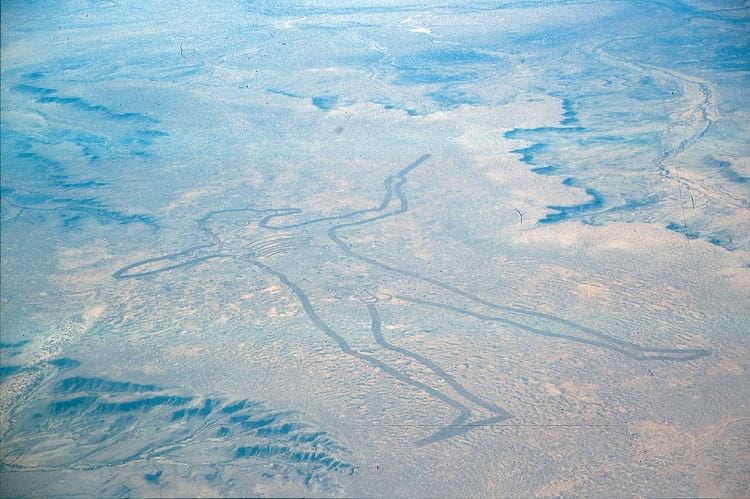
Aerial photo of the Marree Man from 1998. (Peter Campbell / Wikimedia Commons)
Twenty years have passed since a pilot first spotted The Marree Man — a bewildering colossal artwork whittled into the desert sands in a dim and distant town of Marree in parts of southern Australia, nearby to the far-reaching military Woomera Prohibited Zone. Its origin and the people behind its formation are still nameless. It is extensively recognized as the second largest geoglyph (an enormous design etched on the ground) in the world.
Initial sighting of Marree Man
A charter flight was travelling over South Australia on June 26, 1998, between Marree and Coober Pedy, a town known for its opal mining. Its pilot Trevor Wright was the first person to spot the towering figure of an indigenous tall and naked man spread over 2.6-miles along the desert sand. His left arm was raised, ready to strike prey with a woomera (a hunting stick) or a boomerang.
The carving was coined the Marree Man after the non-descript outback town of Marree in whose vicinity it was discovered.

Satellite photo of Marree Man from 28 June, 1998. (Diceman / Wikimedia Commons)
The widely incised borderlines gouged out by 10 inches below the ground, could be visible only from the air above. However, despite the exact planning, precision and absolute intensity invested in making it, nobody approached to profess the geoglyph’s authorship and seemingly even no eye-witness was traced to corroborate its creation.
Unidentified press releases
Shortly after its revelation, between July and August 1998, the media and local businesses received sundry press releases from an unidentified source. Specific features of the writing highlighted the guesstimate of it being the handiwork of a foreign author and that the Marree Man was the creation of the natives from the United States.
To start with, the letter had measurements being cited in units of miles, yards, and inches. It was a strange drift from the metric system used in Australia. The releases further mentioned names and phrases like “your State of SA”, “local Indigenous Territories” and “Queensland Barrier Reef” that were queer terms hitherto not being used by Australians.

Outline of Marree Man. (Lisathurston / Wikimedia Commons)
The press release also had a reference to the Great Serpent Mound in Ohio, something which hardly had any cognition outside the US. There were widespread conjectures about these press releases being more of red herrings placed tactfully by an audacious eccentric to render the impression of an American authorship.
Discovery of a plaque and strange items
Adding to the puzzle, were a bunch of peculiar items discovered from a freshly dug out trough at the site. They comprised of a small glass jar that contained a tiny flag of the United States, a photo of Marree Man clicked from a satellite and a note which had remarks about the Branch Davidians, a Texas-based cult group that had its cult leader David Koresh and 82 other followers killed following a raid in 1993.
In January 1999, after receiving a fax message, officials surrendered to their curiosity, dug up the area and unearthed a dedicated plaque buried in close proximity to the figure’s nose.
The plaque was essentially the American flag with an engraving of the Sydney Olympic rings and bore the statement “In honour of the land they once knew. His attainments in these pursuits are extraordinary; a constant source of wonderment and admiration” which had its origin from a book titled “The Red Centre” written by Hedley H. Finlayson in 1946.
The quote was lifted from a page narrating about the poaching of wallabies with throwing sticks and included the photos of aboriginal hunters short of loin clothes that resembled very much the Marree Man.
It may be mentioned here that the book deals with the existence of the Pitjantjatjara tribal hunters. Investigators attempted to connect the dots with these weird accumulations of clues but all their efforts were in vain.
Conjectures about the creation
Rumours were running amok around the tiny hamlet of Marree. Some expressed their opinions about the geoglyph being the brainchild of an inhabitant flight operator, who pulled off this stunt to amass huge profits from the deluge of tourists who started visiting the place post its discovery.
Surely, the local charter flights were found to be plying overtime in meeting the burgeoning demand for joy rides to have a look at the amazeballs spectacle the ground below.
Different odd hypotheses that began doing the whirlwind rounds indicated at Marree Man being the creation of extraterrestrials who descended with an intent to throw caution to a politician named Pauline Hanson against his despicable racist remarks about Australian Aborigines.
Surveyors theorize that a bulldozer might have been used to sculpt the figure and taken a long time to finish, yet nobody could sense a hint of suspicion about seeing or hearing a thing or two. Just a single track was used as an entry and exit point from the site, however, no discernible footprints or tyre marks could be detected. Even a thorough-going police examination came up with nothing substantial.
Most suggested creator
Then there came Bardius Goldberg, who was an Australian craftsman and had expressed enthusiasm for creating a masterly work that could be visible from space. Goldberg, however, showed an inherent proneness towards being provoked. He also had a knack to concoct aboriginal dot paintings in the neighbourhood of the desert town of Alice Springs.
He incidentally got entangled in a hostile dispute with Herman Malbunka, a local landowner. He threatened Malbunka with dire consequences and borrowed a tractor along with a GPS to transmit him a vile notification containing the Marree Man’s silhouette. It had been reported by few of his friends that Goldberg was paid a hefty sum of $10000 to create the figurine.
When Goldberg was confronted about it, he neither affirmed nor denied the rumours on Marree Man’s creation. Unfortunately, Goldberg passed away in 2002 before this theory could even be totally investigated.
Others anecdotes have apprehended that Australian Army members or American soldiers who were positioned in Woomera had designed and fabricated Marree Man.
Revival initiatives of the abraded geoglyph
The monumental geoglyph of Marree Man quickly became an icon and made the township a largely popular tourist spot. But the famous carving was gradually fading into oblivion because of natural erosion by shifting sands and forceful desert winds and could gradually be seldom seen. It seemed only a matter of time before the prodigious illustration would cease to be visible evermore, confiscating the secrets of its creation alongside.
In 2013, through a landmark initiative, some passionate natives submitted a public plea, spearheaded by Phil Turner, a pub owner in Marree to plough back the outline into the sands and revive the geoglyph. According to Turner, it had everything to do with reinforcing the mystery and the myth.
Turner in a bid to strengthen the tourism business embarked upon the project costing half-a-million dollars along with the Arabana Aboriginal Corporation to enliven the artwork after its considerable dissipation into the sand.
The latest technological advancements made it convenient for them to locate the eroded Marree Man in 2016, with the support from a zealous and prolific restoration team and redefine the geoglyph using imaging data, a grader, GPS and satellite images.
Enjoyed this article? Also, check out “The Incredible Geoglyphs of Peru, the Nazca Lines“.
Recommended Visit:
Marree Man Historical landmark | Australia
Fact Analysis:
STSTW Media strives to deliver accurate information through careful research. However, things can go wrong. If you find the above article inaccurate or biased, please let us know at [email protected].
RELATED
The post The Classic Whodunit Mystery of the Marree Man of Outback Australia appeared first on .
]]>The post Solway Firth Spaceman: Did Someone Accidentally Film an Alien on Camera? appeared first on .
]]>
Solway Firth Spaceman: The unidentified figure behind five-year-old Elizabeth. (Jim Templeton / Wikimedia Commons)
A photograph is the proof of a memory that a person would want to hold on to forever. It is something that would take him back in time and remind him of the good things that were captured on film at that time. But there was one Englishman, who did not know that a regular photograph he had clicked way back in the 60s, would become one of the most talked about mysteries of the world even after all these decades.
In the summer of 1964, on a bright, sunny morning in May, a Carlisle firefighter named Jim Templeton was out on a picnic trip with his family near the lush green Burgh Marsh, which overlooks Solway Firth, separating England from Scotland in Cumbria. Templeton was a local historian and also had a flair for photography, which he showed off occasionally on his brand new Kodak camera he had bought back then.
While lazing around, he decided to capture a few candid pictures of his five-year-old daughter Elizabeth, who was playing in the grass in the distance. He held up his camera and took photos of his girl wearing a new dress and the family came back home, all happy about the day trip. Little did the Templetons know that when the negatives of the pictures would come back from the photography lab, one of those would have a very mysterious story to tell the world.
The photograph
Jim Templeton went to the lab to get his developed pictures and was taken aback by the technician’s comment on the said photograph. The photo had his daughter Elizabeth sitting in a relaxed pose, flaunting her new dress, while an image of an unidentified figure dressed in a spacesuit, jutted out of her head in the background. It was a clear picture of an obscure figure dressed in a white spacesuit, complete with a white helmet covered with a dark brown visor.
Conspiracy theorists immediately got down to work, floating stories of the presence of UFOs and aliens around us, while researchers began looking for logical answers. The photograph was published in many newspapers of the world, making headlines and it came to be known as the “Solway Spaceman”.
Jim Templeton took the picture to the local police that rubbished his spaceman claims and did not find the photo extraordinary. Kodak Film Company also came forward offering a reward to those who had an explanation, proving the picture was fake; but nobody could ever prove it otherwise. Solway Spaceman became one of the hottest topics of worldwide discussions, which garnered a lot of public interest.
Conspiracy theorists believed that sightings of UFOs were real and that we are surrounded by aliens, invisible to the eye, which Jim Templeton had managed to capture on film accidentally. The fireman appeared on several television shows after the Solway Spaceman image spread quickly across the globe, presenting his side of the story.
Theories behind the Solway Firth Spaceman
In an interview with the BBC, he said that apart from two old men sitting in their car, his daughter Elizabeth and his wife Annie, there was nobody else that could have managed to sneak in the frame, without him noticing. Templeton also stated that during that time, a British medium-range ballistic missile called “Blue Streak” was supposed to be launched from Australia’s Woomera Test Range, which later had to be aborted due to the sighting of two strange-looking men that technicians claimed were similar to the description of the Solway Spaceman in his image.
Locals also asserted that they had sighted a UFO recently. He also told the media house that two government agents had paid him a visit wanting to know about the exact location in the photograph, but later declared that it could have been a practical joke played on him. While none could confirm that his stories were true, experts could also not completely dismiss them as false and the Solway Spaceman debate only kept heating up.
Dr David Clarke, who is an investigative journalist as well as an expert UFO author, stepped forward in 2014 to explain the Solway Spaceman image, giving logical reasons, which professionals agree could have been the only possible and plausible answer to the frequently-asked question bothering the world since 1964.
According to Dr Clarke, Templeton couldn’t have seen his wife walking into the frame because the viewfinder of that particular camera was able to capture only 70% of the actual shot, thus finding her in the photo only after the negative developed. Also, since it was a bright and sunny day, Templeton’s dark-haired wife, who was wearing a pale blue dress on that particular day, was overexposed in the film and appeared to be wearing a white dress, thus making her the Solway Spaceman, everybody talked about for all these years.
Whether the spaceman had actually come from another world and had gate crashed into his family photograph or his stories regarding his meeting with the men from the ministry could never be proved; Jim Templeton’s genuine Solway Spaceman picture proves that some memories truly do live forever.
Enjoyed this article? Also, check out “Everything You Need to Know About Spontaneous Human Combustion“.
Fact Analysis:
STSTW Media strives to deliver accurate information through careful research. However, things can go wrong. If you find the above article inaccurate or biased, please let us know at [email protected].
RELATED
The post Solway Firth Spaceman: Did Someone Accidentally Film an Alien on Camera? appeared first on .
]]>The post Naga Fireball: Glowing Orbs that Enlighten the Mekong River in Thailand appeared first on .
]]>
Naga Fireball launching from the Mekong river. (Thailand Tourism)
The Naga Fireball is a phenomenon in which bright glowing orbs emerge across a considerably wide stretch of Mekong River near the province of Nong Khai in Thailand. Every year, thousands of these ‘fireballs’ varying from the size of a fist to a basketball emerge from the river waters and rise up quickly as they burn, just to form a beautiful spectacle for the thousands of tourists who flock there every year to witness it. While there is no accurate estimate of ‘what heights’ these fireballs rise to, people have reported seeing them rise as high as 800 meters up in the sky.
The strange-but-beautiful phenomenon occurs during late October. While the reason behind the fireballs is certainly not clear, both science and spirituality have taken two different stances.
What does the legend say about it?
According to the folklore, this is the time for the ‘Phayanak’ festival. This festival marks the return of the Buddha at the end of the Buddhist Lent. According to the common mythology, a powerful yet benevolent river serpent, ‘Naga’ wakes up every year this time to welcome Lord Buddha. As a result, people say, these fireballs are nothing more than the breath of the Naga. Nagas are giant snakes, quite commonly mentioned in several mythological texts throughout the all of South-East Asia including the Indian sub-continent. The ‘Phayanak’ is the king of Nagas.
The festival of Phayanak is held on “15th day of the 11th Lunar month, which is a full moon that usually falls in October, the Phayanak festival is held” reports Skeptoid. The locals are more than willing to tell about their childhood stories when they managed to see the ‘Naga’ swimming through the river waters.
A photo of 30 US soldiers holding a long sea creature that looks like a giant snake is in circulation in Nong Khai, minting a handsome amount of money to the locals. This photograph is often posited as the evidence of the ‘Phayanak’ or the ‘Naga’. The photograph is titled ‘Nang Phayanak’ and its caption reads, “The Queen of the Nagas seized by American Army at Mekong River, Laos Military Base on June 27, 1973, with the length of 7.30 meters.”

The famous photo that circulates claiming it to be ‘Naga’. (Wm. Leo Smith / U.S. Navy)
How do scientists explain this phenomenon?
While this folklore sounds really enchanting, it isn’t really that convincing. After all, we live in the 21st century and science has backed several such phenomena with principled explanations based on reasoning. Science has tried to use the theory of ‘Swamp Gas’ to explain this phenomenon. According to this theory, the organic deposits on the riverbed of the Mekong river decompose, releasing ‘methane’ gas. Methane is volatile in nature. As a result, when it comes in contact with oxygen, it ignites, forming the ‘fireballs.’
Despite being a true theory, it requires a special and elaborate set of conditions to take place. There is a specific alignment of the sun, the moon and the earth that causes the oxygen levels near the surface of the river to rise up to abnormal levels, igniting the pockets of methane that are released. When these conditions are again met in the month of May, the fireballs can again be seen rising up. This is not a universal or official explanation, but a widely accepted one. This explanation is refuted by some claiming that the Mekong riverbed doesn’t offer ideal conditions for methane to rise up the surface.
There’s another similar explanation that insists that a gas rises up to the surface of the river and then ignites when it reaches (the) surface. However, in this case, the gas is phosphine, not methane. Phosphine is a gas similar to methane, just a bit more volatile and reacts similarly with oxygen. However, phosphine is not a naturally occurring gas. Theorists suggest that the bacterial decomposition of the phosphate deposits along the river produce this gas, they are not quite sure why, but, this argument still seems plausible.
Is the ‘Naga Fireball’ phenomenon just a hoax?
While all of the above theories create a buzz, none of them creates a controversy. Let’s talk about something more controversial. In 2002, an iTV documentary claimed that the fireball show was a ‘hoax’. The Mekong River also borders Laos. The team of the documentary named ‘Code Cracking’, silently travelled to the Laotian side of the river on the night of the festival. After crossing the river, they found that it was Laotian soldiers who were firing the tracer rounds in the sky. The fireballs were nothing but just fireworks whose sound was masked by the happily cheering crowd on the Thailandian side. The people who saw the clip also started to believe that the fireballs phenomenon was rigged and that there was nothing mystical or special about it. It was just a simple show of fireworks.
When the documentary was aired in 2002, it created controversy and faced severe criticism. Surprisingly, the subsequent year, Thailand witnessed a 166 per cent rise in tourism with 400,000 tourists flocking to see the ‘fireballs’ compared past year’s number of mere 150,000. This sudden burst of 250,000 people brought in revenue of 2.5 million dollars.
Going back to the photograph of the ‘Nang Phayanak’, it was clicked by Lt. DeeDee Van Wormer. The ‘giant snake’ we were talking about is a just a giant Oarfish that U.S Navy SEALs managed to come across during a beach run in Coronado, California. Oarfishes live in salty waters across the world. It is quite rare to spot one but several people have done so.
We don’t know which theory is true and should be believed. But interestingly, while this festival has ancient roots to it, we only find written records of Naga Fireballs as late as the 20th century; there is no written record prior to it.
Enjoyed this article? Also, check out “Tunguska Event and the Vulnerability of Our Universe“.
Fact Analysis:
STSTW Media strives to deliver accurate information through careful research. However, things can go wrong. If you find the above article inaccurate or biased, please let us know at [email protected].
RELATED
The post Naga Fireball: Glowing Orbs that Enlighten the Mekong River in Thailand appeared first on .
]]>The post Unknown Woman of the Seine or L’Inconnue de la Seine: Timeless Model of the CPR Doll appeared first on .
]]>
The death mask of the unknown woman of the Seine. Circa 1900. (Gourami Watcher / Wikimedia)
The eternally celebrated woman who died a supposedly unnatural death in the Seine River surprisingly doesn’t have any identity at all. This may sound profoundly ironical. She is well-known as “L’Inconnue de la Seine” (English translation: The Unknown Woman of the Seine).
In the later part of the erstwhile 19th century and sometimes in the early 20th century, a piece of art that garnered extreme popularity in most of the modish and artistic French homes was the absolutely ominous death mask of L’Inconnue de la Seine. She was an anonymous young lady (somewhere around the age of sixteen) whose visage propelled the creation of a multitude of diverse literary and artworks. The mask is widely recognized as “La Belle Italienne” in the United States.
Making the death mask of the unknown woman of the Seine
As the regularly rehashed story goes, sometime in the 1870s or 1880s, the frigid body of this young woman was extricated from the Seine River in Paris at a place called Quai du Louvre. As her body was found to be bereft of any wounds or signs of violence, it was conjectured that she might have committed suicide. The story progresses with the entry of a pathologist at the morgue where her body was taken for the post-mortem. The pathologist was so entranced and charmed by her bewitching beauty that he decided to preserve her quiescent face by making a plaster casting, a death mask. He instantly called in a moulder and put him into the task.
In the following decades, the resultant original mask was reproduced abysmally on a large-scale and sold as a quintessential and inimitable artefact that graced the walls of countless private homes and art studios in France and later abroad, upholding the Parisian Bohemian culture. L’Inconnue de la Seine became so influential that she was being heralded as the archetypal muse for several poets, artists and writers like Pablo Picasso, Rainer Maria Rilke, Man Ray, Vladimir Nabokov and their ilk. Vladimir Nabokov composed an endless poem in 1934 titled “L’Inconnue de la Seine” where he kept pondering over the reason for her probable suicide.
Admirers of L’Inconnue de la Seine
Renowned French philosopher, author and journalist Albert Camus likened her to Mona Lisa, with her enigmatic smile winning the imagination of millions of admirers. Everyone began calling her the “drowned Mona Lisa.” The cast was also once called the “Bewitching Woman”, a sobriquet that anyway never became voguish.
Speculations were rife whether the expression on the face could ever resemble the one of a drowned and suffocated person. Many people started wondering what hints the frightfully cheerful demeanour on her face could reveal about her history and family background. Some reports contrarily suggested that the mask belonged to the face of the daughter of a German mask producer, who committed suicide in the Seine River after coming to know that she had given birth to a stillborn baby.
The notoriety of the figure is additionally important to the historical backdrop of the artistic media, identifying with its far-reaching replication. The original cast was believed to be photographed and new replicas were made thereafter from the negatives of the film.
L’Inconnue de la Seine still remains contemporary and vivacious in an off-the-beaten-path family-run workshop named L’Atelier Lorenzi that was established in 1871 at Arcueil in southern Paris and specializes in creating handmade plaster figurines, statues, busts and masks. The death mask is still a best seller at their workshop.
Description of the L’Inconnue de la Seine
L’Inconnue’s face evokes a feeling of tranquillity. She has a round face and an alabaster skin. Her eyelashes appear tangled thereby giving an impression that they are wet. She has a middle parting on her hair that is hauled back behind her neck. She looks youthful, yet you can’t call her a traditional delight or a beauty. But peculiarly, hordes of young girls attempted to imitate her frozen and stone-dead look in gay abandon.
Her half-grin infuses a mysterious haunt. Her lips exhibit no clarity, maybe the aftereffects of her body’s downturn. She appears to be exuberant in her death. What’s more, her eyes look as though they may open whenever.
Theories of her identity
Sceptics, however, have asserted that the lady portrayed in the mask couldn’t have been a drowning casualty since her facial features were just too perfect to be true. On the other hand, a few scholars attest that it was a regular practice to re-sculpture death masks at that time. L’Inconnue has been envisioned as a victim in literature. She is believed to have drowned herself in utter sorrow after a rendezvous with an English aristocrat who enticed and later abandoned her.
Furthermore, she has been depicted as a sorceress, who devastated and ravaged a young poet. She is also imagined to be a temptress who became a witness to a burglary and a killing at a clockmaker’s shop.
However, neither any record exists in the Paris police documents, nor was there any trace of her body.
Turning into CPR doll
In 1960, an Austrian doctor, Dr.Peter Safar was in the midst of constructing a new technique to effectuate cardiopulmonary resuscitation, commonly known as CPR. Safar approached a Norwegian toy maker, Asmund Laerdal, to create a dummy, essentially a woman’s face that would have nothing scary or startling about it.
Laerdal chanced upon the mask of L’Inconnue de la Seine at one of his relative’s place. The magnitude of serenity on her face reached Laerdal to his discovery of the ideal fit for the CPR dummy.
After a couple of little adjustments comprising of an unfenced mouth that perhaps awaited a life-saving breath and flared nostrils, Safar and Laerdal unfurled “Resusci Anne” the world’s first CPR dummy. In this way, a death mask became the face of life.

L’Inconnue de la Seine after being remodelled to CPR dummy. (Phil Parker / Resusci Anne)
You might have come across her face and even had those lips kissed. Resusci Anne is still manufactured by Laerdal Medical, which also incorporates the story of her Seine suicide, adding that, she now embodies a hallmark of life to a large number of people all through the world who have learnt and nurtured this life-giving procedure of modern resuscitation, and especially to those, whose precious lives she has saved from sudden and untoward death incidents.
Fact Analysis:
STSTW Media strives to deliver accurate information through careful research. However, things can go wrong. If you find the above article inaccurate or biased, please let us know at [email protected].
RELATED
The post Unknown Woman of the Seine or L’Inconnue de la Seine: Timeless Model of the CPR Doll appeared first on .
]]>The post Man in Iron Mask: The Identity of a French Prisoner Who Kept his Face Covered with Iron-Mask appeared first on .
]]>
Portrait of the Man in Iron Mask. (Library of Congress)
Circa 1669-1670, a man is arrested and incarcerated in a chain of French Prisons with his face covered. He dies in prison in 1703 as someone named ‘Marchioly’. His jail term passed in the custody of one and the same jailor, Saint Mars. For the life of him, he was directed not to reveal his identity to anyone. Who was this unusual prisoner with the iron mask? There are several theories.
Voltaire, the French Writer said (1771) that this prisoner was the elder brother of the reigning King Louis XIV. His surmise was based on his one-to-one with co-prisoners (Voltaire was imprisoned at Bastille for airing views against the government). He said that the chin of the metallic mask was made of steel springs which enabled chewing of food at mealtimes. Quoting oldest prisoners, Voltaire asserted that the condemned man was elite and treated like royalty. It’s hard to rule out though that this could be an imagery of the Writer Philosopher.
The relation between the jailor and the unidentified prisoner
After the death of Saint Mars, it transpired that the jailor was rude to the prisoner he gave company to for more than 3 decades. Money paid by the state for spending on prisoner’s welfare was pocketed by him for his personal use. This was evident from the fact that a prison cell had only one sleeping mat, no other facility.
Records of 1669 show a missive from Marquis de Louvois, a minister of King Louis XIV, to Saint Mars, the governor of the prisons of Pignerol (part of France then). It said that a prisoner named ‘Eustache Dauger’ would arrive in a month’s time and he must be provided top-end security. His cell must be made soundproof with multiple doors. Saint Mars should personally visit the prisoner once daily to inquire about his welfare. Prisoner’s basic needs, it said, would be minimal (since) he came from service class. Governor must also warn prisoner that if he dared reveal his identity, he would be shot dead.
Named ‘Eustache Dauger’ in above letter appeared to be an ‘afterthought’ as it was penned in a different handwriting. Looks like Louis, first of all, dictated the letter to someone and then ‘planted’ a different name in the finished text. Dauger was arrested in Calais bypassing the protocol of informing the local governor about his arrest.
The prison at Pignerol housed a minimum of selected criminals perceived as an irritant to state administration. Eustache Dauger was the most docile of all prisoners. This counters royal blood theory as one from a royal family must have the attitude. In 1681 Saint Mars was transferred to the prison of Exile Fort (presently in Italy). Dauger too moved with him to the same place. In May 1687 the jailor-prisoner duo moved to Sainte Marguerite, an island half a mile offshore from Cannes. It was this transfer which fuelled speculations about a strange prisoner-in-iron-mask. On 18th September 1698, Saint Mars again shifted, to Bastille prison in Paris. There too, Dauger accompanied him. A jail officer observed that the mask was black velvet, not iron.
After the death of the man in iron mask
Dauger, however, died on 19th Nov 1703 and was buried at Fort Royal, Lerin’s Islands, with a different name, Marchioly. All his possessions were carefully destroyed. Even the walls of his cell were scratched clean and repainted. A belated concern of princess Palatine, sister-in-law of King Louis, raked the already muddied waters. She said that two gunmen were constantly watching the prisoner, ready to kill him if he unmasked to reveal his identity. She described Dauger as a deeply religious individual who got VIP treatment in his lock-up. However there is no explanation for why she was silent when Dauger was alive and spoke only 8 years after his death, she wasn’t taken seriously.
According to a University Professor Mr Sonnino, the man-in-iron-mask was assistant to a treasurer in the service of Cardinal Mazarin the Chief Minister of France. In his book: The Search for the Man in the Iron Mask- a Historical Detective Story, he says that Mazarin amassed great wealth by cheating on the previous king and queen of England. Dauger, on a lighter note, spoke about Treasurer’s dishonesty. That infuriated Treasurer to arrest him and put behind the bars. Dauger was also warned that for the life of him he should remain forever incognito.
Why have the historians missed the link of the scheming treasurer?
Mr Sonnino replied that Historians look for a straightforward narrative whereas the truth is too complicated to fit into a simplistic dispensation. He dismissed the popular notion that prisoner always wore a face mask. He said the mask was put on occasionally (most likely during jail to jail transfers) and it was made of velvet (not iron). From 18th century onwards, the identity of the prisoner became a cocktail of facts and fiction. Stories were spun around him and the mystique of veiled face grew unchecked. Latest to harp on this mystique is Leonardo di Capri film ‘the Man in the Iron Mask’ released in 1998.
Hugh Ross Williamson has argued that the prisoner in question was the father of King Louis XIV. Old and physically weak Louis XIII was estranged from his wife Anne for 14 years, and it is likely that his wife conceived (the future King Louis XIV) from an arranged person. The proxy father of Louis XIV migrated to America but returned to France in 1660 and tried to blackmail the royal family over the illegitimacy of the reigning King. That triggered state action for his immediate arrest and incarceration under a fictitious name to keep the King’s honour intact. Various other theories have identified the prisoner as an English Nobleman, son of Louis XIV, a French General, a Government minister and an Italian diplomat.
The last word though is Dauger, his full name – Eustache Dauger de Cavoye. A maverick, Dauger was involved in illegitimate trading of Aphrodisiacs and Poisonous substances. Eventually, he got entangled in the affairs of the poisons, a huge scandal involving the sale of poisons, devil worship and infant sacrifice. Mistress of King Louis was also involved in the scandal. This forced the king to exercise utmost secrecy in prosecution proceedings of the case. The secrecy was also extended to the jail term of the convict producing the myth of the masked prisoner.
Enjoyed this article? Also, check out “Unknown Woman of the Seine or L’Inconnue de la Seine: Timeless Model of the CPR Doll“.
Recommended Read:
The Search for the Man in the Iron Mask: A Historical Detective Story | By Paul Sonnino
Fact Analysis:
STSTW Media strives to deliver accurate information through careful research. However, things can go wrong. If you find the above article inaccurate or biased, please let us know at [email protected].
RELATED
The post Man in Iron Mask: The Identity of a French Prisoner Who Kept his Face Covered with Iron-Mask appeared first on .
]]>The post The Curse Of The ‘Crying Boy Painting’ That Haunted People During the 80s and Killed Many appeared first on .
]]>
Painting of crying girl by Giovanni Bragolin. (Andreas Faessler / Wikimedia Commons)
The Crying Boy was a series of paintings of tearful boys, painted by an Italian artist, Giovanni Bragolin who was also known as Bruno Amadi. It is alleged that various altered versions of The Crying Boy Painting were distributed during the 1950’s and the years that followed by. It is also believed that there is a jinx related to this painting.
According to an urban legend, the artist fled to Spain after the orphanage he painted was gutted in a mysterious fire. He worked in a post-second world war Venice and used to churn out paintings of crying boys for the tourists there. Amadio, under the name of Giovanni, painted as many as 65 children, boys with teary eyes, looking straight. These paintings highly influenced people and touched them.
The Crying Boy Painting curse
The year was 1985, when disturbing news related to the paintings, spread like fire. Daily newspaper The Sun had printed a piece on the painting titled, ‘Blazing Curse of the Crying Boy’. It was regarding a house fire in Rotherham (a town in England) of a couple, Ron and May Hall a town in England. The blazing fire brought down their house, which originated from an unattended frying pan catching fire.
Everything in the house was destroyed. But only one item survived, it was a painting of the crying boy that fell, face down, and was slightly charred. The report also talked about how in the area, this was not the first instance. In many of the fires in the neighbourhood, despite everything burning down, the only piece that survived in the household was a copy of this Crying Boy painting.
Things started getting weirder when the report suggested that the fire-fighters thought the painting to be cursed and The Sun’s wide audience agreeing to it. Alan Wilkinson, a fire station officer, had reportedly logged as many as 50 fires where the Crying Boy Painting was found. People started associating the fires with the curse of the Crying Boy painting.
Public panic became real. Finally, after another big fire that occurred at an Italian restaurant, the publication requested its readers to send in their Crying Boy paintings to the office. They organised a mass bonfire of the paintings, which at first were hard to burn but later succumbed to it. Another interesting story around the Crying Boy painting is that of the boy in the painting, itself. It is believed that his name was Don Bonillo, an orphan whom Amadio had adopted. But the child, who was mute, was believed to be cursed and was called the devil child as he had seen the death of his parents in a house fire which happened during the Second World War. The local priest had warned against adopting him, but Amadio didn’t listen. They lived happily together. But one day, his studio and apartment both caught fire. Amadio then blamed Don for it and threw him out of his house.

A newspaper article reporting on the painting’s bonfire. (Courtesy: Dr. David Clark)
Years later, during 1976, a report about a car crash and a burnt body caught attention. It is believed that the body had burnt beyond recognition. In the glove compartment of the car, the driver license – which was not destroyed in the car’s fire – read Don Bonillo. After the mass bonfires, the stories of the cursed fires started waning. But till date, the curse was neither proven nor denied.
Were the paintings really cursed?
Years later, Steve Punt a noted comedian and actor investigated the case of the crying boy painting and the curse related to it. The investigations were carried out on a show called Punt PI. Though the show had a comic outline, Punt certainly reached a conclusion which was followed by investigations at the Building Research Establishment. It was concluded that the prints were put through a fire retardant. It was further revealed that the painting would fall down with the face on the floor due to fact that the thread holding the painting, that would burn first in case of a fire. This would have thus protected the painting.
Enjoyed this article? Also, check out “The Hands Resist Him: A Haunted Painting that Spooked the Virtual World for Decades“.
Fact Analysis:
STSTW Media strives to deliver accurate information through careful research. However, things can go wrong. If you find the above article inaccurate or biased, please let us know at [email protected].
RELATED
The post The Curse Of The ‘Crying Boy Painting’ That Haunted People During the 80s and Killed Many appeared first on .
]]>The post Path to Blood and Insanity: Uncovering the Mystery of the Hope Diamond appeared first on .
]]>
Hope diamond on display at the Smithsonian National Museum of Natural History. (Julian Fong / Flickr)
The Hope Diamond is believed to be one of the most precious gems in the world. The gem is characterized by a dazzling blue color and weighs almost 45 carats. Though mankind has always been fascinated by the existence of diamonds, the story of the Hope Diamond gained popularity over the last few centuries, due to all unusual reasons. Hope Diamond has not only remained a matter of pursuit to researchers but kings, priests, institutions, jewellers and merchants too.
People are not only attracted towards this magical gem because of its shine and appearance; there is something more to the story of the Hope Diamond. If history and folklores are to believed, it is said that the diamond is cursed. In the following paragraphs, we will explore how the curse of the hope diamond led to misfortunes and even took the lives of many.
Discovery of the Hope Diamond
There are many paradoxical stories about the origin of the Hope Diamond; it is believed that the diamond must have been most likely found in the now extinct Golconda mines, in the southern part of India. (It is known that many precious diamonds in the world have been found in these mines including the precious Koh-i-Noor). In his book titled ‘The Unexplained’, Karl Shuker mentions a few lines about the origin of the magical gem. He wrote, “It sparkled in the brow of an Indian temple idol — until it was impiously plucked out by a thieving Hindu priest, whose punishment for this unholy act was a slow and agonizing death.”
The curse, deaths, and misfortunes
As per Karl Shuker’s book, the diamond was later found in Europe during the 1790s. It existed with a French merchant named Jean Baptiste Tavernier, who apparently sold it to King Louis XIV and earned a huge profit. It is believed that the merchant died later and was attacked by a pack of wolves. For a long time, the diamond remained with the royal family of France (King Louis XIV and Marie Antoinette). At the time of the French Revolution, the diamond was stolen in 1792 and remained missing for the next few decades. The royals including King Louis XIV and Marie Antoinette were beheaded in 1793, and it is believed that their death happened due to the curse of the diamond.
Another incident followed with one of the close associates of the royals. Nicholas Fouquet, who used to work for King Louis XIV had once worn the diamond for a special occasion. The relationship between King Louis and Nicholas started turning bitter soon after that. Nicholas was later banished from France. He spent 15 years of his life inside the fortress of Pignerol. It is believed that Fouquet died inside the fortress and his remains were later moved to Paris. Not only this, Marie Antoinette’s close confidante Marie-Louise was killed by a mob. It is also believed that her head was put on a pike at Marie Antoinette’s prison window, after her death.
It is conjectured, that years later the diamond was cut into many smaller pieces by Wilhelm Fals shortly after which his son murdered him and later killed himself. Many unconfirmed reports revealed that the Hope Diamond was later found with Britain’s King George IV. The king’s debts were so high at the time of his death (1830); the blue diamond had to be sold in private to clear the dues.
In the year 1839, Henry Thomas Hope acquired the diamond’s possession. The diamond was thus named after him. After Hope, passed away, the gem remained in the custody of various different owners over the years.
A popular socialite in America – Evalyn Walsh McLean, got her hands on to the Hope Diamond in the year 1911. She believed that the diamond was supposed to bring good luck. She was often spotted wearing the diamond at parties. Unfortunately, even Evalyn couldn’t escape from the curse of the diamond. Her nine-year-old son Vinson was killed in a car accident in front of her estate. Later, Ned (her husband) eloped with another woman and was even declared insane. Evalyn McLean Reynolds (Evalyn’s daughter) died due to drug overdose at the young age of twenty-five. Evalyn was never able to recover completely from this loss and died of pneumonia. McLean’s jewellery collection was put up for buyers after her peaceful death in 1947. Later, Harry Winston acquired the Hope Diamond. He also raised funds through it, as the diamond became a part of ‘The Court of Jewels’ tour from 1949 to 1953.

Evalyn Walsh McLean, the last owner of Hope diamond. (Evalyn Walsh Mclean / Library of Congress)
At last, Harry Winston donated the diamond to the Smithsonian Institution in Washington DC. It is believed that since the diamond was donated for a good cause and with good intentions, not out of any greed, the curse finally came to an end. The Hope Diamond still exists in the Smithsonian Institution. Millions of viewers visit the Institution every year to see the shining jewel.
These stories of uncommon deaths, murders, thefts, and misfortunes will keep reminding us of the fact that even if the diamond was not cursed, it caused a ‘bad luck’ to those who owned it or were related to the owners.
Enjoyed this article? Also, check out “1959: What Really Happened at Dyatlov Pass?“.
Recommended Read:
1. Hope Diamond: The Legendary History of a Cursed Gem | By Richard Kurin
2. The Unexplained: An Illustrated Guide To The World’s Natural and Paranormal Mysteries | By Karl P. N. Shuker
Recommended Visit:
National Museum of Natural History | Washington, D.C., USA
Recommended Watch:
The Legendary Curse of the Hope Diamond (1975)
Fact Analysis:
STSTW Media strives to deliver accurate information through careful research. However, things can go wrong. If you find the above article inaccurate or biased, please let us know at [email protected].
RELATED
The post Path to Blood and Insanity: Uncovering the Mystery of the Hope Diamond appeared first on .
]]>The post SS Baychimo: The Phantom Ship That Haunts the Arctic Waters appeared first on .
]]>
SS Baychimo. (Aldus Books London / Wikimedia Commons)
The seas and oceans of the world are replete with wonders, mysteries and many other instances which are just plain and simple strange manifestations. Bizarre as it may sound thoroughly are the occasional appearances of phantom ships or ghost vessels, drifting and wandering aimlessly amidst the sea in the absence of any visible living crew. Haunting tales of ghost ships spread through the legends of the seas and oceans over centuries and these genuinely inexplicable occurrences have turned into a talking point of many discussion forums in present times.
Background of SS Baychimo
SS Baychimo was a steel-hulled ship that was built in Sweden in the year 1914. Its original name was Ångermanelfven. The ship was initially used by a German shipping company along the trading routes between Sweden and Hamburg. After the World War I, the Hudson Bay Company of the United Kingdom took over the ownership of this steam-powered cargo ship in 1921, following Germany’s war restitution for the shipping losses that they incurred to the British shipping corporation. Hudson Bay Company re-christened the ship SS Baychimo.
Based in Ardrossan in Scotland, the ship carried out countless successful voyages for Hudson’s, mostly transporting cargo by visiting different trading posts and collecting and ferrying various cargos like furs, pelts sugar, tea, tobacco, and weapons along the Canadian coast, to and from the Arctic region across the freezing, icy-cold waters of the Arctic Ocean. The ship was primarily used for the commerce and trading provisions for the Inuit settlements in Alaska. The ship likewise conducted several voyages carrying passengers and cargos to Alaska and British Columbia.
Abandoning SS Baychimo
On October 1, 1931, Baychimo was on the closing run of a routine transport voyage to Vancouver, filled with recently acquired valuable furs. However, the crew couldn’t account for the fact that winter had set in earlier than usual that year. During the course of the journey, the ship along with its crew proceeded, even after being hurled around by the frigid blasts of the wind and grasped by the bitterly cold and numbing temperatures, resolved to deliver their valuable payload.
Even as they progressed through the frightening weather and the menacingly turbulent waters, an unforeseen vicious blizzard emerged out of nowhere and descended on the ship. The blizzard gripped the ship in a cage of ice. As the vulnerable crew looked on, Baychimo was trapped in perpetual snow.
The ship’s captain Sydney Cornwell and the crew confined inside the ship had to wait for the storm to cease. Days and weeks passed by, but the storm showed no sign of abatement. The only city close by was Barrow in Alaska on the northernmost point of the United States. But it was too far to even sail through and reach there in the vigorously blowing snow and strong winds.
At a loss to proceed with their voyage, and apprehending a probable sinking ship, the captain commanded the crew to briefly abandon the ship and make headway to the town of Barrow by foot, which was around a mile of shifting, deceitful ice sheets away. They reached and took refuge in Barrow for a couple of days before coming back to check on the condition of the forsaken ship.
On their arrival, they were pretty surprised to discover that the vessel had broke free from its sub-zero prison in their absence and was drifting aimlessly about the area. The crew chose to wait until the time the ship could be retrieved and anchored. They made a temporary camp nearby and kept a watch on the ship. Unfortunately, the terrible weather didn’t come to a halt.
On October 8, the ship once again was tangled up in ice. This time, the ice was more stubborn and exhibited an immeasurable reluctance to a melt-down. The ship stayed around ensconced in its icy-cold, freezing lock-up with absolutely no hint of a reprieve anytime soon.
Till October 15, the ship remained immovable and snowed under. Just when the storm subsided a bit, the Hudson Bay Company took immediate action and sent a rescue operations team to evacuate the crew. 22 members were salvaged and airlifted to safety in Barrow. The captain and 14 other brave crew members stuck around refusing to leave their ship deserted with the cargo.
Thereafter, they disembarked the ship, built a makeshift camp and decided to remain camped out on the ice in the proximity of the stranded ship half a mile away on the beach despite the severe impact of the punishing storm. They received emergency provisions from the Hudson Bay Company and resolved to even wait the entire winter out there if at all it demanded so.
SS Baychimo going rogue
On November 24, another ferocious snow-storm hit and swept across the area and the snow was so dense and heavy that visibility was completely lost in their whirling clouds. The campers who had stayed behind entirely lost sight of the ship and once the storm weakened the following day, the worst fears they had dreaded came true. Baychimo could nowhere be seen. The ship had simply disappeared from the spot.
Assuming the severity of the tempest that had struck them so hard and the fact that Baychimo was untraceable in the vicinity, the captain and the team suspected that the ship definitely had wrecked apart and plunged into the Arctic. The despondent crew then decided to break their camp and make a beeline towards civilization.
However, much to the crew’s astonishment, a week later, a native Inuit seal hunter dismissed the idea of Baychimo’s sinking and informed the captain about noticing the ship drifting in the freezing-cold waters around 45 miles away from the place, from where it was trapped in ice and subsequently abandoned. The captain, to a certain degree, was hesitant to fight the snows to attempt and discover the ship again. But, he assembled his crew and in fact found Baychimo precisely in the area the hunter had portrayed.
By that time the ship had undergone massive damage. So the captain was afraid and surmised that it wouldn’t be navigable any longer and would disintegrate and sink anytime soon. Therefore, the crew frantically collected the cargo of furs and got everything (including the captain with his crew) airlifted out of the territory. The ship was left stranded to its inescapable providence.
Despite the Captain’s belief that the ship wasn’t any longer seaworthy, Baychimo was clearly much more robust. It did, in fact, survive the harsh and raging winter, defied all expectations and conjectures and was spotted 250 miles away, several months later. In this way, it went down into the chronicles of the sea legends as the “Ghost Ship of the Arctic”.
Sightings
People started reporting their experiences of getting to see the ship cruising along the chilly north Atlantic waters, absolutely intact and apparently unmanned. A dog sledger heading towards Nome in Alaska had the first glimpse of the ship, forlorn and close to the shore. The incidents of sightings of Baychimo started gaining ground from that time onwards.
The empty ship was claimed to be seen gliding silently across the Arctic Ocean. Baychimo was unusually and whimsically spotted numerous times, sometimes near to the shore, at other times far out in the sea. It was also distinctive in alternating between open water and ice trappings in ridiculously disparate locations. Multiple efforts were made to recover the ship but in vain.
Notwithstanding the sightings, there were people who even attempted to approach and board the ship, just for it to be uncannily elusive. A group of Inuit that once boarded the phantom ship in the year 1933 for shelter as it was stranded in ice, wound up being trapped inside its walls for 10 days as an abrupt, furious storm started seething outside.
In 1939, following another botched attempt to board the ship, Baychimo dissipated into the eternally frosty and frigid vastness of the Arctic for the next 23 years. It was suspected that the derelict vessel had, at last, come up short on whatever power that propped it up over these years and ultimately sunk.
Yet in March 1962, another group of Inuit saw the legendary SS Baychimo, the “Mysterious Ghost Ship” cruising along, adjoining the coastline of the Beaufort Sea in the Arctic belt. Much to everyone’s stupefaction, the ship had come back from wherever it had traversed to on an unmanned voyage. The perplexing ship was subsequently spotted for a number of times until 1969, 38 years after its abandonment, when it was seen jammed-up in an ice pack between the Icy Cape and Point Barrow in the Chukchi Sea. It would be perhaps the last time anyone would’ve encountered the ship. At the time when a rescue team arrived to explore and investigate the report of 1969, it had receded from the view by then. No one has seen the ship since then.
Attempts to recover SS Baychimo
In 2006, the Alaskan government commenced a project, formed a search team, and proposed an exhaustive hunt to unearth the mystery of “the Ghost Ship of the Arctic” and discover Baychimo back, whether still floating along or lying lifeless on the ocean floor. But all their efforts too went futile. A decade has passed, and in spite of many comprehensive and orchestrated all-out efforts, nothing was found.
The destiny of the Baychimo and the cargo, which still supposedly is in its clasp, immaculate and untouched, remains obscure. What exactly happened to the ship? Did the sea at long last claim it? Or was it recovered without anyone having a whiff of it? Or is it still out there slicing through the Arctic waters on its eerie odyssey with some indecipherable purpose of its own? Until it rises up from its hiding horizon to be sighted again or someone uncovers the wreckage, a definitive fate of this phantom ship of the Arctic will stay outside our ability to comprehend.
Enjoyed this article? Also, check out “HMS Terror: A British Warship That Was Lost for Over 170 Years“.
Recommended Read:
Baychimo: Arctic Ghost Ship | By Anthony Dalton
Fact Analysis:
STSTW Media strives to deliver accurate information through careful research. However, things can go wrong. If you find the above article inaccurate or biased, please let us know at [email protected].
RELATED
The post SS Baychimo: The Phantom Ship That Haunts the Arctic Waters appeared first on .
]]>The post 1959: What Really Happened at Dyatlov Pass? appeared first on .
]]>
Dyatlov Pass: The camp site of the hikers after being freshly discovered. (Soviet Investigators / Wikimedia Commons)
An adventure is expected to end in a thrilling climax which makes a good story and goes down in history as a milestone. But what if the climax proves to be tragic? and becomes a story, with multiple versions. This happened in the Dytlov Pass Incident.
The story begins with a skiing expedition across the northern Ural Mountains in the Soviet Union, circa 1959. A team of ten, eight men and 2 women, led by Igor Dyatlov. These students of engineering at Ural Polytechnic institute head for an expedition which, hopefully, would up their status from Grade 2 hikers to Grade 3. Upping of grade mandated scouting a distance of 300 Kilometers; hence the expedition to the mountain Otorten was undertaken.
But barely 10 Kilometers away from the target destination, the entire team (except for one member who abandoned the expedition due to health reasons in the initial stage of the expedition) met a fatal end in course of a grisly chain of events.
The journey
The team journeyed to Ivdel in the province of Sverdlovsk Oblast, by train, reaching there in the early morning of 25th January 1959. From there, they moved to the last village at north, Vizhai, by truck, and on 27th they began trekking towards Otorten. On the next day, one member, Yuri Yudin, suffered multiple ailments and left the expedition. Rest of the team moved on.
On 31st January the team geared up for the final climb to the top of mountain Otortem. The following day, inclement weather forced them to halt and they decided to camp before their final attempt. A camp was set up on the slope of Ural Mountain. Camping one and a half kilometer down in the forested area would have been a better choice.
Maybe Dyatlov wanted to experience camping on the mountain slope, or he was just chary of going in the reverse direction, nobody knows.

Igor Alekseievich Dyatlov and his team of nine members. (Russian National Archives / Public Domain)
Search and findings
The team was expected to return to the village Vizhai by February 12th. But they didn’t and it was not a cause to be alarmed, as delays on such missions were common. But the team was not heard from even till February 20th. Search groups were pressed into action. On 26th February, the searchers found half torn and dishevelled tent in Kholat Syakhl.
Covered by snow, tent contained most belongings of the trekkers, including shoes. Outside the tent, a trail of footmarks was visible up to a distance of 500 meters, leading towards the forest area. Close to the woods, under a pine tree, were seen leftovers of a small fire and two dead bodies, almost naked, clad only in undergarments. Obviously, the two hikers made a fire in an effort to warm up in extreme cold but failed. They, along with the other three seemingly left the tent in extreme hurry, hence ill-clad. The reason could have been fear of some imminent danger.
Broken lower branch of pine suggested that attempt was also made to climb the tree. Bodies of the other three members were found at a distance of 300, 500 and 600 meters from the pine tree in the direction of tent site. Ostensibly, the trio lost their lives trying to reach out to the base tent. Remains of the remaining four travellers were found more than two months later, on the 4th of May.
Their bodies lay buried in snow, 4 meters deep, 75 meters away from the pine tree, in the direction of the forest area. They were better clothed and seemed to have disrobed their predeceased colleagues in order to thrive in the conditions of extreme cold.
Dyatlov Pass incident: Theories and conclusion
Postmortem findings of the first five bodies indicated that they died of hypothermia. But autopsy findings of the remaining four were different, and that set in motion a slew of theories regarding what may have happened to the trekking expedition. Three of these bodies had fatal internal injuries, skull fracture and chest fractures, without any signs of external wound. A female member though had external wounds. Her eyes, lips (partially) and tongue, were found missing. The skin on her hand was macerated. A part of her facial tissues and skull bones was missing. This was caused by putrefaction as the body lay in face-down position in a sub-snow stream.
Gossip, nevertheless, had a field day churning out stories. Deaths were variously described as `mysterious circumstances’. Stories, novels and movie plots on event added to the confusion and the mystery. Unidentified Flying Objects (UFO) reportedly seen around the campsite on D-day, belligerent locals revolting to an encroachment of outsiders on their habitat, secret weapon trial of Soviet Union as part of cold war built up, radioactivity, abominable snowman- Yeti, etc; all these were projected as probable triggers for the tragedy.
Low and rounded hills at ground zero (campsite) could have conned anyone to believe that it was an avalanche-free zone. Dyatlov team too believed that it would be avalanche-free. A technical nuance, that slopes steeper than 15 degrees are prone to avalanches, got overlooked. Immediately above the tent area, the slope was 22-23 degrees, and it increased to 25-30 degrees at a height of 100 meters. So clearly the area where the camp was set up was avalanche prone and avalanche did happen.
Traces of radioactive material found on cadaver clothes, very likely, from mantles (fabric bag that burns as a wick to emit light) used in camp lanterns. Burnt mantles easily pulverize and blow with the wind. Gas mantles were made of Thorium- the radioactive element detected on clothes of the dead.
The trigger to tragedy, logically, was some queer sound at night which the first five members thought was a sign of an imminent avalanche (the other four in tents may not have taken it as a sign of danger). The panicked five, cut tent canvas from inside with a knife and came out immediately, wearing whatever they wore at that point of time, and ran for safety towards the forest area. In the dark of night, one may have fallen on a rock, breaking his skull.
With hypothermia hitting them hard, they frantically made a fire near the pine tree to warm up, yet, the two of them died. The remaining three cut and undid the clothes of their dead colleagues and wore or tied them on their own body for better protection against cold, and headed towards the tent. At different distances though, they fell and died, without reaching the tent.
The other four, who didn’t panic at queer sounds, dressed up and went out searching for their five colleagues who had deserted the camp in a panic. As they searched for them, the real avalanche came and did them in. The kind of traumatic end the four of them met is revealed by the post-mortem lesions found in their bodies.
Strange orange coloured hue (some recorded it as dark tan) noted in bodies of the first five is attributed to five days’ sunburn in extreme winters. Undertaker’s cosmetic correction on the corpse to make it presentable in an open casket funeral may also be a reason behind the abnormal colour.

Photo of the nine hikers on a headstone in Yekaterinburg. (Dmitry Nikishin / Wikimedia Commons)
Linking Unidentified flying objects to tragedy is an unsubstantiated correlation. Yeti (mysterious snow animal) theories fail to join dots in the story. Local inhabitants of the range may have ruffled the team, but doesn’t seem plausible. Likewise, number nine being inauspicious for the natives of the area doesn’t cut much ice.
What stands out clear and scientific is the avalanche theory, which though isn’t as popular and accepted as others related to occult and fiction.
Enjoyed this article? Also, check out “Roopkund Lake: What are Hundreds of Bones Doing Around a Lake in Uttarakhand?“.
Recommended Read:
Dead Mountain: The Untold True Story of the Dyatlov Pass Incident | By Donnie Eichar
Recommended Watch:
Russia’s Mystery Files: Episode 2 – The Dyatlov Pass Incident | National Geographic.
Not Recommended Visit:
Dyatlov Pass | Russia
Fact Analysis:
STSTW Media strives to deliver accurate information through careful research. However, things can go wrong. If you find the above article inaccurate or biased, please let us know at [email protected].
RELATED
The post 1959: What Really Happened at Dyatlov Pass? appeared first on .
]]>The post Bloop: Large Mysterious Animal of the Deep Sea? or Ice quakes? appeared first on .
]]>
Spectrogram of Bloop. (NOAA)
Bloop is the nickname given to a sound widely heard in the Pacific Ocean in 1997. The sound was detected by hydrophones almost 5000 km apart and was a powerful low-frequency sound, which led to a wide range of speculation for several years.
The noise was first detected by National Oceanic and Atmospheric Administration (NOAA) of the United States Government, using a technology set up in the 1960s during the Cold War era. The US Navy installed an assemblage of underwater microphones, called Hydrophones, that are now used by civilian scientists following the end of the Cold War and the development of more sophisticated surveillance systems.
NOAA’s Acoustic Monitoring Project uses these Hydrophones to pick up sounds from the ocean, deep underwater. These sounds are usually of low-frequency and are audible only after a speed enhancement. Generally, these sounds can be attributed to man-made vessels like boats, submarines, geographical incidents like a volcanic eruption, an iceberg’s movement, or from marine life – like the calls of a whale.

A hydrophone being lowered into the sea. (Dave Mellinger/Oregon State University / Flickr)
Speculations
Hence, when the NOAA picked Bloop in 1997, it was naturally speculated that it belonged to some sort of geographical activity or that it originated from an animal. But the fact that it was heard by hydrophones 5000 km apart and the rapid variation in its frequency led to the speculation that it had a biological origin, which meant that the animal making these sounds should have been much larger than the largest underwater animal we know.
Any unknown military activity was subsequently ruled out, as confirmed by Christopher Fox, the director of NOAA’s Acoustic Monitoring Project in 2002. The other notable theory was that the sound had geographical origins, specifically from a Volcanic activity or Antarctic ice movement. The drifting of ice on the seabed or the mixing of hot lava with the sea were also a possibility as they produce sounds of a similar nature.
Conclusion
Hydrophones located at several points in the ocean continued to pick up sounds with similar spectrograms to that of Bloop. In 2008, the NOAA confirmed that Bloop’s pattern is consistent with Icequakes, which are generated by large icebergs as they crack and fracture. The NOAA received sufficient evidence as it tracked the icequakes from an iceberg named A53a as it disintegrated in early 2008. They revealed that the icequakes emitted sounds with very similar spectrograms to that of Bloop.
From these revelations, the origin of Bloop had been triangulated by the NOAA to be approximately between Bransfield Straits and the Ross Sea, which according to the NOAA is a well-known source of cryogenic signals. They revealed that icequakes of sufficient amplitude may even travel distances further than 5000 km as water is an excellent conductor of sound.
The mystery surrounding the sound stoked the flames of many myths, some involving a huge mysterious creature and some others involving supernatural activity. Robert Dziak, an NOAA and Oregon State University seismologist, explained that these sounds like the Bloop are heard in their sped-up forms by the general public. Bloop is distinguishable when it is sped up by a factor of sixteen, which according to him may have led to a misunderstanding that it is a sound with a biological origin.
The aquatic life and the deep waters are yet to be fully charted and explored by mankind. The mystery surrounding Bloop is one such example, where the lack of a scientific explanation for many years made it compelling.
Enjoyed this article? Also, check out “The Mysterious Wow! Signal: Aliens? A Comet? Or Just a Glitch?“.
Fact Analysis:
STSTW Media strives to deliver accurate information through careful research. However, things can go wrong. If you find the above article inaccurate or biased, please let us know at [email protected].
RELATED
The post Bloop: Large Mysterious Animal of the Deep Sea? or Ice quakes? appeared first on .
]]>